














On July 8th 2021 a remarkable thing happened at The Grange. For the first time for 16 months anywhere in the world, a theatre was completely full; not a spare seat to be found. My Fair Lady cast its spell. How we achieved this improbable feat is best unwritten, but certainly the full force of our management and our Board of Trustees, mixed with a sprinkle of the darker arts, were all brought to bear. The second half of last year’s Festival developed into an unlikely collaboration between us and the Department of Health and the Department of Culture, Media and Sport, and a research team from UCL. They helped us ensure that we were a virus-free site. With this shared initiative we played our part in hastening theatres and halls and stadia across the country back to full capacity. Thanks must also be extended to you, our beloved audience, for daring to come and submitting yourselves to this unique experiment. Being in the theatre together for live performance was an affecting moment.
With two years of near darkness and silence across the artistic firmament now merely a collective memory, we look forward with energy and determination to a feast of creative endeavour coming up. The horizon is, of course, not a clear one. Unconstrained suffering and destruction is taking place appallingly near to us. The historic courage of the people of Ukraine is brought into sharp focus for us in The Festival when, as I write, I learn that the principal singer of one of our operas in 2023 is currently fighting for the independence of his country. Let us dearly hope that we can welcome him to The Grange next summer. We have joyously been recently able to welcome another artist from Ukraine into the company this year, opera singer and photographer Maryana Bodnar.
Everything we achieve at The Grange Festival is due to partnerships. Our resident orchestra, the Bournemouth Symphony Orchestra, stepped up to the challenge of producing full orchestral scores for us last year without putting their players at risk of infection with astonishing ingenuity and resolve. This year we ask them to return to our orchestra pit and bring their flair to an unprecedented range: Handel to Gershwin. We are lucky to have them. Education increasingly underpins much of what we do. The students in our burgeoning family of regional schools and colleges respond to the suggestions we offer them with inspiring creativity. You can read about their work on page 10. I hope they were proud that the ten films they made with us last year were shown repeatedly at COP26. They and millions of their generation are, it hardly needs to be said, both the creators and the audience of the future. Anything we can do to help them to imagine, to articulate, and to communicate is, we all believe, invaluable for everything in their lives. Music does this.

“For the first time for 16 months anywhere in the world, a theatre was completely full; not a spare seat to be found”
The list of our friends with whom we collaborate in so many areas is long and growing. From your arrival at Grange Park, to your entry into the theatre, to your unhurried interval feast, you will experience, hopefully with delight, the fruits of an unimaginable range of skills and hard work. They are all listed at the back of this programme: many are volunteers. I am constantly humbled by quite how large a range of talents it takes to put on a high quality festival with opera at its heart, and how much everybody steps up far beyond the call of duty to ensure that it is so. When you shout your bravos at the end, there are many unseen who also feel that tingle of recognition.
I’m often asked to recommend my favourite production of the season. If that isn’t a hostage to fortune… This year, though, we are breaking out: Jazz. This is the start of a new partnership with the US which will bring over star American artists for a range of repertoire. I have to say I’m pinching myself that the legendary Marcus Roberts Trio is actually playing at The Grange. Next year the world-beloved
Mark Morris Dance Company has chosen The Grange for the first European performance of their newest creation, The Look of Love. And I am thrilled that we are partnering Shobana Jeyasingh to open her new operatic Dance production before it tours the world. You will all know that none of this is easy and that the last two years have brought us close to the edge. We are not alone. Many of you went out of your way to help us substantially and continue to do so. I will never stop stating quite how invaluable your support is. We aim high and are not ashamed to do so. Your partnership with us on this journey ensures its longevity and its achievement. Thank you.
Michael Chance

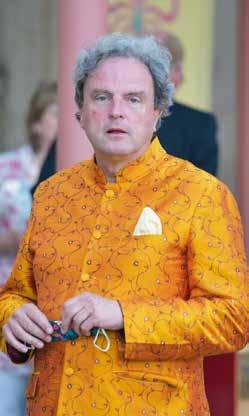
 Artistic Director
CBE
Michael Chance
© Clive Barda
Artistic Director
CBE
Michael Chance
© Clive Barda
“I am constantly humbled by quite how large a range of talents it takes to put on a high quality festival with opera at its heart, and how much everybody steps up far beyond the call of duty to ensure that it is so”



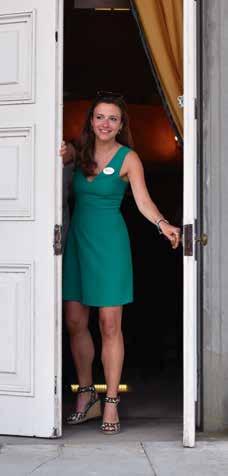

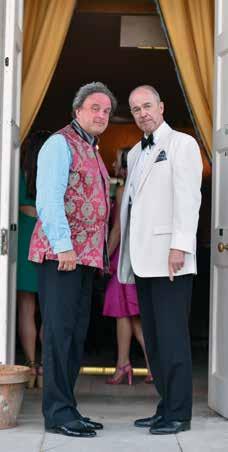

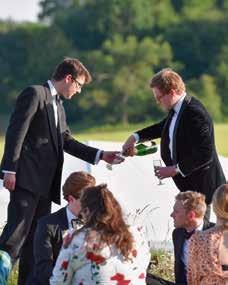
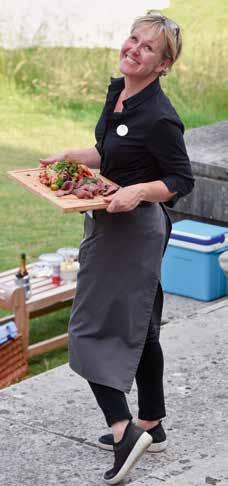







As the new Chair, stepping into Charles HaddonCave’s rather large shoes, I would like to wish all of you a very warm welcome to the 2022 Festival.
Over the last couple of years, the twists and turns of the pandemic have made it hard to predict prevailing conditions for putting on public performances. At the end of last season, we could not be sure of any return to normality in time for this year, but as I write, the clouds have lifted and we have before us the prospect of a season unburdened by any COVID restrictions.
And what a season it promises to be. As always, Michael Chance has deftly assembled a mixture of works that are exciting, intriguing and offer a real breadth of appeal. One of the hallmarks of the Grange is that whilst opera is at heart of the Festival, we aim to offer a varied musical feast, and the 2022 season is no exception. Opening this year, we have Verdi’s Macbeth and Handel’s Tamerlano. Both have scores that are enthralling and drama that is sure to keep awake even the most somnambulant opera-goer! This year we also make our first move into Gilbert and Sullivan territory, with an innovative production of The Yeomen of the Guard. Later in the season, we have an outstanding evening with the formidable US jazz trio of Marcus Roberts playing with the BSO. Bringing the Festival to a conclusion will be the world premiere of a fabulous dance and opera programme, Clorinda Agonistes, incorporating the revolutionary dramatic cantata of Monteverdi and a contemporary version from composer Kareem Roustom. The complimentary first half is supplied by the ground-breaking dance company New English Ballet Theatre, reprising their life-enhancing version of The Four Seasons.

These have been two very tough years for all arts organisations, The Grange Festival included. Despite
having to grapple with the pandemic, in addition to the usual slightly mad economics of country house opera, our team have managed the situation highly effectively. As a result, I believe we can look forward to the future with real confidence. Michael Chance, Michael Moody, and Rachel Pearson, with magnificent support in the office – everyone has worked together with enormous skill and dedication to keep the show on the road (or at least, in the house). However, these are precarious times and this means that we depend more than ever on the generous support of our Friends and Donors: I would like to express my heartfelt thanks for the way in which many of you have dug deeper in your pockets this year to contribute to our great endeavour.
Our ambition is to have a Festival that ranks artistically with the very best in world, but is also strongly imbued with a spirit of place. The Grange is unique in its majesty and pastoral beauty, and I hope all of you who’ve supported us in the past will continue to feel that this is something truly wonderful and worthy of your support in the future. Even though we are in the middle of the Hampshire countryside, the Grange is surprisingly accessible, and whether you are based in the capital, beyond the South, or abroad (I am pleased to say we already have established groups from the United States and Hong Kong) a visit to the Festival is a wholly viable proposition. So please tell your friends, wherever they are, and help us to build on the strong momentum the Festival has achieved in a relatively short (and interrupted) period. Exciting plans are already in place for 2023 and 2024 and beyond. Alongside opera and dance, we hope to build an established place for first-rate musicians visiting from the US in our programme, and plans will be announced soon.
“Our ambition is to have a Festival that ranks artistically with the very best in world, but is also strongly imbued with a spirit of place. The Grange is unique in its majesty and pastoral beauty”
I’m pleased to say that the stage is not the only site of creativity at The Grange Festival. On the dining front, our partnership with Becka Cooper is continuing and she has created another selection of delicious menus based on locallysourced Hampshire produce. We are of course in the middle of rampant food price inflation, and the team have tried hard to limit the impact of this, whilst maintaining quality standards.
An important objective of the Festival is have a wider impact that goes beyond our performances. Every year we offer opportunities for young conductors and singers, as well as those with a technical and creative background, to gain experience alongside the experienced teams that work on our productions. We also continue to develop our successful Education programme. Under the effective guidance of Susan Hamilton, our 2021 Future Visions project in collaboration with the World Wildlife Fund, reached over 250 young people. Ten films highlighting the work were shown successfully at the recent COP26 conference. This year we are extending our partnership with the WWF and the focus will be on food, especially relevant in environmental and social terms. We will also have a 2022 “Opera In A Week”, a continuing project that focuses on developing children’s creative confidence and self-expression. Over the next few years we are intent on expanding our efforts to broaden access to the Festival’s activities, so that an increasing number of people feel genuinely that they have a stake in The Grange Festival.
I would like to thank my fellow Trustees for their unstinting support and dedication during another eventful year. We have welcomed Caroline Greenhalgh to our ranks, and I would like to pay a special tribute to Louise Verrill, who is stepping down. Louise has done much to advance the cause of dance, and more generally has been a source of very good advice.
The smooth running of the Festival would simply not be possible without the army of our Volunteers who contribute their time so generously. A big thank you to them, and also to the staff working in the bar, the marquees, the restaurant and behind scenes, who I know will be working to make your visit a memorable one.
Finally, the success of The Grange Festival will always depend on a close partnership with the Ashburton family, and Mark and Sophie, Lord and Lady Ashburton, have been sterling in their support. Their enthusiasm, as well as the contribution they make on many different levels, is very much appreciated.
And of course, there could be no Festival without you, our audience. Thank you once again for your support, and I hope you enjoy the magic of another Grange season.

Tim Parker
The Grange Festival Chairman
TimParker, The Grange Festival Chairman
“There could be no Festival without you, our audience. Thank you once again”
Bournemouth Symphony Orchestra is thrilled to be returning to The Grange Festival this season. Each year the festival marks a real highlight in the BSO’s calendar and the partnership represents not only the highest shared artistic ambition, but also one of mutual respect and camaraderie. As we’ve collectively navigated events of the past two years in conjunction with audiences, we’ve been reminded of the transformational power of the live experience and its ability to help us all to find moments of escapism – and we can’t wait to share it with you this summer.
The BSO ordinarily gives in excess of 100 symphonic performances each year throughout the South and South West. The full operatic productions at The Grange, are a treat not just for audiences, but our musicians too, and the season marks a welcome conclusion to our orchestral year. As well as what will likely be stand-out productions of Macbeth, Tamerlano and The Yeoman of the Guard, we can’t wait for From Blues to Rhapsody, which features BSO musicians alongside the astonishing talents of the Marcus Roberts Trio and Wycliffe Gordon – it’ll be one to remember!

The BSO’s 2021/22 season has marked a return to full symphonic touring. As one of the UK’s best-loved orchestras, we’re the largest cultural provider in South West of England and give regular performances in Basingstoke, Bristol, Exeter, Portsmouth and Poole. Our new series of ‘BSO On Your Doorstep’ chamber performances has toured rural venues throughout the year, welcoming all ages back to live music, from concerts for babies to dementia-friendly Cake Concerts.
The Orchestra is known for pushing artistic boundaries and its ongoing series of symphonic music from former Soviet countries, Voices from the East, which is spearheaded by Chief Conductor Kirill Karabits, continues to gain critical praise. In recent months, as we’ve seen audiences on their feet in celebration of music from Kirill’s native Ukraine, the shared artistic journey through this symphonic music has never felt more relevant in connecting people from different backgrounds together in a united and compassionate experience.

Our livestreamed performances – which were born in lockdown, when the BSO made history as one of the first British orchestras to return to the stage, and have featured Sir John Eliot Gardiner, Benjamin Grosvenor and Alina Ibragimova – continue to receive critical praise. Amongst the many wonderful guest artists we’ve welcomed during the last year, Horn player Felix Klieser made a particularly huge impression when he gave a memorable UK concerto debut in November, and we’re thrilled he’s our Artist-in-Residence for two years.
Ever committed to new music, the Orchestra has celebrated a triptych of pieces written by women this season, with performances of new works by Carmen Ho, Franghiz Ali-Zadeh and Elizabeth Ogonek. Earlier in the pandemic, the BSO also gave premieres by composers Shirley J. Thompson OBE and Magnus Lindberg.

We remain unrelenting in our ambition to ensure access to high-quality music for all. This spring we launched two nine-month bursary-supported placements for aspiring community music leaders, and, in May, BSO Resound – the world’s first disabledled ensemble at the core of a major orchestra – unites with the National Open Youth Orchestra as the inclusive youth orchestra presents its debut series.
Whether you’re coming to these performances this season for a treat and a few hours of escapism, or to witness astonishing talent whilst supporting these committed artists and this wonderful festival, we can’t wait to share it all with you. As we look to the future, I’m sure I’m not the only one who is grateful to be returning as we reflect amidst the magnificent atmosphere of The Grange Festival, united in the live experience. Enjoy! bsolive.com
Chief Conductor Kirill Karabits Principal Guest Conductor Mark WigglesworthOn a glorious afternoon last September, over 250 young people, teachers, friends and patrons filled the Grange Festival Theatre to celebrate the culmination of our Future Visions project. With BBC South on site to capture the moment, the excitement was electric as the films were screened for the first time.
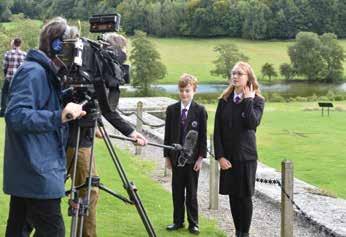

For anyone who didn’t follow Future Visions, it was our 2021 youth workshop programme which was of particular significance taking place when Covid restrictions were still in place and most young people had not been able to enjoy in-person activities for over a year.
Perhaps it was this singular set of circumstances that evoked such an incredibly powerful response. Or perhaps it was the impact brought to bear by the subject matter and our exceptional project partners – WWF. Whatever it was, each of the ten teams involved exceeded all expectations as they worked with our own professional creative experts to develop responses to WWF’s briefings on global environmental issues.
The output was a series of original songs, expressing each team’s collective ideas and hopes for a more sustainable planet. These songs were performed, filmed, produced and – back to our glorious afternoon last September –presented to our community by WWF’s Education Manager, Matt Larsen-Daw and Director Karen Gillingham, with input from each team.
If you haven’t already done so, please do watch the films on our website thegrangefestival.co.uk/ learning-at-the-grange/future-visions/

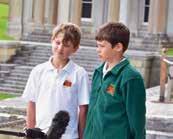

What was achieved was truly remarkable. These thought provoking and sometimes shocking films went on to be shown at COP26 in Glasgow in November, where they were praised for their creative impact and powerful message.

This Spring we have continued our inspirational collaboration with WWF, this time focusing on Food Sustainability, examining how we produce, eat and often waste our food. Our partner Basingstoke schools, together with a creative team, have once again responded and expressed their thoughts in their own songs. Look out for their films which will be released this summer.




“The Future Visions project came at just the right time. These young people, emerging from a lockdown (which will seem utterly unreal when they look back as adults) were given a chance to articulate their passion for creating a better future. I doubt that our students could have imagined the quality performance they actually produced”
Head Teacher Cranbourne School, BasingstokePLANET FOOD
“Most of us might believe it’s our energy or transport choices that cause the most serious environmental damage. In fact, it’s our food system that creates the biggest impact”
Dr Tony Juniper WWF



We are thrilled to announce that this August, we will welcome over 80 young people (aged 10 to 15 years) to the Grange, who together, will take on the hugely ambitious challenge of writing, composing, designing, rehearsing and then performing their own original contemporary opera on our stage. All in just five days! Please come and see their final piece on Friday 26 August, 6-7pm (details on our website).
During the season, over 250 children will take part in our school’s insight workshops before joining us for The Yeomen of the Guard. We also throw open our doors to aspiring young dancers who will watch a special matinee of New English Ballet Theatre’s performance of The Four Seasons. For many this will be the first time they will have experienced a professional production and been inside our wonderful theatre.
“I enjoyed when we had to work in small groups and be creative”
Year 9 Student
“The skills children need for life are obvious – we just need to teach them”
Times Education Commission

The last two years of lockdown and isolation have taught us the value of strong partnerships with like-minded organisations and educational institutions, as a way of broadening our reach and increasing our impact. In addition, we have seen the opportunities that digital engagement has to offer, breaking down geographical and social barriers, and opening up a magnitude of possibilities.
Learning@TheGrange is committed to offering an innovative and inventive learning programme. Our devising projects are designed to give young people the helm; to encourage collective and individual decision making, critical and imaginative problem solving.
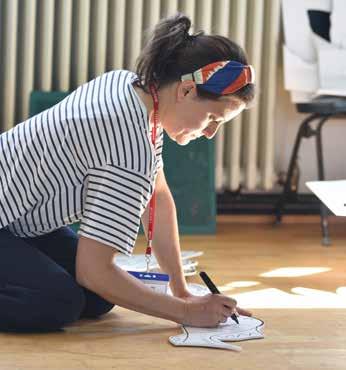
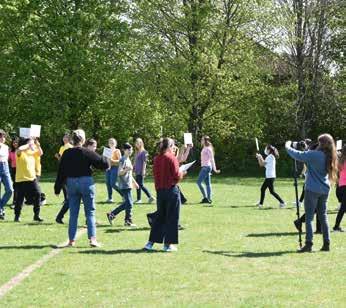

Using the creative and performing arts as our tool, our programming will continue to focus on giving our youngsters artistic ownership and, in doing so, to help them build the life skills and resilience they need to navigate the complex and uncertain future they are likely to experience.
 Susan Hamilton Director of Learning, The Grange Festival
Susan Hamilton Director of Learning, The Grange Festival
“Children need the arts like they need sunshine. They are as important as maths”
Sir Anthony Seldon
“I felt like I had the right to speak out loud”
Year 7 student








The Grange Festival exists to bring the inspiration of the performing arts to The Grange in Hampshire. Year-round we also work in our community with a programme of outreach and education that is featured in detail elsewhere in this programme. Inspiring music lovers of the future and supporting young artists in the early years of their careers are an important part of our work. The fundamental objectives are to be world class in all we do, and to be sustainable over the long term.
Ticket sales cover half of the annual income we require leaving us to raise in excess of £1.5m each year. There are many ways in which we can be generously supported.
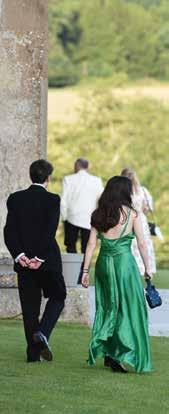
It is the Festival Founders who will help secure the brightest of futures for our theatre as we evolve into a hub of cultural excellence, attracting an audience from around the globe.
Founders are invited to develop a bespoke and ongoing relationship with The Grange Festival and all its varied artistic activities. We hope you will join us and take this unique opportunity to be a part of this journey.
SAMWELL FOUNDER £100,000
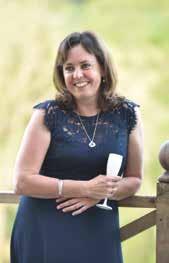
Benefit Price £1770 | Suggested Voluntary Donation £98,230
In 1665 William Samwell is commissioned to design the original red brick mansion.
Tax efficient giving means this can cost the donor just £55,797
WILKINS FOUNDER £50,000

Benefit Price £1770 | Suggested Voluntary Donation £48,230
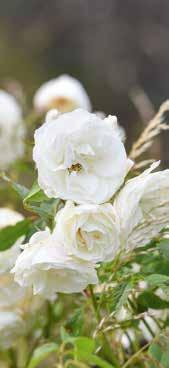
In c1804 William Wilkins turns the Samwell house into a Greek Temple.
Tax efficient giving means this can cost the donor just £28,297
COCKERELL FOUNDER £25,000
Benefit Price £1,080 | Suggested Voluntary Donation £23,920
In c1823 Charles Cockerell builds the orangery as a Greek Temple.
Tax efficient giving means this can cost the donor just £14,236
Our annual Festival Friends underpin each festival and are essential to sustaining the high quality of our operas. Friends have access to priority booking and play a crucial part in making the Festival happen. Ticket income covers only half of the cost of each production, so we depend on our Friends’ generosity to help fill the gap. After this challenging year, we hope our Friends will continue to be as generous as they can in supporting us. Please spread the word – we can never have too many friends.
We invite Wings upwards to pay by annual auto renew or by monthly or quarterly standing order. Contact info@thegrangefestival.co.uk for more detail.

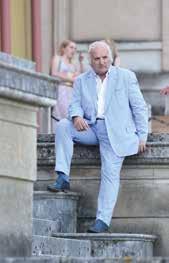
THE SWEET SPOT £5,500
Every stage has that unique place that projects the voice perfectly and produces a quality of sound to tickle the hairs on the back of your neck.
Benefit Price £115 | Suggested Voluntary Donation £5,385
THE LIMELIGHT £2,750
Before electricity, theatres produced intense light by directing a flame at a cylinder of quicklime.
Benefit Price £90 | Suggested Voluntary Donation £2,660
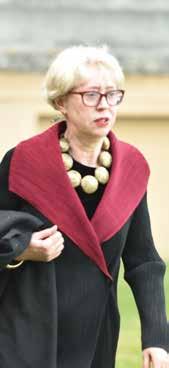
THE PROMPT CORNER £1,100
Every theatre needs one. Without this, it may not be alright on the night.
Benefit Price £60 | Suggested Voluntary Donation £1,040

THE ROSTRUM £600
The birds eye view and position of power guiding orchestra with a flick of the wrist.
Benefit Price £40 | Suggested Voluntary Donation £560
THE WINGS £300
It’s all happening here in the secret, silent world. Prop tables are ready, quick changes are prepared, the crew are primed, the cast are awaiting their cues.
Benefit Price £30 | Suggested Voluntary Donation £270
THE FOOTLIGHTS £50
The original theatre lighting: once upon a time as candles, now used as a special effect.
Benefit Price £10 | Suggested Voluntary Donation £40
THE HIGHFLYERS (18–35s only) £20
Traditional Scenery operators worked on the fly walks high above the stage.
Benefit Price £20


Bringing world class Dance and Ballet to this romantic corner of Hampshire is a unique and important development. We are seeking Corps de Ballet Pioneers to help us: a group of generous individuals who will be at the start of something remarkable and be part of its development. Commitment to something new and imaginative like this, which promises to become a high-profile part of the national performing arts scene, is philanthropy with far-reaching consequences in an appropriately inspiring setting.
This year Shobana Jeyasingh Dance have chosen The Grange for the start of their worldwide tour and next summer the Mark Morris Dance Company will start their world wide tour here at The Grange before a European tour. We could not do this without the support of our Corps de Ballet Pioneers. Suggested gifts from £5000
We focus on two areas. First, we offer a range of scholarships and assistant roles to help develop young talent in all those areas of expertise that go into staging a show – singers, conductors and behind the scenes technicians. Secondly, we are working with many schools delivering creative projects during the year that take pupils beyond the confines of the school curriculum. We are currently working in schools and educational organisations on a creative project leading up to COP27 this autumn. Up to 250 children will be invited to consider the challenges of climate change, the future of their planet and how we can live better in harmony with nature. Their creative ideas will be expressed in songs of their own devising that will be filmed and submitted to COP27. Much more about this project can be found on pages 10–13. We seek gifts of all sizes
We invite companies to support a production or sponsor a single performance during the season. The Grange is an astonishingly beautiful setting and we take great care to ensure any visit you make is perfect from the moment you arrive. Support comes with a range of opportunities. We will even bring a singer to your Christmas or Summer Party.
This is a perfect way to acknowledge your appreciation of the theatre or recognise someone else who has loved this place. Your gift will be acknowledged with a plaque of your wording on the seat. Suggested gift according to seating area £250, £500 and £1000
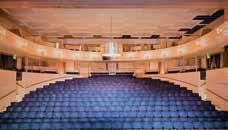
Your support for a particular role of your choice enables us to cast performers of the highest standard and makes a real contribution to the overall production.
If you would like to hear more about any of these initiatives please contact Rachel Pearson, Director of Development. Email: rachel@thegrangefestival.co.uk Tel: 01962 792201 / 01962 791020



Have you enjoyed your summer evenings at The Grange?
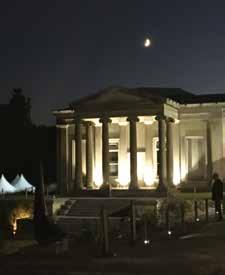
If you have, please consider helping us with a legacy gift. Opera companies the world over need to raise funds to continue to stage memorable productions. We are no exception, and there is so much more going on behind the scenes…

We mentor young arts professionals on their career paths. In schools and colleges we work with all ages to inspire creativity, innovative thinking and expression through music and words, often in schools with little or no non-examined arts activity in the timetable. Last year the filmed output of this creativity was taken to COP26. Participation in creative activity is a life pleasure with far reaching personal benefits that should be available to all.
The peacock is the ancient symbol of immortality. By joining our Festival Peacocks you will play your part in making something wonderful happen each year for so many people of all ages. If you do decide to join our glorious Pride of Peacocks please let us know so that we can show our gratitude and celebrate with you.



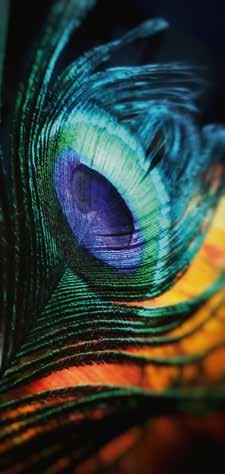
Legacies are highly tax efficient. The Grange Festival is a charity (No 1165859) and any gifts of cash, shares or property can be an important way to reduce your tax liability, while at the same time helping secure the future of a place you have loved. Your solicitor can help you with any detail and we can provide a codicil form for your will.
Contact Rachel Pearson rachel@thegrangefestival.co.uk for more information.

Delfont Mackintosh Theatres
The Linbury Trust
Edward and Antonia
Cumming-Bruce
Sir Vernon & Lady Ellis
Catherine & Jón Ferrier
Mr & Mrs James Fisher
Marveen & Graham Flack
Tom & Sarah Floyd
Susie, Katie, Anna, Christina & Hwfa Gwyn
Sir Charles & Lady
Haddon-Cave
Rumiko Hasegawa
James & Rhona Hatchley
Sheelin & John Hemsley
Malcolm Herring
Charles & Catherine Hindson
Herman & Claire Hintzen
Roger & Kate Holmes
Adrian Hope
David & Patricia Houghton
Howard & Anne Hyman
Owen & Jane Jonathan
J Paul Getty Jnr
Charitable Trust
Claudia Langdon & Janie Cadbury
Thomas & Alexandra Loyd
The Peter & Elisabetta
Mallinson Trust

Simon & Nathalie
Marshall-Lockyer
Nigel & Anna McNair Scott
Joanna & Luke Meynell
Patrick Mitford-Slade
Martin & Caroline Moore
The Ogilvie Thompson Family
William & Francheska
Pattisson
Mark & Rachel Pearson
Lord & Lady Phillimore
Jonathan & Gillian Pickering
Ernst & Elisabeth Piech

Michael & Sue Pragnell
John & Erica Simpson
Graeme & Sue Sloan
Dr Helmut & Anna Sohmen
Judy & Graham Staples
Tim & Charlotte Syder
The Stevenston Trust
Mr Peter Stewart Tilley
Anonymous
Lou & John Verrill
Andrew & Tracy Wickham & anonymous donors
Peter & Rosemary Andreae
David & Elizabeth Benson
Anthony & Consuelo Brooke
Rex & Sarah Chester
Ina De & James Spicer
Domenica Dunne
Robina & Alastair Farley
For Elise
Peter & Judith Foy
Malcolm Herring
Peter & Sue Holland
The Hollingberry Family
Graham & Amanda Hutton
David & Penny Kempton
Tammy Lavarello
Charles & Sue Marriott
James & Caroline Masterton
Martin & Caroline Moore
Mr & Mrs Jonathan Moseley
Colin Murray
Roger & Virginia Phillimore
Jonathan & Gillian Pickering
Bianca & Stuart Roden
Giles & SueSchofield
David & Alexandra Scholey
Sophie Service
Paul & Rita Skinner
The Band Trust
Peter Tilley Esq
Isla Baring OAM
Tom & Gay Bartlam
Beaulieu Beaufort Foundation
Simon & Rebecca Bladon
Simon & Julia Boadle
Anthoy & Sarah Boswood
Michel & Belinda Boyd
Britwell Trust
Julian & Jenny Cazalet
Julia Chute
Colwinston Chartiable Trust
Henrietta Corbett
Corin & Richard Cotton
Carl Cullingford
Edward & Antonia
Cumming-Bruce
The de Brye Charitable Trust
Michael & Anthea Del Mar
Mrs Marveen Flack
Gamlen
The Roger
Annette Oakes
The Ogilvie Thompson Family
Kevin Pakenham
David & Sarah Parker
Deborah & Clive Parritt
The Countess of Portsmouth
Richard & Iona Priestley
George & Veronique Seligman
Rebecca Shelley
Brian Spiby
Fiona & Geoff Squire OBE
Clare & Richard Staughton
The Bernard Sunley
Charitable Foundation
Robert & Tiggy Sutton
Alison & Simon Taylor
Peter & Nancy Thompson
The Worshipful Company of Dyers
Management
Cazenove Capital
Charles Stanley Wealth Managers

Country Life
Hawksmoor Investment Management
Hiscox
Hunters Solicitors
IG Group
Meggitt PLC
Norton Rose Fulbright LLP
Sarasin & Partners
Stifel
The Zygos Partnership
Adam Architecture Architectural Plants
Burrells
Chalke Valley History Festival
Christies
Danebury Vineyards
Dorset Opera Festival

English Heritage
Farrow & Ball
Gosset Champagne
Jamb
Kirker Music Holidays
Lime Wood Hotel
Longborough Festival Opera
Martin & Company
Moda Rosa
Opus
Ottoman Silks
Pathé News
Provident Financial
Regents Park Open Air Theatre
Saffery Champness
Stone, Vine & Sun
Wine Merchants
Taylor Fladgate
The Grange Estate
West Green Opera

Nigel Beale & Anthony Lowrey
Simon & Sally Borrows
Ernst & Elisabeth Piech
Joanna Selborne & anonymous donors
Nick & Sarah Allan
Robin & Anne Baring
Robert & Caroline
Bordeaux-Groult
Lord & Lady Bridges
Mrs Charles H. Brown
Julian & Jenny Cazalet
Julian Chadwick
Rex & Sarah Chester
Seawall Trust
Sir Christopher & the Reverend Lady Clarke

Michael & Anthea Del Mar
Robert & Pirjo Gardiner
Dr Hugh Laing
James & Béatrice Lupton
Dr & Mrs Jonathan Moore
Rupert & Elizabeth Nabarro
Nick & Julie Parker
Lady Plastow
The Countess of Portsmouth
James & Judy Scott
George & Veronique Seligman
Robin & Sarah Thorne
Marion Wake & anonymous donors
Georgina Agnew
Charles & Clare Alexander
Boo & Bill Andrewes
The Hon Mrs Susan Baring, OBE
Geoffrey Barnett
Peter & Valerie Bedford
Julian & Jane Benson
Anthony & Emma Bird
Jonathan & Karen Bourne-May
Nick & Sue Brougham
Mark Burrows
Tom Busher & Elizabeth Benson
Michael & Linda Campbell
Jane Clarke
Oliver Colman
Lin & Ken Craig
Pru de Lavison
The Viscount Dilhorne & Professor S J Eykyn
FRCS FRCP FRCPath
Howard & Donna Dyer
Tim & Rosie Forbes
Lindsey Gardener
Richard & Judy Haes
Linda & Peter Hollins
Sue Humphrey
Andrew & Kay Hunter Johnston
Michel Kallipetis QC
Diane Katsiaficas
Mr & Mrs Patrick Hofmann
David & Mary Laing
Anne Longden
The McLaren Trust
Peter & Brigid McManus
Antony & Alison Milford
Michelle Nevers & Nathan Moss
David & Angela Moss
Guy & Sarah Norrie
Peter & Poppity Nutting
Dr Cecily O’Neill
Charles Parker
Sir Desmond & Lady
Norma Pitcher
Hugh Priestley
Jean Boney & Chrissie Quayle
The Hon Philip Remnant CBE
Stephen Riley & Victoria Burch
James & Lygo Roberts
Andy Rogers & Stuart O’Donnell
Kristina Rogge
Alicia Salter
Ginny & Richard Salter
Alex & So Scott-Barrett
Nigel Silby
Martin & Michaela Tod
John & Pauline Tremlett
Peter & Sarah Vey
Mr Niko Vidovich
Edward & Katherine Wake
Johanna Waterous CBE & Roger Parry CBE
Mary Rose & Charles Wood & anonymous donors
David & Jane Anderson
Louise Baird
Richard Baker
Val & Christopher Bateman
Mrs Rupert Beaumont
Adrian Berrill-Cox
Graham & Julia Bourne
Julie Bradshaw
Viscount & Viscountess
Bridgeman
Adam & Sarah Broke
Hugh & Sue Brown
Geoffrey Burnand
Richard Butler Adams
Mrs Maurice Buxton
Peter & Auriol Byrne
Frances Carver
Jane Countess of Clarendon
Ian Clarkson & Richard
Morris, & David Morris
Dr Neville Conway
Anthony & Daryll Cooke
David & Nikki Cowley
Johnny & Liz Cowper-Coles
Lady Curtis
Baron & Baroness de Styrcea
Patrick & Nikki Despard
Dr Graham & Janna Dudding
Christopher & Jenny Duffett
Christina & Andrew Dykes
Martin & Rachel Ellis
Alun & Bridget Evans
Felicity Fairbairn
Roger Fawcett
Simon & Hilke Fisher
Iris Dell’Acqua & Alex Fisher
Michael Fitzgerald
Mr & Mrs John Foster
The Collins Family
William Gething
Anne Giles
Martin & Jacky Gillie
David & Bridget Glasgow
Jenny Gove
Jane & Charlie Graham
Mr Robin & The Hon
Mrs Greenwood
Alistair & Jenny Groom
Max & Catherine Hadfield
Edward & Rosie Harford
Wendell & Andrea Harris
Guinevere & Julian Harvey
Rob & Anne Heather
Jenny & Bill Helfrecht
Christopher & Jo
Holdsworth Hunt
David & Mal Hope-Mason
Stephen Howis
Shoonagh Hubble
Iain & Claudia Hughes
Diane Hume
Peter & Morag James
Margi & Mike Jennings
John & Sara Jervoise
Anthony Johnson & Terence Drew
Nigel & Cathy Johnson-Hill
Michael & Julia Kerby
Stephen & Miriam Kramer
Mr & Mrs Bill Lawes
James & Jan Lawrie
Roger & Natalie Lee
Nicky Levy
Derek & Susie Lintott
Ian & Jane Macnabb
Bill & Sue Main
Brian & Bernadette Metters
Paul & Emily Michael
Mr & Mrs Hallam Mills
Kate & Malcolm Moir
David & Alison Moore-Gwyn
Diana & Nigel Morris
Ian & Jane Morrison
Roy & Carole Oldham
(this is how they always wish to appear)
Lavinia & Nick Owen
Peter & Sue Paice
John A Paine
Erik Penser
Caroline Perry
Robin & Christine Petherick
Mr & Mrs Julio Pinna-Griffith
James & Kate Plastow
John & Elizabeth Platt
John & Judy Polak
Dr. Victoria Preston
Catherine Rainey
John Raymond
Dr Martin Read & Dr
Marian Gilbart Read
Jane Ridley & Jeffrey Thomas
Miles & Vivian Roberts
Julian & Catherine Roskill
Dr Angela Gallop CBE & Mr David Russell
Charles & Caroline Scott
Rupert & Charlotte S-M
Tom & Phillis Sharpe
Diane & Christopher Sheridan
David & Di Sommerville
David & Unni Spiller
Marcus & Sarah Stanton
Richard & Clare Staughton
Caroline Steane
Mr & Mrs Nicholas Stranks
Mr & Mrs P M Thomas
Elaine & James Tickell
George & Lucinda Tindley
Prof & Mrs G M Tonge
Professor Michael & Dame Jenifer Trimble
Sir Tom & Lady Troubridge
Clive & Tessa Tulloch
Sandra & Paul Walker
David & Meriel Walton
Penelope Williams
James & Sarah Williams
Louise Woods & anonymous donors

Mrs Philippa
Daphne
Chris
Charles & Victoria Arthur
Mary & Julian Ashby
Dr Richard Ashton
Julie & Keith Attfield
Dr Simon Bailey
Caroline Barber
Cara & Oliver Barnes
Paul & Janet Batchelor
Anne Beckwith-Smith
Mike & Sarah Bignell
Daphne Birch
Charles & Ann Bonney
Mrs Sheila Gay Bradley
Dr Douglas & Mrs Susan Bridgewater
Charles & Patricia Brims
Alison & Michael Brindle QC
Penny & Robin Broadhurst
Robin & Jill Broadley
Tony & Mo Brooking
George Brown & Alison Calver
David Buchler
Mrs Thomas Buckley
Christopher Burbidge
Hon Mrs Alastair Campbell
Mr & Ms Nicholas Carter
Belinda & Jason Chaffer
Suzie Chesham
Julian & Josephine Chisholm
Monique Clowes
Mrs Laurence Colchester
Michael & Virginia Collett
Dr & Mrs Peter Collins
Gill Collymore
Michael & Elizabeth Combe
Henrietta Cooke
Tim & Penny Cooper
Richard & Sindy Coppin
Morella & Robert Cottam
Jenefer Coulton
Julia & Stephen Crompton
Edward & Antonia Cumming-Bruce
Peter & Pamela Davidson
James & Liz Davis
Mike & Suzette Davis
Anne & Jonathan Dawson
Sir John & Lady de Trafford
Elizabeth Dean
Linda & Hugo Deschampsneufs
Hugh & Christina Dumas
Cathy Dumelow
Sir James Eadie
James Ekins
Robert & Mary Elkington
Julia P Ellis
John Farr
Elaine Fear & Sol Mead
Nicholas & Jane Ferguson
The Fischer Fund
Andrew & Lucinda Fleming
Jules & Jonathan Flory
J A Floyd Charitable Trust

Lindsay & Robin Fox
Rod & Marie Franks
Andrea Frears
Anton Gabszewicz & Mark Gutteridge
Michael & Diane Gibbons
C F Gibbs
Brett & Caroline Gill
Dr Asher Giora
Nicholas & Holly Gold
Philippa & Charlie Goodall
Gill Graham Maw
Susie Grandfield
Robert B Gray
Mike & Stephanie Gretton
Felicity Guinness & Simon Ricketts
Gilbert & Vahideh Hall
Maggie Heath
David & Odette Henderson
John & Catherine Hickman
Michael & Geneviève Higgin
Will & Janine Hillary
Alan Hoaksey
Mr & Mrs I F Hodgson
H R Holland
Barnabas & Campie
Hurst-Bannister
Tim & Christine Ingram
Anthony & Jenny Isaacs
Allan & Rachel James
John & Jan Jarvis
Scot & Sally Johnston
Penelope Kellie
Martin & Clare Knight
Dr & Mrs S Knights
Beth & Peter Lamb
John & Joanna Lang
Simon & Sarah Lavers
Caroline & David Lentaigne
Anthony & Fiona Littlejohn
Gussy, the Theatre Cat
James & Susie Long
Mrs. Fiona Lunch
Imogen Lyndon Skeggs
Pamela & Peter Macklin
JJ & Victoria Macnamara
Mrs Jennifer Makins
Andrew Marchant
Frances Marsden
Paddy & Polly
Paul McKeown
Nigel & Maria Melville
Sarah & David Melville
Colin Menzies
Mrs Primrose Metcalf
Christopher Morcom QC & Mrs Diane Morcom
Simon & Fiona Mortimore
Margot Mouat
Mr & Mrs John Muncey
Christopher Napier
Anthony & Jenny Newhouse
Charles & Martie Nicholson
Lady Bridget Nixon
Steve Norris
Lord & Lady Northbrook
John & Dianne Norton
Denise Osborn
Colin & Rosalind Osmer
Robin Pauley
Sally Payton
Lucy Pease
Robin & Sylvia Peile
Richard & Michelle Pelly
Ed & Sarah Peppiatt
Jeremy & Bryony Pett
Professor Postma
Richard & Iona Priestley
Mr Simon & Lady Julia
Prior-Palmer
Anthony & Trish Proctor
Charles & Tineke Pugh
Tony & Etta Pullinger
Christopher & Phillida Purvis
Jane & Graham Reddish
Tineke Dales
Dr Lynne Ridler-Wall
The Rev’ds Tana & Royston Riviere
James & Catharine Robertson
Annie Robertson
Alan Sainer
Simon & Abigail Sargent
Richard & Jackie Scopes
Mr & Mrs Charles Scott
Tom Seabrook
Katherine Sellon
Mary & Thoss Shearer
Julian & Carolyn Sheffield
David & Rebecca Sheppard
Christopher & Lucie Sims
Jock & Annie Slater
Ann Smart
Miriam Smith
Dr Anthony & Mrs
Daphne Smoker
Lady Snyder
Andrew & Jill Soundy
John & Margo Stephens
Brian & Henrietta Stevens
Jeremy & Phyllida Stoke
Mrs Patricia Taylor
Tom & Jo Taylor
Jeremy H Taylor & Raye Ward
Mr & Mrs Roger ter Haar
Hugh & Sandy Thomas
Rupert Villers
Anthony & Sue Walker
Mrs Jane Wallace
Sonia & Kevin Watson
Peter & Alexandra White
Tony & Fiona White
Jane Williams
Keith & Keren Williams
Louise Williams
Hamish & Elisabeth Williams
Peter & Lissa Wilson
Jilly Wise
William & Celia Witts
Richard & Noely Worthington & anonymous donors
Mrs Linda Albin
Jean Anderson
Dr Martin T Anthony
Mrs Martin Arkwright
M D Austen
Mrs Claire Baker
Katie Barnes
Keith Barnes
Mr & Mrs Simon Barrow
Mr & Mrs David Barrow
Mr & Mrs Bartholomew Sefi
Mr & Mrs D Bartle
Michael & Carolyn Bartlett
Isla Baxter
Michael Biddle
Tim Bishop & Ian Louden
Juliet Blackburn
Charles Blackburn
Janet Bonthron
David & Diana Briggs
Mr & Mrs J M Britton
Charles & Amanda Bromfield
Jane & Henry Brown
Anne Bulford CBE & David Smith
Russell Burdekin
Sandra Carlisle & Angus Carlill
Jim Carroll
Mrs B Carter
Mr Charles-Edouard Castella
Guy Chapman
Neil Chrimes
Caroline Clark
Henry & Louise Clay
The Clemson Family
Tim Cockerill
Richard & Verity Coleman
Prof. Richard Collin
Rosie & Derek Collinson
Elisabeth Colquhoun
Roseanne Corlett
Diana Cornish
Philippa Crosse & Simon Hopkins
David & Peta Crowther
Jill Cundy & Alan Padbury
Mr & Mrs Jerome Davidson
Mr Peter Davidson
ln memory of Ann Dussek
Diana & Nick Edwards
Mark & Margaret Edwards
Mr & Mrs John Ellard
Roger & Ruth Facer
Kristina Fearnley
Olivia Fetherston-Dilke
Giles & ’Wenna Fletcher
David & Elizabeth French
N J Gammon
James & Valerie Garrow
Virginia Gayner
Carol Geddes
Jane Skelton & Richard
Geoghegan
Kate & Barry Goodchild
Colin & Letts Goodwin
Sam & Jane Gordon Clark
Dr Stephen Goss
Mr & Mrs M Griffin
Gareth Hadley
Mr & Mrs Tichy
Dilys Hall
John & Margaret Hall
A J Halsey
Ian Hamilton
Judith & David Hankinson
J M Hardigg
Susanna Hardman
Mr & Mrs Hayman
Helen & Philip Heims
Peter Hildebrand
Philip & Wendy Hill
Penelope Horner
Peter & Kate Horrocks
Jane Hough
Colin & Irene House
Glenn Hurstfield &
David de Jager
The Allenby sisters
Chris Jefferies
Neil & Elizabeth Johnson
The Johnson Family
Alison & Jamie Justham
Mae Keary
John & Jennifer Kelly
Omar Khan
Oliver & Sally Kinsey
Oliver & Victoria Larminie
Jane Lavers
Harry Le May
Shaun Le Picq
Sue Leach
John Learmonth
Lynn Lee
Carola & Adam Lee
Jan Leigh & Jan Rynkiewicz
Ben & Tom Linton-Todd
James & Samantha Livingston
Michael Llewellyn
V Lowings & B Cozens
Roger Lowman
Tim & Rosanne Lowry
Victoria Mackintosh
Catherine Maddock
Louise Matlock
Julia Maxlow-Tomlinson
Nicky Maxted
Christopher & Stella Maybury
Dr Tom McClintock
Mr & Mrs James McGill
John McVittie
Stephen Meldrum
Judith & Theo Mezger
Elaine & Peter Mills
Drs Lynette & David Moss
Sally & David Murch
Stephen & Fiona Murray
Christabel Myers
Penny Neary
Alison Nicol
Steven & Hilary Oldham
Sue & Ken Osman
Stephen & Isobel Parkinson
Colin & Judy Patrick
Stephen Peach
Peers of Alresford
Mr & Mrs Penfold
David Pether & Darin Stickley
Anthony & Sally Pfiffner
Mr Robert Phillips
Christopher Pilkington
Fiona Pitcher
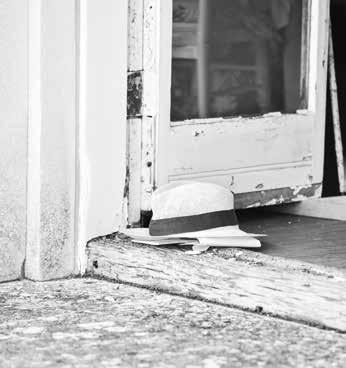
Geoffrey & Jan Planer
Nigel & Vicky Prescot
Mr & Mrs Pugh
Stephen Purse
Miss Mary Rackham
Dr John Rea
Florence & Robert Rice
Mr P & Mrs K Richards
Dick Richmond

Xavier & Alicia Robert
Nerys Roberts
Roger & Geraldine Robinson
James & Sue Robinson
Deborah Roslund
Mr & Mrs Jeremy Rothman
Madi & David Laurence
Mr Peter Saunders & Mrs
Jeannine Lindt Saunders
Michael Saunderson
Ian & Rosemary Saxton
Caroline & Mark Silver
Gill & Barry Smith
The Shenker Smiths
John Stanning
Dianne Steele
Kate Mather
Marilyn Stock
Fiona & Toby Stubbs
Sir John & Lady Stuttard
Della & Sheridan Swallow
Canon Ron & Dr Celia Swan
Swift Family
Ian & Belinda Taylor
David Templeman
Jeffrey & Jane Theaker
Sue Thomas
David & Joanna Thomas
Jonathan Thompson
Michael & Cara Thomson
John & Christine Thornton
Di Threlfall
Mark Tousey
Toyne-Sewells
Tara Ackroyd
Aurea Baring
Flora Baring
Fred Baring
Nathaniel Barker
Alice Blincoe & Luke Newsome
Danielle Brown
Leonora Campbell
Mr & Mrs Jamie Criswell
Florence Cross
The Reverend Thomas Crowley
Dr Olivia Cundy
Hugo Dale-Rivas
Emiliana Damiani
Lucy Taylor, Rebecca Bonini, Amy & Bob Mothershaw, Alexander Barr, Harriet
Freer-Smith, Constance
Freer-Smith, Nicholas
Freer-Smith, Flora Thomas, Florence Kickham, Amy Constant, Yasmin Siabi, Caitlin Griffith
Jacob Goodwin
Mr Laurence Habets
Frederick B G Hervey-Bathurst
Ms Genevieve Hudson
Miss Flora Johnston
Nicola Jones
Kenneth Law WS
Tatjana LeBoff
Claudia Da Graca Lopes
Conor K Lynch
Elizabeth Mallet
Miss C Martin
Mrs Julia McMullan
Tom & Catherine Neal
Mr E F A Pinnegar
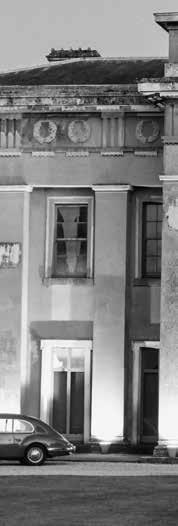
Dr Katie Plummer
Louisa Quarry
Mr & Mrs P Quarry
Ben Rands
Mr Ricci
Miss Caroline Roddis
Lucy H Rogers
Joseph Saxby
Ellie Sheahan
Dr I Smith
Imogen Spector-Hill
Nick Spiller
Drew Steanson
386 St John Household
Miss Araminta Stubbs
Dr Peter Sutton

Claire Sutton Williams
Harriet Taylor
Mr Zi Ken Toh
Linda Vogelsteller
Max Whitehead
Eleanor Wilkinson
Daniel & Thomas
Wilkinson-Horsfield
Georgia Wood & donors
When we were staring into the abyss in March and April 2020, all those many who had already bought tickets for the Festival came to our rescue in a timely and deeply moving way. We pledged to record their generosity in the theatre in perpetuity. Here you all are:
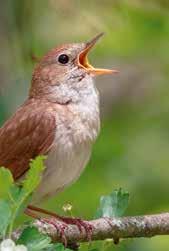
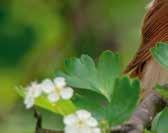

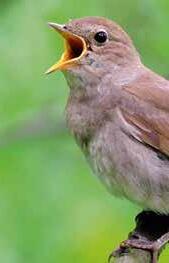

Mrs Julia Abbott
Philippa Abell
Mrs Peter Albertini
Daphne & John Alderson
Charles & Clare Alexander
Rosemary Alexander
Nick & Sarah Allan
Dr Gerhard Altmann
The Amar-Franses & Foster-Jenkins Trust
Rhian & Tony Amery
David & Jane Anderson
Peter & Rosemary Andreae
Boo & Bill Andrewes
Phillip Arnold & Ann Andrews
Mark & Sophie Ashburton
Mary & Julian Ashby
Chris & Tony Ashford
M D Austen
Dr Simon Bailey
Niven Baird
Jamie & Carolyn Balfour
Patricia Ball
Caroline Barber
The Hon Mrs Susan Baring, OBE
The Tait Memorial Trust/ Isla Baring OAM
Cara & Oliver Barnes
Geoffrey Barnett
Robin Barton
Paul & Janet Batchelor
Richard & Patricia Bayley
Nigel Beale & Anthony Lowrey
Anne Beckwith-Smith
Peter & Valerie Bedford
Michele Beiny tbc
Christina Belloc Lowndes
Glynne & Sarah Benge
David & Elizabeth Benson
Nic & Maureen Bentley
Daniel & Alison Benton
Alice & Paul Beresford
Richard & Rosamund Bernays
Mike & Sarah Bignell
Anthony & Emma Bird
Simon & Julia Boadle
Bob & Elisabeth Boas
Sophie Boden
David Bogle
Sarah & Tony Bolton
Jeremy Bonnett
Robert & Caroline Bordeaux-Groult
Anthony & Sarah Boswood
Jonathan & Karen Bourne-May
Neville & Rowena Bowen
Michael & Belinda Boyd
Robert & Fiona Boyle
Viscount & Viscountess Bridgeman
Lord & Lady Bridges
Charles & Patricia Brims
Alison & Michael Brindle QC
Penny & Robin Broadhurst
Adam & Sarah Broke
Consuelo & Anthony Brooke
Nick & Sue Brougham
Hugh & Sue Brown
Mrs Charles H. Brown
Desmond & Jennifer Browne
David Buchler
Mrs Thomas Buckley
Peter & Pamela Bulfield
Anthony Bunker
Geoffrey Burnand
Mark Burrows
Martin & Sarah Burton
Tom Busher & Elizabeth Benson
Richard Butler Adams
Peter & Auriol Byrne
Sandra Carlisle & Angus Carlill
David & Simone Caukill
Julian & Jenny Cazalet
Bernard & Caroline Cazenove
Belinda & Jason Chaffer
Suzie Chesham
Rex & Sarah Chester
John & June Chichester
Seawall Trust
Julian & Josephine Chisholm
Julia Chute
Sir Christopher & the Reverend Lady Clarke
Jane Clarke
Ian Clarkson & Richard
Morris, & David Morris
Henry & Louise Clay
Dr & Mrs Peter & Ros Claydon
Tim & Liz Coghlan
John & Suzanne Coke
Dr & Mrs Peter Collins
Gill Collymore
Oliver Colman
Dr Neville Conway
Miss Serene Cooke
Henrietta Cooke
Richard & Sindy Coppin
Diana Cornish
Corin & Richard Cotton
David & Nikki Cowley
Johnny & Liz Cowper-Coles
Lin & Ken Craig
Peter & Carole Cregeen
Julia & Stephen Crompton
Carl Cullingford
Edward & Antonia
Cumming-Bruce
Jill Cundy & Alan Padbury
Geoffrey & Ingrid Dale
Niki & Richard Dale
Josh & Anna Dale-Harris
Mr & Mrs Jerome Davidson
Peter & Pamela Davidson
Dame Nicola Davies
Anthony Davis
Ina De & James Spicer
Pru de Lavison
Baron & Baroness de Styrcea
Sir John & Lady de Trafford
Jan & Caryn de Walden
Elizabeth Dean
Michael & Anthea Del Mar
Linda & Hugo Deschampsneufs
Patrick & Nikki Despard
G & J Devlin
The Viscount Dilhorne & Professor S J Eykyn
FRCS, FRCP, FRCPath
Robert & Caroline Dixon
The Wykeham Gallery
ln memory of Ann Dussek
Howard & Donna Dyer
Christina & Andrew Dykes
Clive & Alison Earl
Paul & Pauline Eaton
Mark & Margaret Edwards
David & Jennie Wilson
David & Julie Edyvean
Julia P Ellis
Martin & Eugenia Ephson
Felicity Fairbairn
Robina & Alastair Farley
Nicholas & Jane Ferguson
Catherine & Jón Ferrier
Simon & Hilke Fisher
Giles & ’Wenna Fletcher
Tom & Sarah Floyd
Tim & Rosie Forbes
Mr & Mrs John Foster
Licia Venturi
Lindsay & Robin Fox
Peter & Judith Foy
Andrea Frears
Lucy Taylor, Rebecca Bonini, Amy & Bob Mothershaw, Alexander Barr, Harriet Freer-Smith, Constance Freer-Smith, Nicholas Freer-Smith, Flora Thomas, Florence Kickham, Amy Constant, Yasmin Siabi, Caitlin Griffith
John & Joanna French
Alan & Valerie Frost
Jonathan & Tessa Gaisman
Dame Janet & Mr John Gaymer
Michael & Diane Gibbons
Martin & Jacky Gillie
Clare & Fergus Gilmour
Dr Asher Giora
Anne Glyn
Jane & Charlie Graham
Scott & Caroline Greenhalgh
Mr & Mrs M Griffin
Tim & Jenny Guerrier
Felicity Guinness & Simon Ricketts
Mr Laurence Habets
Sir Charles & Lady
Haddon-Cave
Robert & Elizabeth Haldane
Allyson Hall
Rupert & Robin Hambro
Tom Hankinson
Edward & Rosie Harford
Wendell & Andrea Harris
Roger Harrison
James & Rhona Hatchley
Keith & Sarah Jane Haydon
Sheelin & John Hemsley
David & Odette Henderson
John & Catherine Hickman
Philip & Wendy Hill
Will & Janine Hillary
Charles & Catherine Hindson
Alan Hoaksey
Hamish & Venetia Leng
Robin Hodgson
Mr & Mrs I F Hodgson
Jenny Hodgson
Daniel & Diana Hodson
Malcolm & Mary Hogg
Christopher & Jo
Holdsworth Hunt
Peter & Sue Holland
The Hollingbery Family
Linda & Peter Hollins
Ron Holmes
Roger & Kate Holmes
Holmes Family
Jane Hough
Luke & Polly Hughes
David & Wendy Hunter
Barnabas & Campie
Hurst-Bannister

Nicholas & Deborah Hutchen
Graham & Amanda Hutton
Margaret Hyde OBE
John & Jan Jarvis
Martin & Sandra Jay
Anthony Johnson & Terence Drew
Nigel & Cathy Johnson-Hill
Owen & Jane Jonathan
Andrew & Caroline Joy
Michel Kallipetis QC
Ralph & Patricia Kanter
Diane Katsiaficas
Martin & Philippa
Kelway-Bamber
Dinah Kennedy
Kevin Kissane & Jonathan Hume
Emma Kjellin
Victoria Kleiner
Adrian Knowles
Stephen & Miriam Kramer
Dr Hugh Laing
Beth & Peter Lamb
Kenneth Law WS
Mr & Mrs Bill Lawes
Malcolm & Sarah Le May
Janet & Julian Le Patourel
Shaun Le Picq
Sue Leach
Nicky Levy
Mrs Roger Liddiard
Ben & Tom Linton-Todd
Anthony & Fiona Littlejohn
Simon Littlewood
Michael Llewellyn
Jon Long
Mr Alan Lovell
Mrs. Fiona Lunch
James & Béatrice Lupton
John MacGowan
Joe & Minnie MacHale
Pamela & Peter Macklin
Bill & Sue Main
Mrs Jennifer Makins
Charles & Sue Marriott
Chris & Clem Martin
Sue & Nigel Masters
James & Caroline Masterton
Fairhurst Estates
Louise Matlock
Harry & Emma Matovu
John & Mary Maunsell-Thomas
Ian & Clare Maurice
Alison Mayne
Mr & Mrs James McGill
Kathleen McGrady
Mrs Julia McMullan
Nigel & Anna McNair Scott
Anthony & Sarah McWhirter
Stephen Meldrum
Sarah & David Melville
Nigel & Maria Melville
Brian & Bernadette Metters
Antony & Alison Milford
Elizabeth Miller
Mr & Mrs Hallam Mills
Sylvia Mills
Patrick Mitford-Slade
Kate & Malcolm Moir
Dr & Mrs Jonathan Moore
David & Alison Moore-Gwyn
Christopher Morcom QC & Mrs Diane Morcom
Isabel Morgan
Diana & Nigel Morris
Ian & Jane Morrison
Richard & Chrissie Morse
David & Angela Moss
Margot Mouat
Colin Murray
Tom & Ros Nell
Jenny Newall
Guy & Sarah Norrie
Steve Norris
Peter & Poppity Nutting
Mr John O’Dowd
The Ogilvie Thompson Family
Lavinia & Nick Owen
Major General & Mrs
Simon Pack
John A Paine
For Elise
The Parker Family
Tim & Therese Parker
Nick & Julie Parker
Mary-Vere & Jeremy Parr
Clive & Deborah Parritt
William & Francheska
Pattisson
Robin Pauley
Michael & Cathy Pearman
Geoffrey & Vivienne Pearson
Lucy Pease
Andrew & Cindy Peck
Ed & Sarah Peppiatt
Guy & Nathalie Perricone
Caroline Perry
Roger & Virginia Phillimore
Laura & Hayden Phillips
Jonathan & Gillian Pickering
Ernst & Elisabeth Piech
Hew & Jean Pike
Mr & Mrs Julio Pinna-Griffith
Fiona Pitcher
David & Christina Pitman
James & Kate Plastow
Lady Plastow
John & Judy Polak
The Countess of Portsmouth
Michael & Sue Pragnell
Nigel & Vicky Prescot
Dr. Victoria Preston
Richard & Iona Priestley
Hugh Priestley
Tony & Etta Pullinger
Stephen Purse
Christopher & Phillida Purvis
Mrs Adam Quarry
Jane & Graham Reddish
The Hon Philip Remnant CBE
Anthony & Carol Rentoul
Florence & Robert Rice
Judith Rich OBE
Dick Richmond
Dr Lynne Ridler-Wall
The Rev’ds Tana & Royston Riviere
Miles & Vivian Roberts
James & Lygo Roberts
James & Catharine Robertson
Sir Simon & Lady Robertson
James & Sue Robinson
Christopher Marks & Lindsay Rodes
Julian & Catherine Roskill
Simon & Alison Routh
Dr Angela Gallop CBE & Mr David Russell
Alan Sainer
Alicia Salter
Ginny & Richard Salter
Mike Sarson
David & Alexandra Scholey
Richard & Jackie Scopes
Charles & Caroline Scott
James & Judy Scott
Alex & So Scott-Barrett
George & Veronique Seligman
Katherine Sellon
Sophie Service
Edward & Philippa Seymour
Tom & Phillis Sharpe
Rebecca Shelley
Diane & Christopher Sheridan
Nigel Silby
Jeremy Sillem
Brigitte & Martin Skan
Paul & Rita Skinner
Jock & Annie Slater
Miriam Smith
Dr Anthony & Mrs
Daphne Smoker
Miss India Smyth
Lady Snyder
Rupert & Milly Soames
David & Di Sommerville
Andrew & Jill Soundy
Hammy Sparks
Mrs Heather Spencer
Lord & Lady Spencer of Alresford
David & Unni Spiller
Fiona & Geoff Squire
Richard & Clare Staughton
Caroline Steane
John & Margo Stephens
Brian & Henrietta Stevens
Jeremy & Phyllida Stoke
Ian Strange
Della & Sheridan Swallow

Canon Ron & Dr Celia Swan
Ian & Belinda Taylor
The Tehranians
Richard Templeton & Belinda Timlin
Mr & Mrs Roger ter Haar
The Tesolin Family
Stephen A Thierbach
Sue Thomas
Nick Thomas & Eleanor Cranmer
David & Sarah Thomas
Jonathan Thompson
Peter & Nancy Thompson
Richard & Cynthia Thompson
Michael & Cara Thomson
Robin & Sarah Thorne
Elaine & James Tickell
Mr Peter Stewart Tilley
George & Lucinda Tindley
Alan & Alison Titchmarsh
Mr Zi Ken Toh
Mrs Carole Tonkiss
Richard & Elizabeth Tottenham
John & Pauline Tremlett
Professor Michael & Dame Jenifer Trimble
Sir Tom & Lady Troubridge
Clive & Tessa Tulloch
Ian Utting
Oona van den Berg
Kelsey & Rosemary van Musschenbroek
Lou & John Verrill
Peter & Sarah Vey
Mr Niko Vidovich
Rupert Villers
Marion Wake
Mark & Rachel Waller
The Band Trust
Lisa Hawkins
Guy & Fizzy Warren
Richard & Judith Watts
Tony & Fiona White
Peter & Alexandra White
Andrew & Tracy Wickham
Penelope Williams
Clare Williams
Jane Williams
Mr & Mrs Craig Wilson
Nicholas & Penny Wilson
Peter & Lissa Wilson
Jilly Wise
Sue & Stuart Woodward
Richard & Noely Worthington
John & Diana Wren
Tim Wright
Paul & Sybella Zisman & anonymous donors
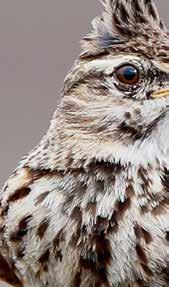





The Allenby Sisters
Matt & Penny Andrews
John & Claudia Arney
Charles & Victoria Arthur
Dr Richard Ashton
Paul & Helen Baker
Mrs Claire Baker
Caroline Barber
Aurea Baring
Mr & Mrs David Barrow
Mr & Mrs Simon Barrow
Mr & Mrs Bartholomew Sefi
Michael & Carolyn Bartlett
Val & Christopher Bateman
Susi & Marcus Batty
Stephen Beard
Julian & Jane Benson
Dr Rebecca & Mr
Andrew Berkley
Adrian Berrill-Cox
Hugh & Etta Bevan
Carol Blacker
Simon & Rebecca Bladon
Graham & Julia Bourne
Simon & Dorothy Broadley
Robin & Jill Broadley
Charles & Amanda Bromfield
Tony & Mo Brooking
Jo & Geoffrey Burnaby
Mrs Maurice Buxton
Karina & Max Casini
Mr & Mrs Paul Chase Gardener
Ann Chillingworth
Neil Chrimes
Olivia Christie
Christie Family
Mrs Laurence Colchester
Mr & Mrs Robin Collet
Alan & Ceanna Collett
Prof. Richard Collin
Barry & Pamela Collins
Elisabeth Colquhoun
Dr John Crook
Philippa Crosse & Simon Hopkins
Annabel & John Crowley
Paul & Rosemarie Cundy
John & Susan Curtis
Emiliana Damiani
James & Liz Davis
Mike & Suzette Davis
Anne & Jonathan Dawson
Carl & Mary Dore
Christopher & Jenny Duffett
Louise Duffy
Mrs Saskia Dunlop
Ken & Sheena Eaton
Sir Malcolm & Lady Edge
Mr & Mrs John Ellard
Rob & Anne England
Alun & Bridget Evans
John Farr
Rosie Faunch
Elaine Fear & Sol Mead
Michael Fitzgerald
Marveen & Graham Flack
Jules & Jonathan Flory
Sir Robert & Lady Francis
David & Elizabeth French
Carol Geddes
Bruce & Karin Ginsberg
Ms P Glidewell
Philippa & Charlie Goodall
Colin & Letts Goodwin
Sam & Jane Gordon Clark
Mr Robin & The Hon
Mrs Greenwood
Alistair & Jenny Groom
Max & Catherine Hadfield
Dilys Hall
Robert & Gillie Hanbury
BLH
Rachel & John Hannyngton
Mr & Mrs Hayman
Basil & Caroline Henley
Michael & Geneviève Higgin
Peter Hildebrand
Jonathan Holliday & Gwen Lewis
Lizzie Holmes
David & Mal Hope-Mason
David & Patricia Houghton
Colin & Irene House
Stephen Howis
The Howmans
Bart & Carole Huby
Iain & Claudia Hughes
Robert Hugill & David Hughes
Sue Humphrey
Adam & Laraine Humphryes
Nicholas & Jeremy
Andrew & Juliet Huntley
Anthony & Jenny Isaacs
Allan & Rachel James
Margi & Mike Jennings
Professor & Mrs J Jennings
John & Sara Jervoise
Helen & Jonathan Jesty
Rupert Johnson & Alexandra
Macdonald-Smith
John & Jennifer Kelly
David & Penny Kempton
Stephen & Caroline Kirk
Martin & Clare Knight
Mr & Mrs Morgan Krone
Simon & Antonia Strickland
Ian & Georgie Laing
John & Joanna Lang
Oliver & Victoria Larminie
Roger & Natalie Lee
Oscar & Margaret Lewisohn
Derek & Susie Lintott
Mr & Mrs H Lloyd
Tim & Rosanne Lowry
Michael & Margaret Major
John & Pat Marden
John & Deborah Markham
William & Felicity Mather
Julia Maxlow-Tomlinson
Dr Tom McClintock
Paul McKeown
Peter & Brigid McManus
Colin Menzies
Judith & Theo Mezger
Paul & Emily Michael
Martin Miles
Martin & Caroline Moore
Brian & Sonia Moritz
Cathy, Thea & Susi
Mr & Mrs John Muncey
Stephen & Fiona Murray
Tim Neill
John & Dianne Norton
Roy & Carole Oldham
Steven & Hilary Oldham
Denise Osborn
Peter & Sue Paice
Stephen & Isobel Parkinson
Colin & Judy Patrick
Peers of Alresford
Richard & Michelle Pelly
Mr & Mrs Penfold
Erik Penser
David Pether & Darin Stickley
Geoffrey & Jan Planer
John & Elizabeth Platt
Anthony Powell
Anthony & Trish Proctor
Mr & Mrs Pugh
Louisa Quarry
Miss Mary Rackham
Jane & Douglas Rae
Catherine Rainey
Dr Martin Read & Dr
Marian Gilbart Read
Jane Ridley & Jeffrey Thomas
Stephen Riley & Victoria Burch
Xavier & Alicia Robert
Nerys Roberts
Annie Robertson
Roger & Geraldine Robinson
Lynda & Michael Rose
Peter Rosenthal
Mr Keith Ross
Mr Peter Saunders & Mrs
Jeannine Lindt Saunders
Madi & David Laurence
Richard & Ruth Saunders
Tom Seabrook
Hugh & Patricia Sergeant
David Shaw
Lynn Shaw
Mary & Thoss Shearer
Julian & Carolyn Sheffield
Angus
Gill & Barry Smith
The Smith Family, Alresford & Swanage
Ian & Stephanie Smith
Michael & Wendy Smith
Drew Steanson
Kate Mather
Mr & Mrs Nicholas Stranks
Ron Sullam
Dr Jonathan Swanston & Miriam Coley
Hugh & Sandy Thomas
Mr & Mrs P M Thomas
Mrs. A. J. Thorman
John & Christine Thornton
Sarah Tillie
Roger Vignoles
Nick & Holly Villiers
Sandra & Paul Walker
Mr & Mrs Walsh
David & Meriel Walton
Johanna Waterous CBE & Roger Parry CBE
Philip & Annie Watson
Eleanor Wilkinson
Hamish & Elisabeth Williams
James & Sarah Williams
Mrs David Wilson
Edward & Marja Wilton
William & Celia Witts
Mary Rose & Charles Wood
Louise Woods
Mr & Mrs C Wright
The Wyatt Family & anonymous donors



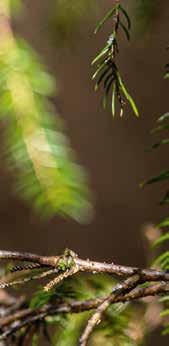

Adam-Germain
The Rickards Family
Graham & Stephanie Airs
Chris & Denise Amery
Jean Anderson
Dr Martin T. Anthony
Lord & Lady Arbuthnot of Edrom
Julie & Keith Attfield
Fred Baring
Tom & Gay Bartlam
Robert Baty
Drs Peter & Beatrice Bennett
Charles & Ann Bonney
Mrs Alison Bradley
Mrs Sheila Gay Bradley
Matthew Bradley
Julie Bradshaw
Mr & Mrs J M Britton
George Brown & Alison Calver
Peter Bull
Russell Burdekin
Mr Thomas Cahill
Mariacristina Cammarata
Jeremy & Kate Cave
Jane Countess of Clarendon
The Clemson Family
Monique Clowes
Maria Cobbe
Richard & Verity Coleman
Marianne & Harald Collet
Rosie & Derek Collinson
Nathaniel Colman
Bob & Linda Connell
David Coplestone
Roseanne Corlett
Erica & Neil Cosburn
Morella & Robert Cottam
Alan Cracknell
Dr Olivia Cundy
Aimee Curtis
Mr Peter Davidson
Simon & Noni de Zoete
Sandrine Boinet & Erik Dege
Hilary & Rob Douglas
Jonathan & Lynn Dowson
Dr Graham & Janna Dudding
Hugh & Christina Dumas
Mr Mark Duncan
Sir James Eadie
Nicky Ebdon & Alex Rowland
Peter Eggington
Michael & Margaret Ewing
Roger & Ruth Facer
Mrs Christopher Ferrer
Andrew Foot & Michael Hart
Peter Forster-Dean & David Elsley
Rod & Marie Franks
Geoffrey & Elizabeth Fuller
Paul & Sarah Galloway
N J Gammon
Lindsey Gardener
Ms Jillian Ede & David
Brooks Gendron
Joanna Gibbon
Brett & Caroline Gill
David & Bridget Glasgow
Katy Gordon
Dr Stephen Goss
Gill Graham Maw
Susie Grandfield
Michael Greaves
Dr Carolyn Greenwood
Mike & Stephanie Gretton
Catherine & Stephen Hackett
Richard & Judy Haes
John & Margaret Hall
Dr Sally Hanson
Susanna Hardman
John Harris
Guinevere & Julian Harvey
Maggie Heath
Rob & Anne Heather
Helen & Philip Heims
Roger Holden
H R Holland
Mrs Simon Holmes
Hei Mun Hong
Denzil & Kate How
Billy & Heather Howard
Derek Cormack & Suzanne Howe
The Allenby sisters
John & Susan Hyland
Howard & Anne Hyman
Chris Jefferies
Mrs Charlotte Johnson
Miss Flora Johnston
Scot & Sally Johnston
Nicola Jones
Alison & Jamie Justham
The Karran-Smith Family
Mae Keary
Penelope Kellie
Jocelyn Kennard
Michael & Julia Kerby
Mr & Mrs Patrick Hofmann
Cathy & Alan Kinnear
Dr & Mrs S Knights
Regine Kopp
Liz & Roger Kramers
Macbeth
Lynn Lee
Caroline & David Lentaigne
Kiereen & Nicholas Lock
James & Susie Long
Claudia Da Graca Lopes
V Lowings & B Cozens
Jonathan & Clare Lubran
The Lyon Family
Stephen & Karen MacDonald
Ian & Jane Macnabb
JJ & Victoria Macnamara
Miss C Martin
Mr & Mrs P T Mealing
Elaine & Peter Mills
Wilsons Solicitors LLP
Michelle Nevers & Nathan Moss
John Muhlemann
Sally & David Murch
Tom & Catherine Neal
Emily Neill
Lord & Lady Northbrook
Nicki Oakes-Monger
Colin & Rosalind Osmer
Robin & Christine Petherick
Jeremy & Bryony Pett
Anthony & Sally Pfiffner
Frank & Doreen Pointon
Sebastian Pont
Professor Postma
Sue & Peter Prag
Raymond Sutton & Judith Prickett
Jean Boney & Chrissie Quayle
Dick & Fiona Rainsbury
John & Marie Randall
Mr & Mrs Nick Read
Merv & Fenella Rees
Anne Reynolds
Mr P & Mrs K Richards
Michael & Charlotte Robinson
Charles Rogers
Mr & Mrs Jeremy Rothman
Tim & Maitina Rumboll
Gillian & Terry Rush
Sebastian Salek, Jordan
Bergmans, Alex Horkan, Charlotte Bennett, Alex Louch, Rachel Tait
Joseph Saxby
Ian & Rosemary Saxton
Ben & Sian Shawley
David & Rebecca Sheppard
Caroline & Mark Silver
Poppy Skepper
Ann Smart
Mr & Mrs Mark Sorby
Brian Spiby
Judy & Graham Staples
Dianne Steele
Mr Steensma & Mrs Steensma Bruynesteyn
David Stern
AnneMarie Stordiau
Rosie Sturgis
Swift Family
Tim & Charlotte Syder
Tom & Jo Taylor
Simon & Alison Taylor
Jeremy H Taylor & Raye Ward
Stephen Tedbury & Loveday Shewell
David Templeman
Tim & Jacky Thackeray
Prof & Mrs G M Tonge
John Trewby
Andrew & Diane Turnbull
M Tydeman
Edward & Katherine Wake
Anthony & Sue Walker
Sonia & Kevin Watson
Judith Wheatley
Angela Wheeler
Max Whitehead
Antonia Whitley
The Whittington Family
Kim Wilkie
Daniel & Thomas
Wilkinson-Horsfield
William & Madeline Wilks
Keith & Keren Williams
Mrs G C Williams
Wendy Wilson
Elizabeth Caroline Woods
Alan & Eleanor Wright
John Wynne-Williams & anonymous donors
SUPPORT
Nick & Sarah Allan
Peter & Valerie Bedford
Julian Chadwick
The Hampshire Fair Ltd
The Dyers’ Company
Michael & Anthea Del Mar
Tom & Sarah Floyd
Kate & Barry Goodchild
Roger Harrison
Lord & Lady Laidlaw
Nigel & Anna McNair Scott
Mr & Mrs P. T. Mealing
Ian & Jane Morrison
NEU West Hampshire District
Tim & Therese Parker
Colin & Judy Patrick
Phillips Law
Michael Philpot
Provident Financial
Dr Martin Read & Dr
Marian Gilbart Read
Alan Sainer
Simon & Alison Taylor
Sir Tom & Lady Troubridge
James Vernon
Mr & Mrs Walsh
The Woodward Charitable Trust & anonymous donors
Mrs Sheila Gay Bradley
Lord and Lady Bridges
David and Patricia Houghton
Nigel & Cathy Johnson-Hill
David McLellan
Heleen Mendl-Schrama
Michael & Cathy Pearman & anonymous Peacocks
SUPPORT
The Allenby Sisters
Nigel Beale & Anthony Lowrey
Peter & Valerie Bedford
Justin & Celeste Bickle
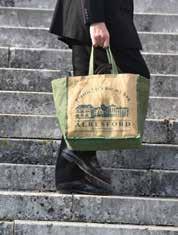
As the virus fades from most of our lives, its repercussions are likely to affect us for a long time. Our survival fund will give us much needed resilience over the coming months and years. We are particularly grateful to those who are helping us both recover and survive well into the future. If you think you can assist, please be in touch with rachel@ thegrangefestival.co.uk

Simon & Rebecca Bladon
Sophie Boden
David & Simone Caukill
Jane Clarke
Carl Cullingford
Golden Bottle Trust
Michel Kallipetis QC
Oscar & Margaret Lewisohn
The Parker Family
Neil & Julie Record
Brian & Henrietta Stevens
Richard & Cynthia Thompson & anonymous donors and many smaller gifts

We are grateful to the all following for generous gifts and legacies supporting productions, young artists, site improvements and our core cost
Mark & Sophie Ashburton
Jamie & Carolyn Balfour
The Band Trust
David & Elizabeth Benson
The R & I Pilkington
Charitable Trust
Peter Clarke
Marveen & Graham Flack
Tim & Rosie Forbes
Scott & Caroline Greenhalgh
The Linbury Trust

The Millichope Foundation
Tim & Therese Parker
Michael & Cathy Pearman
Mr & Mrs Roger Phillimore

Jonathan & Gillian Pickering
The Bernard Sunley
Charitable Foundation
James & Judy Scott
The Foyle Foundation
Peter Verstage
The Weinstock Fund
& anonymous donors
Christine Ashford
Nigel Beale and Anthony Lowrey
Robert Hugill and David Hughes
Roger Mayhew
Mr and Mrs Roger Phillimore
Brian Spiby
The GPS Macpherson
Charitable Trust
Lord and Lady Laidlaw
Clifford Chance
Opus Corporate Finance
Barclays
Nic Bentley
The de Laszlo Foundation
Roger Mayhew
Cathy and Michael Pearman
Michael and Sue Pragnell
Judy Quarry
The Syder Foundation
Learning@TheGrange has collaborated with the Superbloom – a wonderful project to fill the moat at the Tower of London with wild flowers to encourage urban biodiversity marking Her Majesty’s Platinum Jubilee. Together with 1500 schools, we have planted our own Superbloom seed mix around our theatre to celebrate our production of The Yeomen of the Guard –we hope the deer and rabbits will allow our seeds to flourish!



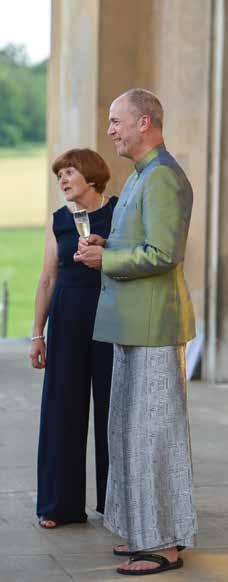





Knight Frank are proud to support The Grange Festival. For any advice on the current market, or help with your property needs, please get in touch. We’d love to help.


Like The Grange Festival, we bring talented people together to achieve something exceptional. Wishing you a wonderful festival.


INTERNATIONAL LAW FIRM CLIFFORD CHANCE IS PROUD TO SUPPORT THE GRANGE FESTIVAL www.cliffordchance.com



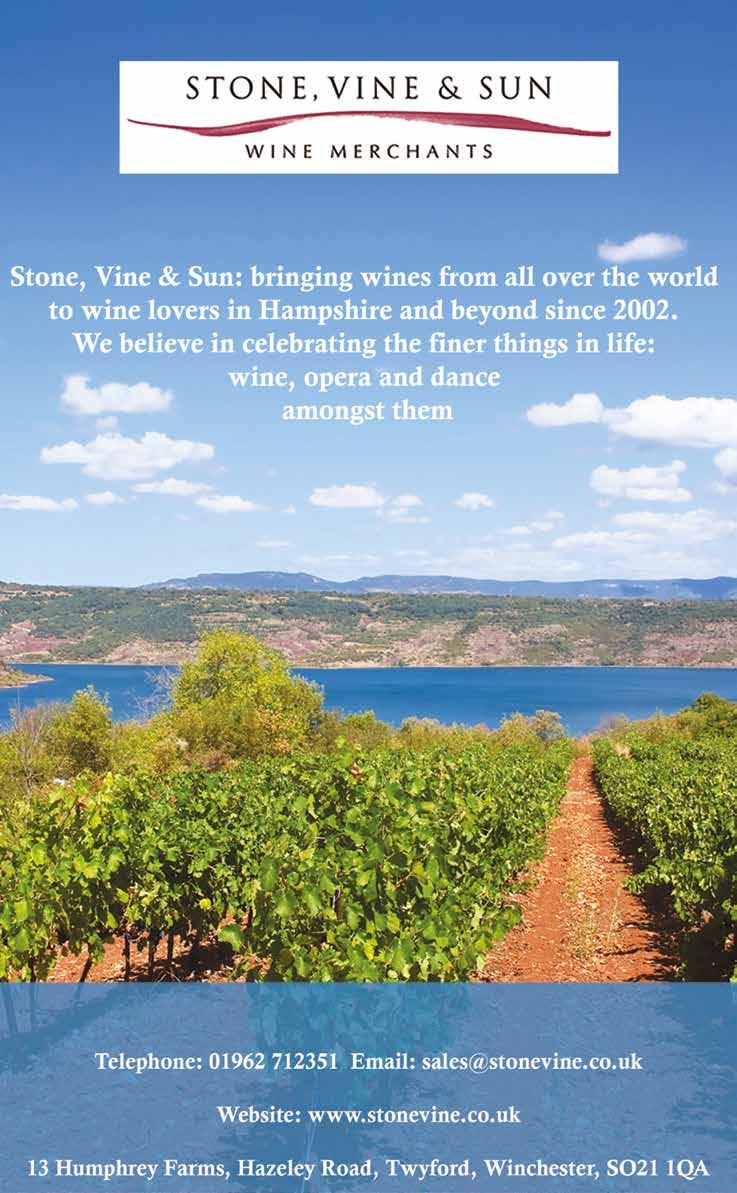

Kirker Holidays offers an extensive range of independent and escorted opera holidays to leading festivals in Europe such as Dresden, Verona and Torre del Lago, as well as Glyndebourne, Buxton and opera weekends in Vienna, Milan, Venice and New York. We also host our own exclusive music festivals on land and at sea, and arrange short breaks with opera, ballet or concert tickets, to all the great classical cities in Europe.
Prices are per person and include flights, transfers, accommodation with breakfast, opera tickets, meals and guided excursionsas described and the services of a Kirker Tour Leader.

FIVE NIGHT HOLIDAYS
3 AUGUST & 24 AUGUST 2022
Giacomo Puccini was born into a musical family in Lucca on 22 December 1858, and each summer his operas are performed in nearby Torre del Lago on the peaceful shores of Lake Massaciuccoli. Our holidays include two performances and the operas this summer are Turandot, Madama Butterfly, Tosca and La rondine. We stay at the 3* Albergo Celide, just outside Lucca’s magnificent walls and from here we shall enjoy a walking tour, including a visit to the house where Puccini was born and two great Tuscan gardens – the Villa Reale in Marlia and the Villa Garzoni.
Price from £2,167 (3 Aug, single supp. £397) or £2,239 (24 Aug, single supp. £397) for five nights including four dinners and two opera tickets.

A FOUR NIGHT HOLIDAY | 16 OCTOBER 2022
La Scala, Milan opened in 1778 with an opera by Salieri and since then many of the greatest Italian operas have received their first performance on its hallowed stage. Our autumn holiday will include a performance of Fedora by Giordano.
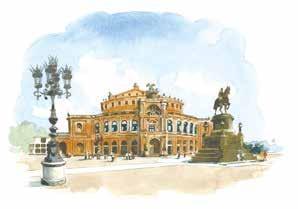
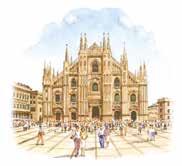
In addition to the opera, visits are included to the city’s great Duomo, the Brera Gallery, which houses one of the most important art collections in Italy, and the wonderful La Scala Museum with displays linked to all the great conductors, performers and designers associated with the opera house. We shall also visit the Basilica Sant’Ambrogio, and Casa Verdi, founded by Giuseppe Verdi and dedicated to taking care of musicians who have devoted their working lives to opera.
Price from £1,790 (single supp. £340) for four nights including two dinners and one opera ticket.
A FIVE NIGHT HOLIDAY | 9 AUGUST 2022
Built across 14 of the 20,000 islands that shelter the city from the Baltic, Stockholm is a revelation and undoubtedly one of the world’s most elegant capitals.
During our summer holiday in Stockholm we shall attend performances of Proserpin by Joseph Martin Kraus at the Theatre Confidencen in the Ulriksdal Palace, and Il Giustino by Vivaldi at Drottningholm. These two immaculately restored 18th century theatres are magnificent and unique performance spaces and the ultimate venues to enjoy Baroque opera. In addition to the operas, we include visits to the recently reopened National Museum of Fine Art and the wonderful Vasa Museum. Based at the 4* First Reisen Hotel, we shall also enjoy a guided walking tour through Stockholm’s old town, ending at Stockholm’s City Hall, Ragnar Östberg’s landmark building on the shores of Riddarfjärden.
Price from £2,280 per person (single supp. £395) for five nights including three dinners and two operas.


FOUR NIGHT HOLIDAYS
19 SEPTEMBER & 17 OCTOBER 2022
La Fenice is one of the world’s most historic opera houses. Originally built in 1790 it has twice burned down, in 1836 and again in 1996. It reopened in 2003 and has been sensitively restored to its original splendour.
Performances in 2022 include Puccini’s Madama Butterfly,Verdi’s Il trovatore and Donizetti’s La fille du régiment. We also include a series of walking tours taking in the finest churches and galleries, including the jewel-like Santa Maria Miracoli, the Accademia, and the more modern Peggy Guggenheim collection. We shall be based at the 4* deluxe Hotel Splendid for the duration of each holiday.
Price from £1,980 (single supp. 498) for four nights including two dinners and one opera ticket.






The home of Country House opera in South West England featuring renowned soloists and full orchestra

Giacomo Puccini
25, 28, 30 July at 19:00 | Matinée 27 July at 14:00 Sung in Italian with English surtitles
26, 27, 29 July at 19:00 | Matinée 30 July at 14:00 Sung in English with surtitles

Coade Theatre, Bryanston, Blandford Forum
Marquee bar | Picnics | Formal Dining Box Office: dorsetopera.com 07570 366 186



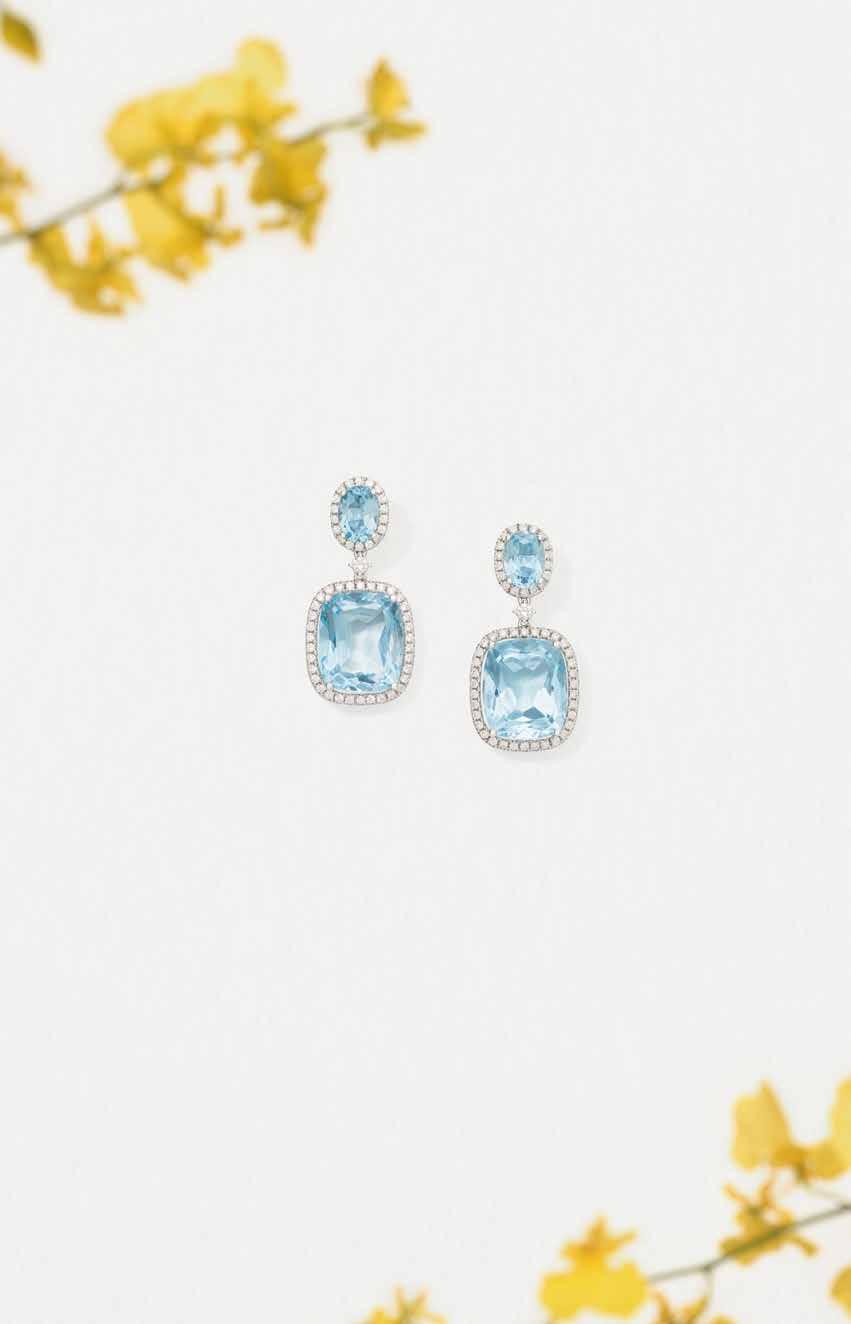


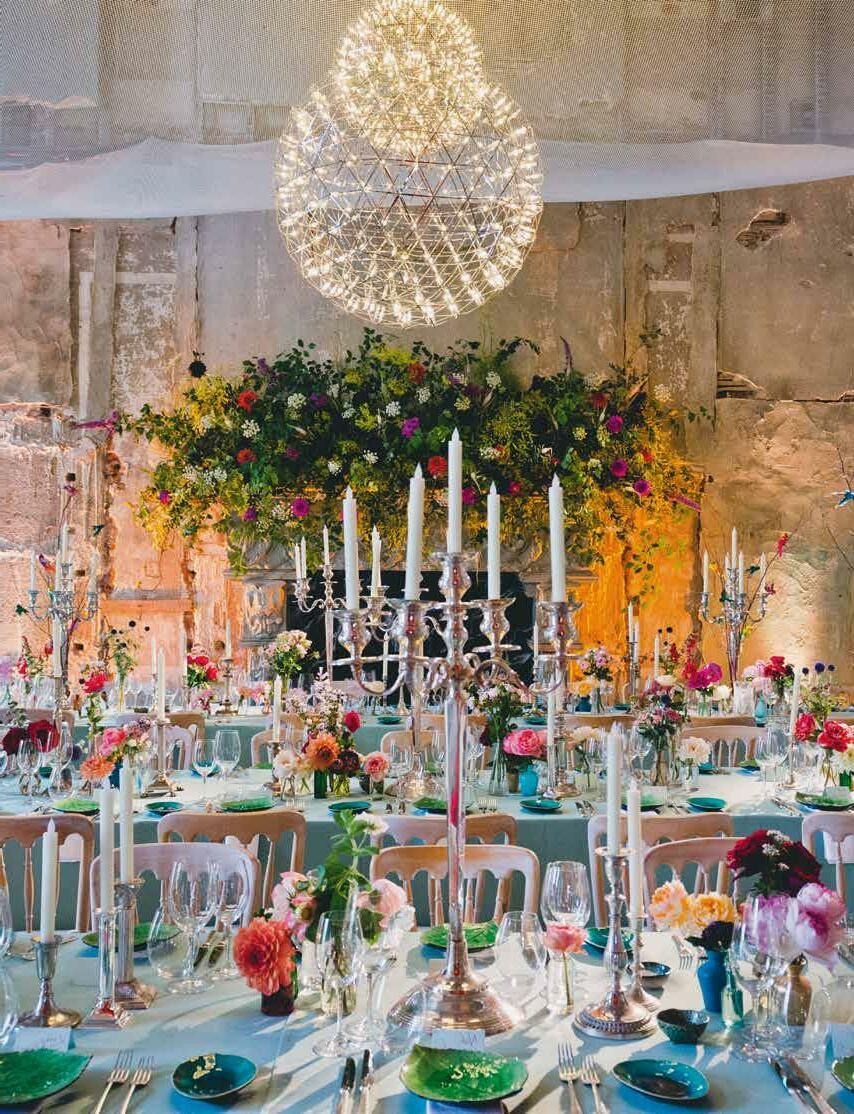




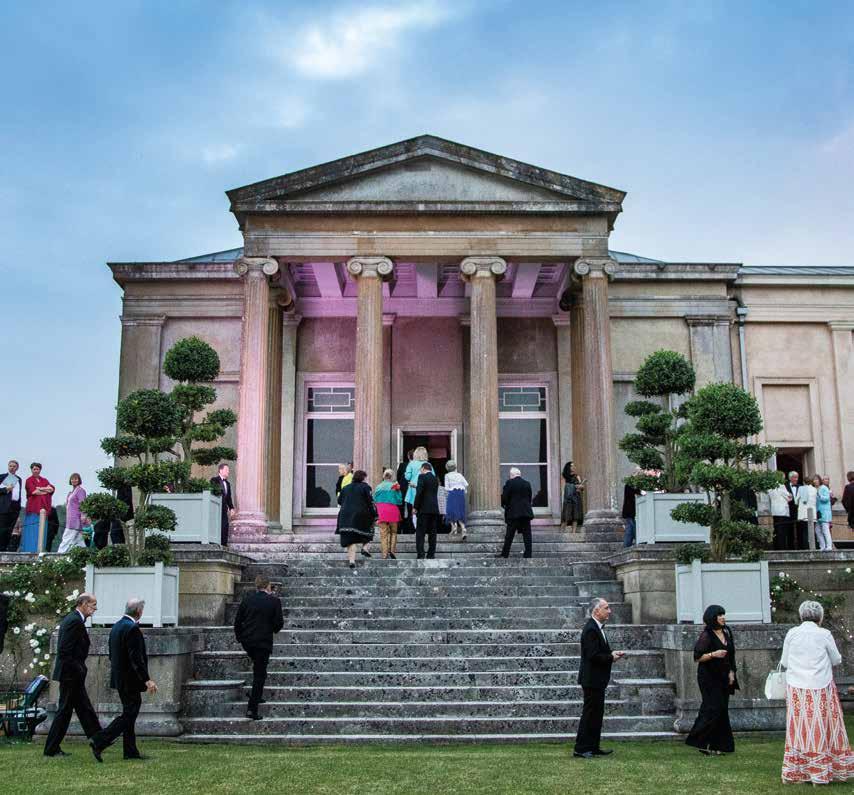











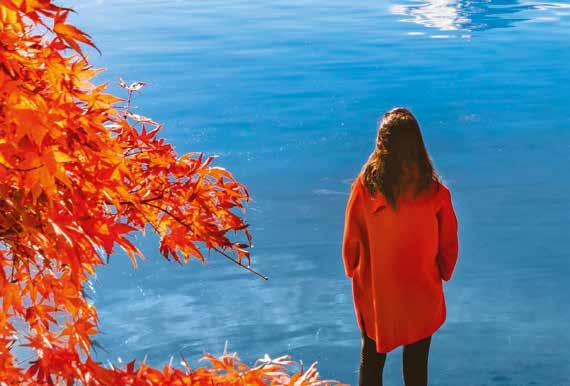



Barclays supports the continuing partnership between industry and the arts.

Day and boarding Sixth Form for boys and girls

Open day for 2023 entry: 1 October 2022

Financial support available for eligible pupils



winchestercollege.org

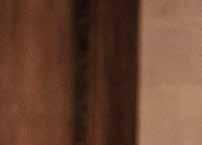
Whatever your investment objectives, and whatever your circumstances, when you’re looking for expert, individual investment management right here in Winchester, talk to Rathbones.
For further information, please contact the Winchester office on 01962 857 000 or email winchester@rathbones.com
rathbones.com
@RathbonesGroup
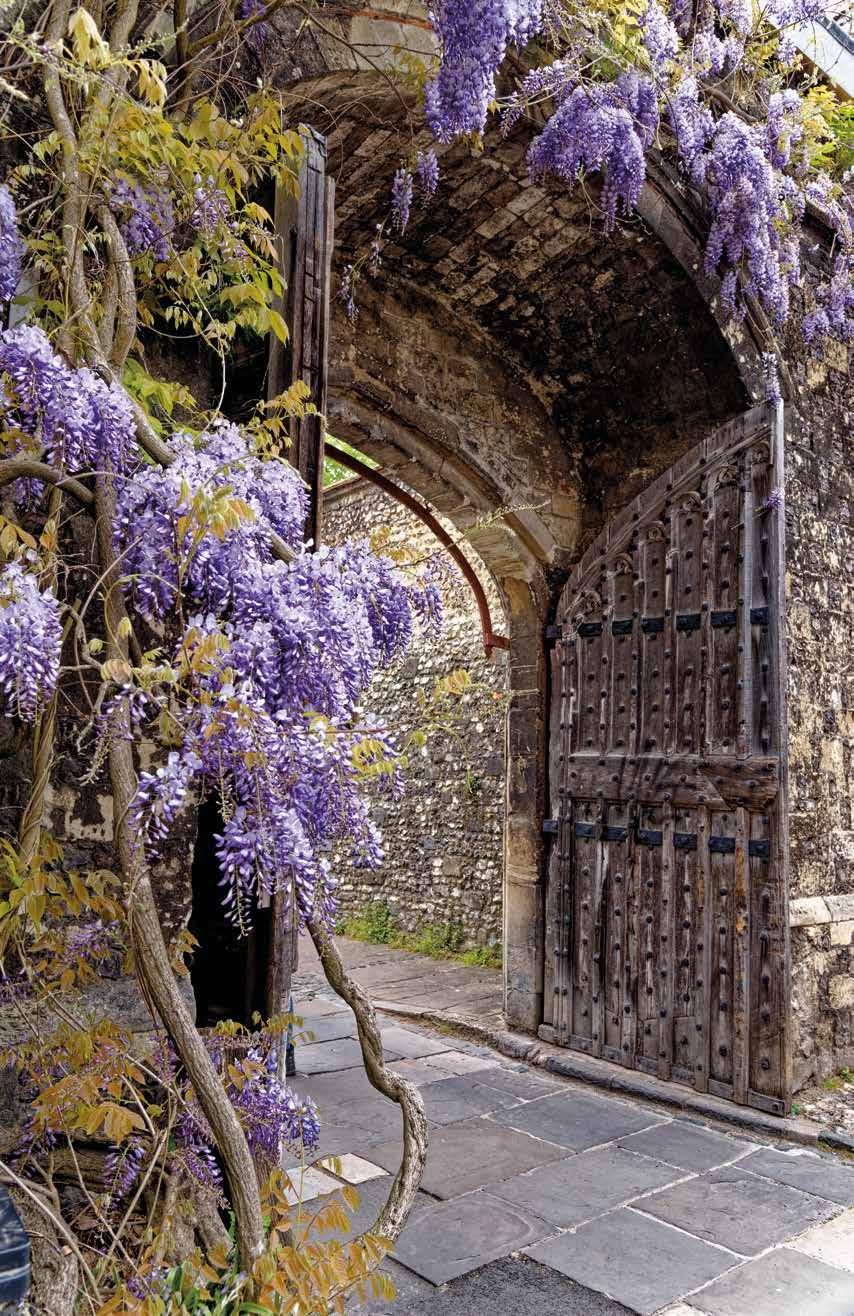
Rathbones Group Plc
@Rathbonesplc
The value of investments and income arising from them may fall as well as rise and you might get back less than you originally invested.
Rathbones is a trading name of Rathbone Investment Management Limited, which is authorised by the Prudential Regulation Authority and regulated by the Financial Conduct Authority and the Prudential Regulation Authority.
HUGGED BY 438 ACRES OF SECLUDED HAMPSHIRE COUNTRYSIDE LESS THAN AN HOUR FROM LONDON, HECKFIELD PLACE IS A GEORGIAN HOME THAT REDEFINES THE IDEA OF A HOTEL.
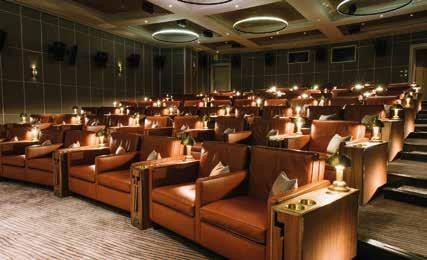

From SKYE GYNGELL’S open-fired HEARTH and GREEN MICHELIN STARRED MARLE RESTAURANT to afternoon teas in the GLASS HOUSE and our BIODYNAMIC MARKET GARDEN, we are bound by the rhythm of the seasons.


Ancient woodlands, gently wild grounds and the working estate inspire THE ASSEMBLY, an eclectic programme of CINEMA, WALKS, TALKS AND WORKSHOPS that offers much to do.
UNEARTH, RECONNECT and REDISCOVER at HECKFIELD PLACE.

Twyford School is delighted to celebrate our long standing association with The Grange Festival.


We are thrilled that Twyford children are performing in Verdi’ s Macbeth this Summer and are very proud that Twyford children have now graced the stage at The Grange Festival in seven productions.

It is a wonderful opportunity for our pupils and an unforgettable experience for each one of them.


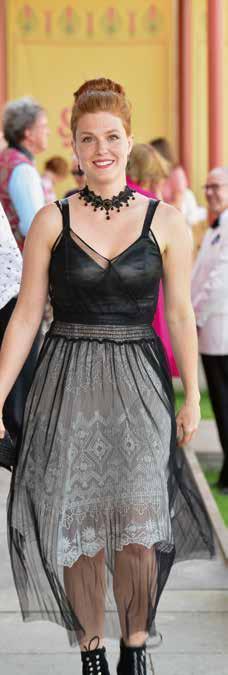







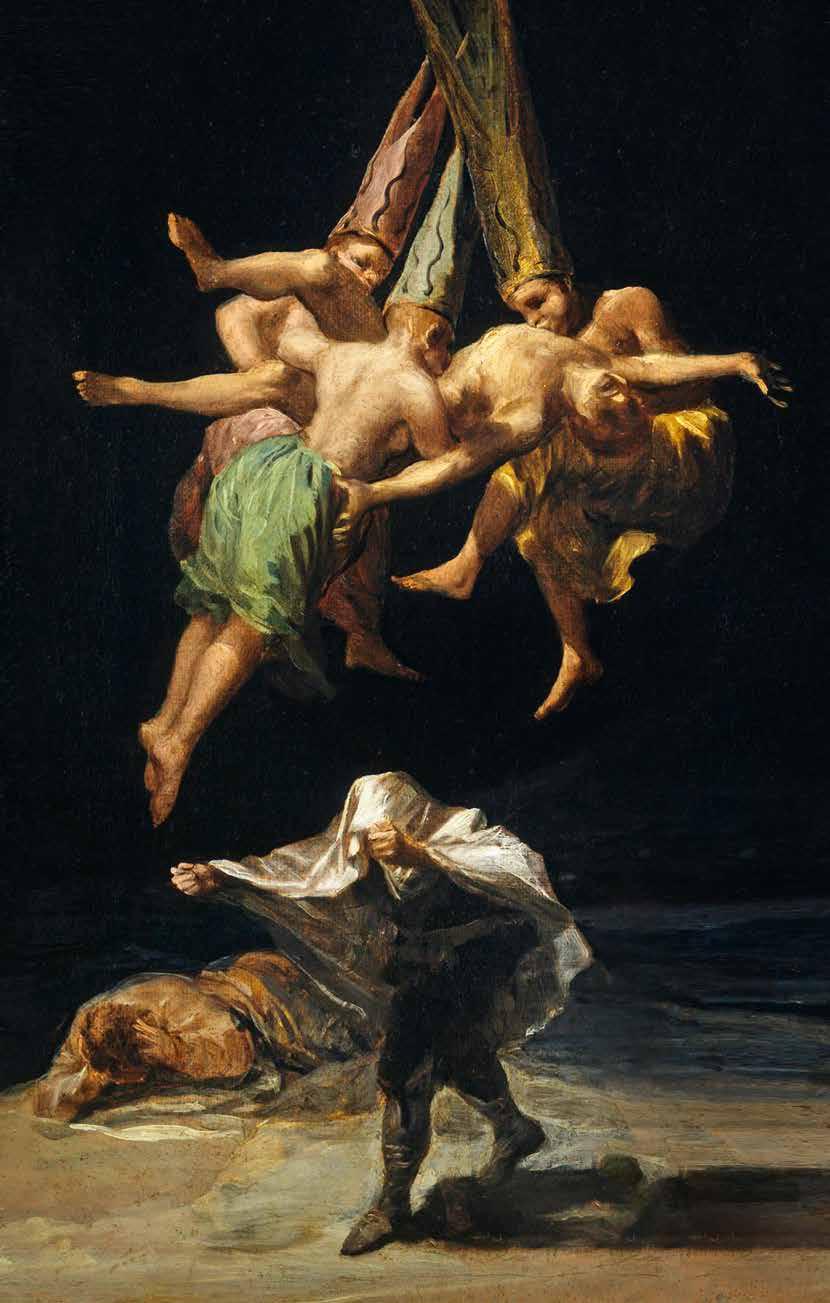


Conductor Francesco Cilluffo
Director & Choreographer Maxine Braham
Designer Madeleine Boyd
Lighting Designer Matt Haskins
Associate Choreographer Francesco Mangiacasale
BOURNEMOUTH SYMPHONY ORCHESTRA
Leader Amyn Merchant
THE GRANGE FESTIVAL CHORUS
Chorus Master Tom Primrose
Assistant Conductor Tom Fetherstonhaugh
Assistant Director Rachel Wise
Repetiteur/Language Coach Valeria Racco
Fight Director Xavi Monreal
Production Manager Tom Nickson
Wardrobe Supervisor Caroline Hughes
Macbeth Gezim Myshketa
Lady Macbeth Judith Howarth
Banquo Jonathan Lemalu
Macduff Samuel Sakker
Lady-in-Waiting Katie Lowe
Malcom Andrés Presno
Doctor Timothy Dawkins
Servant to Macbeth James Wafer
Assassin Tiziano Martini
Three Apparitions Pedro Ometto
Isabel Maria Araujo
Grace O’Malley
Duncan, King of Scotland Xavi Monreal
Fleance, son of Banquo Kai Patel
Dancers
Electra
Liam John Hill
Angela McIntosh
Justyna Sochaj
Anna Emilia Yliaho
Holly Dodgson
Young Apparitions *

Sion Llywelyn-Davies
Kirsty Louw
*By kind permission of the Headmaster, Twyford School
Laurie Westlake
Florence
Llywelyn-Davies (cover)
Ben Lown (cover)
Scotland. Macbeth and Banquo, leaders of the Scottish army, meet a group of witches who prophesy the future. They address Macbeth as Thane of Cawdor and King of Scotland, and tell Banquo that he will be the father of kings. The two men try to learn more, but the witches vanish. Messengers arrive with news that Duncan, the current king of Scotland, has made Macbeth Thane of Cawdor. The first part of the witches’ prediction has come true.
In Macbeth’s castle, Lady Macbeth reads a letter from her husband telling her of the events that have just transpired. She resolves to follow her ambitions. A servant announces that Duncan will soon arrive at the castle, and when Macbeth enters, she tells him that they must kill the king. Duncan arrives. Macbeth has a vision of a dagger, then leaves to commit the murder. On his return, he tells his wife how the act has frightened him, and she tells him that he needs more courage. They both leave as Banquo enters with Macduff, a nobleman, who discovers the murder. Macbeth and Lady Macbeth pretend to be horrified and join the others in condemning the murder.
Macbeth has become king. Duncan’s son, Malcolm, is suspected of having killed his father and has fled to England. Worried about the prophecy that Banquo’s children will rule, Macbeth and his wife now plan to kill him and his son, Fleance, as well. As Macbeth leaves to prepare the double murder, Lady Macbeth hopes that it will finally make the throne secure.
Outside the castle, assassins wait for Banquo, who appears with his son, warning him of strange forebodings. Banquo is killed, but Fleance escapes.
Lady Macbeth welcomes the court to the banquet hall and sings a drinking song, while Macbeth receives news that Banquo is dead and his son has escaped. About to take Banquo’s seat at the table, Macbeth has a terrifying vision of the dead man accusing him. His wife is unable to calm her unsettled husband, and the courtiers wonder about the king’s strange behavior. Macduff vows to leave the country, which is now ruled by criminals.
INTERVAL (100 minutes)
The witches gather again, and Macbeth visits them, demanding more prophecies. Apparitions warn him to beware of Macduff and assure him that “no man of woman born” can harm him, and that he will be invincible until Birnam Wood marches on his castle. In another vision, he sees a procession of future kings, followed by Banquo. Horrified, Macbeth collapses. The witches disappear and his wife finds him. They resolve to kill Macduff and his family.
On the Scottish border, Macduff has joined the refugees. His wife and children have been killed. Malcolm appears with English troops and leads them to invade Scotland.

Lady Macbeth is sleepwalking, haunted by the horrors of what she and her husband have done.
Macbeth awaits the arrival of his enemies and realises that he will never live to a peaceful old age. Messengers bring news that Lady Macbeth has died, and that Birnam Wood appears to be moving. English soldiers appear, camouflaged with its branches. Macduff confronts Macbeth and tells him that he was not born naturally but had a Caesarean birth. He kills Macbeth and proclaims Malcolm king of Scotland.

The mid 1840s were a busy time for Giuseppe Verdi. In just a few years the ambitious composer, then in his early thirties, had started his career at Milan’s La Scala, and following the triumphal reception of Nabucco (1842) and I Lombardi alla prima crociata (1843) had secured commissions from the leading opera houses in Italy – Venice, Rome, Naples. In 1846 he signed a new agreement with the powerful Alessandro Lanari, the impresario of the Teatro alla Pergola in Florence. That agreement was fulfilled on 14 March 1847, with the premiere performance of Verdi’s Macbeth, to a libretto by Francesco Maria Piave. Almost two decades later, in 1865, Verdi revised Macbeth for a new production by the Théâtre Lyrique in Paris. It is the latter version, originally performed in French but now heard mostly in Italian, that has prevailed in our time, taking pride of place among Verdi’s most admired works.
Rarely did Verdi express so much excitement for a subject as in his first letter to Piave concerning Macbeth (4 September 1846). The missive in typical Verdian fashion, begins straightforwardly: ‘Here is the draft of Macbet [sic]. This tragedy is one of the greatest human creations!… If we can’t do something great, let us at least try to do something out of the ordinary’. Such a statement is remarkable. One should not assume that an opera composer at the time would necessarily choose the subject matter for their operas; Verdi himself, in the early stages of his career, received some librettos ‘off the rack’, so to speak, although they were then adjusted to his needs – Un giorno di regno (1840) and Nabucco (1842) are cases in point. As soon as his standing and
negotiating power allowed, however, Verdi sought not only to select the subjects for his operas, but also to establish how those subjects were to be treated and who would be cast in the main roles. Hence, Verdi did not commit to using Macbeth as the subject for his opera for Florence until he had assurance that the baritone Felice Varesi would create the title role. And the collaboration with Piave, as can be inferred from the letter cited above, began with an outline which served as the starting point for the distribution of roles and the division of the libretto into acts and scenes.
Operas are, of course, the result of collaboration between the composer and others (librettists, impresarios, singers, to name only a few of the agents involved in the productive process). But as far as the libretto goes, the overall structure as well as the treatment of individual scenes and details were developed entirely by Verdi. There is, then, Verdi’s enthusiastic endorsement of Shakespeare, which is hardly news to modern opera lovers, familiar as they are not only with Macbeth, but also with his final masterpieces, Otello (1887) and Falstaff (1893). The origins of Verdi’s interest in Shakespeare overlap with start of his operatic career, when he discovered the playwright mostly through Rusconi’s translations, published for the first time in 1838. In the wake of Macbeth, around 1849, Verdi compiled two lists of potential subjects, both of which began with King Lear; the longer of the two lists also included Hamlet and The Tempest. Verdi contemplated a Re Lear for several years, having two librettos drafted by Salvadore Cammarano and Antonio Somma and then casting the project aside without drafting any music.
Verdi, in his first letter to Piave concerning Macbeth

“This tragedy is one of the greatest human creations! If we can’t do something great, let us at least try to do something out of the ordinary”
Piave and Verdi’s Macbeth follows Shakespeare’s tragedy closely, albeit drawing on a translation, and it is a straightforward matter to map various passages of the libretto onto corresponding sections of the play. There are also significant differences, however. Some have to do with the practical needs of adapting a text for the operatic stage; for example, the three witches at the beginning of the play became in the opera a full chorus of witches divided into three groups, each of which delivers one of the prophecies. The morphing of the witches into a chorus was in observance of the time-honoured convention of beginning an opera with an introduzione, a number that conventionally began with the chorus and then introduced one or more principal characters (here Macbeth and Banquo). Another instance is the chorus of Scots that opens the final act (‘Patria oppressa!’ –‘Oppressed homeland!’) Indeed, in his operas of the 1840s, Verdi frequently provided patriotic choruses of disheartenment and longing (the celebrated ‘Va, pensiero’ in Nabucco is a case in point). From that perspective Macbeth is an opera that also explores the theme of subjugation and regeneration of a people. ‘Patria oppressa’ is one of the numbers in the score that underwent significant revision in 1865, when Verdi infused it with sophisticated harmonic progressions giving it a uniquely eerie quality.
In the letter to Piave cited at the beginning, the composer also stated: ‘I know the general character and the tinte as if the libretto were already finished’. By tinta Verdi meant tone, colour, quality. The notion that he had in mind the overall character and tone of a score before the composition even began is one that surfaces repeatedly in his correspondence, and it must be kept well in mind when approaching the music of Macbeth. Although the opera, as one should expect, presents some rather conventional features, at least from a formal standpoint (such as the double aria for Lady Macbeth in Act I, whose structure consists of a recitative, cantabile, tempo di mezzo, and cabaletta), Verdi also broke new ground in terms of use of unifying elements, musical characterisation, and formal organisation. Thus, for example, the title character is introduced not with a full-fledged aria, but in a short recitative followed by a powerful, single-movement duet with Banquo within the introduzione (‘Due vaticini compiuti or sono’ – ‘Two prophecies are now fulfilled’). The lack of an entrance aria for the title role is compensated with other solos; such as the one within the Act 2 finale (‘Sangue a me quell’ombra chiede’ – ‘That shadow demands blood from me’), and the Andante
sostenuto, ‘Pietà, rispetto, onore’ (‘Mercy, respect, honour’) and a death scene (which Verdi omitted when he revised the original version of the opera for Paris. Arguably, the most powerful moment for Macbeth is the dagger scene (‘Mi si affaccia un pugnal’ – ‘Is this a dagger which I see before me’), a monologue closely modelled after Shakespeare, whose music, throughcomposed and filled with declamatory utterances and pervasive chromaticism, seems to foreshadow Rigoletto’s ‘Pari siamo’. The conclusion of the dagger scene deserves special attention. As he re-enters the stage having murdered King Duncan, Macbeth utters three fateful words: ‘Tutto è finito!’ (‘All is finished!’). One might dare say that here the libretto outdoes Shakespeare – the famed “I have done the deed’. The word ‘finito’ is sung on an anguished semitone which suddenly morphs into the cell that launches the ensuing duet with the Lady (‘Fatal mia donna! un murmure’ – ‘My fateful woman, a murmur’) is built; and the same motif becomes a unifying element woven throughout the score, reappearing for instance in the Act 1 finale, at the opening of Act 2, and in Lady Macbeth’s sleepwalking scene.
Although not the title character, Lady Macbeth is possibly more nuanced and complex than the man at her side. Her entrance aria, mentioned previously, is one of relatively few numbers in the score that adheres strictly to the formal conventions of early nineteenth-century Italian opera. A sense of resolve comes through in that piece, where her character is depicted in bold strokes, through forceful coloratura passages and an abundance of leaps – features reappear in the drinking song in Act 2 (‘Si colmi il calice’ – ‘Let us fill the cup’). The more intimate, nocturnal side of her character is displayed in the duet with Macbeth and culminates in the magnificent sleepwalking scene, which requires softness of tone and psychological finesse. In 1849, when the celebrated soprano Eugenia Tadolini was offered the role of Lady Macbeth in Verdi’s Macbeth, the composer thundered: ‘Tadolini has a handsome and good figure, and I would want Lady Macbeth ugly and evil. Tadolini sings to perfection, and I would want Lady not to sing at all. Tadolini has a splendid, clear, limpid, powerful voice, and I would want for the Lady a sharp, suffocated, dark voice. Tadolini’s voice has an angelic quality; I would want the Lady’s voice to be diabolical . . .’ Such vehement expressions (especially ‘I would want Lady not to sing at all’!) are not to be taken literally: of course the role of Lady Macbeth requires exceptional technical command. But Verdi’s focus on dramatic effectiveness is eloquent.
As Verdi made clear in a letter of 8 February 1865 to his Parisian publisher, Léon Escudier, Macbeth and the Lady share the stage with a third, equally important character – the chorus of witches. ‘Above all, bear in mind that there are three roles in this opera and three is all there can be: Lady Macbeth, Macbeth, and the chorus of witches. – The witches dominate the drama; everything derives from them . . .’ That dominance is established at the opening of the opera’s orchestral prelude – cast in the minor mode with oboes, clarinets, and bassoons in unison, descending chromatic scales – and then by such expressive indications as sottovoce and cupo (‘in a soft tone’ and ‘dark’). Musicologist Andreas Giger has recently highlighted how, by sharing those musical and expressive features, the witches’ venom is injected into the Lady’s part (although the witches never meet her directly), and less into Macbeth’s.

Indeed, the king is allowed some self-awareness, and even nobility, in his final utterances on stage (whether or not the death scene, composed in 1847 and omitted in the 1865 revision of the score, is performed). In his cantabile, ‘Pietà, rispetto, onore’, he strikes again the noble tone of his duet with Banco at the beginning of the opera. At the end of

the opera, Verdi takes leave from us highlighting the tragedy of Macbeth’s isolation and all-too-late expression of humanity – in diametrical opposition to both the Lady and the witches, who vanish both dramatically and musically. There can be little doubt that, in 1847 and again with the 1865 revision, Verdi achieved ‘something out of the ordinary’. This is an opera that combines Verdi’s early manner, political and choral, with a groundbreaking exploration of the intricacies of the human mind, capitalising on the experience acquired in his earlier operas whilst also foreshadowing some of his more mature achievements. It is not difficult to understand why this work today continues to engage opera aficionados, providing abundant food for thought also for the most enthusiastic devotees of Shakespeare.
Francesco Izzo is Professor of Music at the University of Southampton. He is General Editor of the critical edition The Works of Giuseppe Verdi (University of Chicago Press and Ricordi), for which he has edited Un giorno di regno, and serves as Direttore Scientifico of Festival Verdi Parma. He is the author of Laughter between Two Revolutions: Opera buffa in Italy, 1831–1848 (2013) and of numerous essays on nineteenth-century opera.


Verdi, 8 February 1865, in a letter written to the French publisher of the revised version of the opera
Shakespeare probably wrote Macbeth in 1606, close on the heels of King Lear and shortly before Antony and Cleopatra. One of his most driven and focused plays, it is also one of his shortest, and was written at a point in his career where he was exploring to the limits his ideas of what a tragedy might be. He developed his plot from the narratives of eleventh-century war-torn Scotland he found in Holinshed’s Chronicles, which include the story of Macbeth amid other accounts of unscrupulous thanes, ambitious wives, murdered kings and consultation with witches. It was a resonant choice of theme, which may partly have appealed because it allowed him to investigate topics of acute current interest. Chief amongst these was regicide. James VI of Scotland had succeeded Elizabeth to the English throne in 1603, and the failed Gunpowder Plot of 1605, planned by Catholic conspirators and discovered apparently at the last minute, was a recent and seismic event. Another issue that clearly intrigued him was the politically contentious Jesuit doctrine of equivocation, which allowed arrested Catholics partially to withhold the truth when under investigation. The idea of deceiving half-truths is central to Shakespeare’s play, and to his exploration of the power of language to conceal and mislead.
The plotline of Shakespeare’s Macbeth is unusually spare. Enclosed by the shadowy supernatural world
of the witches, the drama is centred on the Macbeths and their disintegration as they drive the world around them towards a bloodbath. Memorably, the pair are trapped in the play’s vertiginous sense of time, veering between the immediate and the immeasurable. Deeds must be done now, quickly, and yet ‘Tomorrow, and tomorrow, and tomorrow’ creep on ‘To the last syllable of recorded time’. Decisive in the moment, the Macbeths are stranded in time because they are childless; the dumbshow of kings, concluding with Banquo, projects into the limitless future. When the action moves outside the Macbeths’ claustrophobic relationship there is no relief. Shakespeare introduces a note of grim humour in the Porter at the gate of the Macbeth’s castle, who represents the traditional Porter at the Gates of Hell; and the brief pathos of the scene introducing Lady Macduff – one of only three women in the human world of the play – inspires only dread, and concludes with the ruthless murder we have feared, the most horrifying of Macbeth’s crimes. A long, bleak single scene set in England, mainly between Malcolm and Macduff, is coloured by suspicion, loss and rage. Strikingly, when he came to create his own version of the drama, Verdi pared back even further. He removed the Porter and Lady Macduff entirely, focusing even more closely on the central relationship and intensifying the claustrophobia and the dramatic drive.

“There are three roles in this opera… Lady Macbeth, Macbeth, and the chorus of witches”
Surrounding the human drama in a dark miasma are Shakespeare’s iconic witches. Because they and their bubbling cauldron have become a familiar trope, it may not be clear to us how innovative their presence is. Witches were the object of moral panic and fascinated speculation (not least to James, who published his own dissertation on witchcraft in 1597). Some saw them as the ‘wise women’ of rural England – both sought out and feared; to others, they were the demonically possessed madwomen of fevered religious imaginations, or charlatans and con artists. In the early modern period, many of the latter (both male and female and often deluded or exploited) were apprehended as personal or political scapegoats – Shakespeare himself had portrayed such a figure in an earlier play, Henry VI, part 2. The Weird Sisters are not exactly any of these. Ambiguously bearded crones, they borrow from popular witch lore with their incantations, familiars and gruesome body parts, but their chief concern is with prophecy. To borrow Banquo’s words, they can ‘look into the seeds of time’. Like the Fates of classical literature and the Norns of Norse mythology, they are Three, and like the classical oracles they speak to fatally mislead. They articulate Macbeth’s scarcely acknowledged aspirations, and in many productions have been presented chiefly as a psychological projection of his deepest desires. One may also speculate on their link to Lady Macbeth, who invokes demons: ‘Come, you spirits / That tend on mortal thoughts’; ‘Arise, all the agents of hell that rouse mortals to bloody acts!’ But the Sisters reach beyond the Macbeths, to permeate a play seamed with equivocal and incomplete utterance and a sense of the malleability of time. Like the theatre itself, their witchcraft operates on ‘the border … where the imagination and the corporeal world, … psychic disturbance and objective truth meet’, as Stephen Greenblatt puts it. Shakespeare would have appreciated the entertainment possibilities of witches but must also have relished them as ‘dramatists’ themselves, creators of fictions and illusions.
To those familiar with Shakespeare’s three solitary figures, a stageful of singing witches may come as a surprise. But by the time Verdi came to read Macbeth (in 1847, Shakespeare’s play had not yet been staged in Italy), the presentation of the witches had radically changed. Early additions to Shakespeare’s text, probably made by Thomas Middleton with the new, better equipped indoor theatres in mind, provided a goddess, Hecate, three additional witches, and songs. In the 1660s, the play was staged in a semi-operatic adaptation in which
the leading witches and Hecate were played by male comedians, with a backing group of singing and dancing witches. By 1794, John Kemble, in the spirit of the gothic, was treating them more seriously, but still offered 50 or 60 singing witches and a group of child spirits. This is the theatrical tradition that would have been reported to Verdi, who took the trouble to send to England to find out how the play, especially the supernatural elements such as the witches, ghost and dagger, was being staged. Verdi’s massed witches have a powerful choric effect. A female chorus not designed to allure was unusual, and the opening scene would have startled audiences. Their counterpoint, on a much smaller scale, is the male chorus of assassins (again replacing a mere handful of characters in the play) – masculine, intimidating, but of the corporeal world. The witches’ extended presence onstage, their sheer numbers and their increasing prophetic power make them the major protagonist that Verdi understood them to be. In many productions of both play and opera they continue to haunt the action to the end, after the human feminine has been brutally erased.
The tones of Shakespeare’s play are taken from a constrained, claustrophobic palette. The language is dense and often monosyllabic: the heavy murderous drumbeat words ‘done’, ‘do’, ‘deed’ constantly recur. In contrast, Shakespeare created polysyllables: the hissing new words ‘assassination’ and ‘consequence’, coinages to dress up ‘murder’ and ‘guilt’. The images are of blood, milk; of crows, ravens, horses run wild. The sounds are knocking, knells, owl hoots. The colours are those of night: darkness with flashes of light. The wild darkness is moral and psychological, but the impression that actual darkness is almost always present is the more striking when we remember that the play was written for the Globe, an openair theatre, where it would have been performed in daylight. It’s fascinating to see how Verdi, having carved away his text to the bone, creates his own version of the play’s verbal effects by musical means. The harmony is darkened with falling minor seconds and minor thirds; sudden fortissimos flash through the gloom of muted sotto voce, and the orchestral tone is coloured by the spectral register of deep clarinets and cor anglais. The orchestral writing accompanying Lady Macbeth’s aria ‘La luce langue’ coils and slithers like the word ‘assassination’. For the witches Verdi writes choruses of hectic glee, intentionally coarse, teetering, like Shakespeare’s witches, on the brink of the monstrously comic, and terrifying in their demonic relish.
Shakespeare’s Macbeth has sometimes been considered a highly moral play: the pitiless villains disintegrate before our eyes and die terrible deaths. Towards the end of the drama, order is, it seems, restored. Verdi, writing in a politically divided Italy, introduces something new: a wider sense of the social cost of corruption and tyranny, expressed by the chorus. The two choral groups join forces and in the chorus that opens Act 4, ‘Patria oppressa’, become Scottish refugees from Macbeth’s tyranny. But the final scene has a grimness which is not just that of exhaustion. In Verdi’s drama as in Shakespeare’s, Macduff and the chorus salute Malcolm, the new king:
‘Salve’, ‘Hail’ – a chilling echo of the witches’ salutation to Macbeth at the start of the drama. With a lurch we realise that the narrative is cyclical: blind ambition, violent overthrow, brutality and tyranny – all will return. This is the truth that Macbeth tells and that has been there for audiences to find since its inception.
Jane Armstrong

Jane Armstrong was commissioning editor for the Arden Shakespeare and has worked on many volumes in the series and the parallel series Arden Early Modern Drama. She is the author of The Arden Shakespeare Miscellany (2011).

“The wild darkness is moral and psychological, but the impression that actual darkness is almost always present is the more striking when we remember that the play was written for the Globe, an open-air theatre, where it would have been performed in daylight”



Libretto by Nicola Francesco Haym | Sung in Italian with surtitles by Kenneth Chalmers
Conductor Robert Howarth
Director Daniel Slater
Designer Robert Innes Hopkins
Lighting Designer Johanna Town
BOURNEMOUTH SYMPHONY ORCHESTRA

Leader Amyn Merchant
Assistant Conductor Jonathan Darbourne & Repetiteur
Assistant Director Louise Bakker
Language Coach Alessandra Fasolo
Fight Consultant Ray Strasser-King
Production Manager Tom Nickson
Wardrobe Supervisor Josie Thomas
Tamerlano Raffaele Pe
Bajazet Paul Nilon
Asteria Sophie Bevan
Andronico Patrick Terry
Irene Angharad Lyddon
Leone Stuart Orme
Actors Alex Comana
Molly Moody
Korey J Ryan
Holly Sonabend
Ray Strasser-King
This production is supported by Michael and Sue Pragnell | Roger Mayhew
The edition of Tamerlano used in these performances is published by Bärenreiter-Verlag Kassel, edited by Terence Best. Performed by arrangement with Faber Music Ltd London.
The all-powerful emperor, ignorant of where Andronico’s affections really lie, asks Andronico to plead his cause with Asteria, promising him in return the hand of Irene and the restoration of Byzantine power. He also promises to free Bajazet who, in despair at his defeat, desires only death. Irene arrives at the palace still believing she is to marry Tamerlano. Andronico breaks the news of her rejection by Tamerlano but persuades her to remain at court (disguised as a lady-in-waiting to protect her identity) in order to await developments. Betrayed by Andronico’s apparent treachery, Asteria pretends to accept Tamerlano’s love, which horrifies Bajazet and Andronico.
Asteria accepts Tamerlano’s proposal, her motive being to get near the tyrant, whom she will then try to assassinate. The outrage of Bajazet and Andronico at her apparent faithlessness causes her to change her mind at the last moment. The murder attempt having failed, the furious Tamerlano swears he will have Asteria and her father killed.
INTERVAL (100 minutes)
Asteria’s disdain, however, has changed him and he renews his offer to Andronico, only to have it rejected. Andronico now proclaims his love for Asteria. Once again Tamerlano swears revenge on all of them. During a banquet, Asteria (now a slave) tries to poison Tamerlano, whose life is saved by the intervention of Irene, who then reveals herself. Asteria is condemned to death and Bajazet is driven to suicide by the imminent execution of his daughter: only thus can he escape Tamerlano’s power. In an impassioned monologue Bajazet calls on the Furies to take revenge on Tamerlano, then takes his own life. But his death so moves the emperor that he decides to pardon Asteria and give her hand in marriage to Andronico. Tamerlano himself will after all honour his betrothal to Irene.

Tamerlano forms part of a trio of operatic masterpieces with which Handel dazzled his London audience at the King’s Theatre in the Haymarket in 1724–1725. The first of these, Giulio Cesare, is a freewheeling adventure story centred on the love affair between Julius Caesar and Queen Cleopatra of Egypt. The last, Rodelinda, set in medieval Italy, is a drama of dynastic ambition thwarted by marital steadfastness. Between them both lies Tamerlano, in which the ruthless Mongol conqueror Tamburlaine meets his match in the bravery of the captive Turkish sultan Bajazet, his daughter Asteria and her lover, Byzantine prince Andronico. Each work scopes out its own highly individualized dramatic world, thoroughly validating the praise often given to the composer as a kind of musical Shakespeare, formidable in his grasp of mood, situation and character.
At the first night of Tamerlano, on 31 October 1724, few among the fashionable Georgian audience, paying half a guinea each for their King’s Theatre tickets (‘No Persons to be admitted behind the Scenes’) could have guessed at the complexities involved in putting the work together. The original Italian libretto was the work of Count Agostino Piovene, a gifted amateur poet who grafted various details from the work of the Byzantine historian Michael Ducas onto a French neoclassical tragedy, Tamerlan ou La Mort de Bajazet, by Jacques Pradon, produced in 1675. Piovene’s text had first been set by Francesco Gasparini, a composer whose work Handel clearly admired and was sufficiently absorbed by the drama to make three separate versions of it in the course of eight years. The second of these, premiered at Reggio Emilia in 1719 as Il Bajazet, starred the tenor Francesco Borosini, whose vocal virtuosity was matched by genuine theatrical instincts. In the title role, he had taken the opportunity to re-draft Bajazet’s final scene so as to
heighten the pathos of the character’s victimhood as he curses Tamerlano with his last breath.
When Borosini was engaged to sing in the London opera season of 1724, he brought with him this newest setting by Gasparini, complete with the revised ending. By then, however, Handel had finished his own musical treatment of the original text, with the help of his most sympathetic Italian theatre poet, the Roman cellist, composer and connoisseur Nicola Haym. Their close working relationship had already born fruit in Giulio Cesare and would do so again in Rodelinda. Haym’s basic task was to make a sensitive adaptation of Piovene’s lyric drama to the demands of the Haymarket audience and management. An anonymous English version of the drama (in this case elegant and genuinely poetic) would be offered for sale so that spectators could follow it during the performance, since the auditorium was not, as nowadays, darkened before curtain-up.
Those ‘Gentlemen Lovers of Musick’ and ‘Persons of Honour’ who subscribed to the King’s Theatre seasons, a roster of dukes, countesses, senior army officers and significant figures within the Hanoverian court establishment, held decided views as to what kind of operatic evening they had the right to expect for their money. Taste had shifted from the magic, pastoral and romantic plots with which Handel had first made his mark in works like Rinaldo, Teseo or Amadigi. Required instead was story material centred on historically-authenticated characters and events, in which a tension could be sprung between private longings and public responsibilities or the jarring interests of love and politics. In this newest form of opera seria, one which soon became standardized throughout Europe, the pace was dictated by rapid changes of situation created through the interplay of a small cast (seldom more than six characters, as in Tamerlano) allowing scope for exploring a wide range of moods across the sequence of arias making up the opera’s three acts.
With all this in mind, Handel and Haym had initially set to work cutting and rewriting Piovene to fashion a drama whose narrative coherence and dramatic consistency could make the best use of the exceptional resources in music and staging available at the Haymarket. Borosini’s arrival in London, while not altering these essential priorities, shifted the emphasis significantly from a focus, traditional in this kind of opera, on the star castrato and the prima donna, as Andronico and Asteria, to the tenor himself in the role of Bajazet, whose tragedy effectively bookends the story. This was to be the first great tenor part devised by the composer and the sultan’s indestructible nobility of bearing makes him a dominant presence in the opera. His nemesis Tamerlano meanwhile, though awarded the title role, is effectively overshadowed by his prisoner’s courage. A volte-face at the close of Act 3, whereby he agrees to accept the spurned Irene and yield Asteria to her faithful Andronico, is not quite as contrived or unnatural as it looks. A few moments earlier, according to the stage direction in the Haymarket word book, Bajazet, already dying, ‘goes tottering to retire within the Scenes’, not before cursing his
tyrant oppressor. When Asteria follows, as if impelled to join her father in death, and Andronico threatens to kill himself, Tamerlano yields at last to pity and Bajazet’s moral victory is accomplished, even if he has not survived to witness it. No wonder the concluding ensemble is sombre and subdued, unlike those joyous finales rounding off other Handel operas.
The world of Tamerlano is deliberately dark and confined, with very few important scene changes, always set indoors and lacking any of those festive or martial features distinguishing its predecessor Giulio Cesare. The composer plainly enjoyed this challenging contrast, welcoming a chance to exploit the mood of anxiety and unease in extended scenes of confrontation, like the moment in Act 2 where Asteria appears ready, after all, to marry Tamerlano. Horrified by what must seem pure treachery, Andronico, Irene and Bajazet all shun her until she reveals her intention to murder him. Doomed to death by the furious tyrant, she rounds on each of them, demanding respect for her integrity. Their answers are poignantly affirmative, leaving her to enjoy her triumph in the serenely beautiful air Se potessi un di placare which clinches the whole episode.
Frideric Handel
“This was to be the first great tenor part devised by the composer and the sultan’s indestructible nobility of bearing makes him a dominant presence in the opera”Vanderbank © public domain
This aria was composed for Francesca Cuzzoni, prima donna at the King’s Theatre, a classic case of an artist whose personal defects were readily forgiven on account of her astounding vocal skills. ‘She was short and squat, with a doughy cross face but fine complexion’, recalled Horace Walpole, ‘not a good actress, dressed ill and was silly and fantastical’. On stage, however, Cuzzoni was unforgettable. According to another opera-goer, ‘she had a creative fancy, and the power of occasionally accelerating and retarding the measure in the most artificial and able manner’. Handel once threatened to throw her out of the window if she refused to sing what he wrote for her, but her many admirers were happy to echo the voice from King’s Theatre footman’s gallery heard exclaiming ‘Damme, she has a nest of nightingales in her belly!’ Her loyal swain Andronico was the castrato Francesco Bernardi, known by his nickname of Senesino (from his birthplace, Siena) Vain and arrogant like many of his kind, he was an excellent actor with a fine stage presence and the success of Handel’s operas during this period owed much to ‘a countenance well adapted to the theatre, an action natural and noble’, and to Senesino’s ‘equal and sweet contralto voice, with a perfect intonation and an excellent shake’.

Singers of this calibre, alongside Francesco
Borosini as Bajazet, were what mostly absorbed the attention of eighteenth-century operagoers, not interested overmuch in Handel’s perfect grasp of instinct and motivation in creating characters. They cared less about the spirited consistency in his upbeat presentation of Irene, especially in her great Act 2 air ‘Par che mi nasca il seno’, than about the physical appearance of Anna Dotti for whom it was written. ‘The woman is so great a joke’, wrote one audience member, ‘that there was more laughing at her than at a farce, but her opinion of herself gets the better of that’.
‘Mr Handel’s new Celebrated Opera, call’d Tamerlane’ achieved only a modest success with nine performances, despite ‘great Applause from the Nobility, and all the Audience’. Borosini, who went on to create the role of Grimoaldo in Rodelinda and for whom Handel recast Sesto in Giulio Cesare, left London at the close of the season, with no tenor of any stature available to replace him. It is in our own day that this remarkable work, so subtle, tender and moving, has found the consistent admiration it richly deserves.
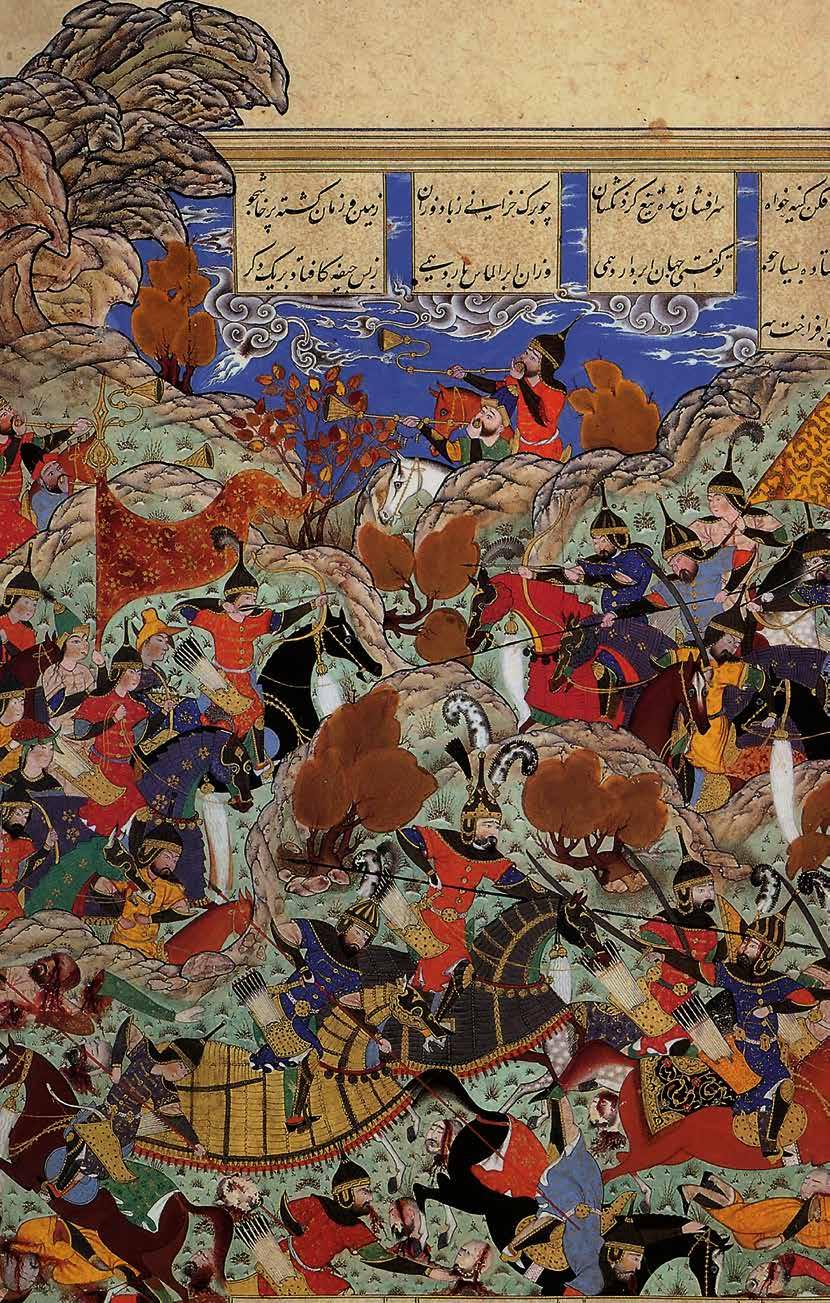
What was going through Timur’s mind at around 10 o’clock on the sun-scorched morning of 28 July 1402, when the Sword Arm of Islam found himself facing the massed ranks of the Ottoman army under Sultan Bayezid the Thunderbolt on a battlefield outside Ankara?
It is tempting to wonder because Timur, or Tamerlane, as we know him in the west – Handel’s Tamerlano – had spent the past three decades waging the bloodiest jihad imaginable against socalled ‘infidels’ – in fact they were no such thing, they were almost all Muslim – across Asia and the Middle East. He had never been defeated. And now here he was facing the leader of the Islamic world, a man who only six years before had routed a Crusader army at the Battle of Nicopolis.
Was his conscience pricked by any shame at the imminent prospect of yet more Muslim-onMuslim bloodletting? Somehow, I think not. Timur was above all an opportunist. You don’t get to build, single-handedly, an empire which rivalled that of Rome at its zenith without accommodating an internal contradiction or two along the way.
So what if his enemy was an exemplar of orthodox Sunni Islam? Sure, a Christian or Jewish enemy would have been preferable, but a Muslim enemy wasn’t the end of the world. Timur would have pointed out that his Muslim enemy had strayed from the one true path and needed to pay for his sins.
He had form here. When he rallied his men ahead of a Hindu-Kush-scaling campaign against India in 1398, he did so in the name of Islam. Never mind that his enemies were brother Muslims. “The sultans of Delhi have been slack in their defence of the Faith,” he told his princely amirs. So that was that.
And now here he was about to fight the biggest battle of his life.
War had been a while coming. Having blazed through the Balkans and put the cream of European chivalry to the sword at Nicopolis in 1396, Bayezid had been cutting a swathe through the east. Beginning in Samarkand, Timur had been doing no less to the west, conquering the (now Afghan) city of Herat in
1380 and continuing across Persia, Iraq, the Levant and into the Caucasus, subduing all before him. By the turn of the fifteenth century, both men had reached the point where any further conquest – to the east by Bayezid, to the west by Timur – would represent a direct encroachment on the other’s lands.
Diplomacy had run its course. For modern readers the diplomatic exchanges between these two titans of the Islamic world in the run-up to war are hugely entertaining.
“Believe me, you are nothing but a pismire,” Timur began one letter. “Shall a petty prince, such as you are, contend with us? But your rodomontades are not extraordinary, for a Turk never spoke with judgement.”
Bayezid was unimpressed. While the sultan was a “stalwart champion of the faith”, he replied, Timur was a “ravening dog”, “a brigand, a shedder of blood”. He ended with a threat bordering on the sacrilegious: “I know that this speech will rouse you to invade our countries, but if you should not come, may your wives be condemned to triple divorce.”
So war it was.
Timur’s confidence, as he surveyed his sprawling, multinational army, was high. By 1402 he had earned himself a host of monikers. He was Lord of the Fortunate Conjunction, Conqueror of the World, Emperor of the Age, Unconquered Lord of the Seven Climes. For Christopher Marlowe, a couple of hundred years later, he was the Scourge of God.
For the past thirty years his men and their sons and fathers had thundered through the continent. Through deserts, steppes and mountains the storm had raged, unleashing desolation on a fearful scale. One by one, the great cities of the East had fallen. Antioch and Aleppo, Balkh and Baghdad, Damascus and Delhi, Herat, Kabul, Shiraz and Isfahan had been left in flaming ruins. All had crumpled before his irresistible Tatar hordes. They had killed, raped, plundered and burnt their way through Asia and the Middle East, piling up the severed heads of their enemies into dreadful towers covered in oil and set alight as deadly warnings to anyone who might oppose them.
Timur’s army at Ankara, according to the fifteenth-century Syrian chronicler Ibn Arabshah, was a devastating sight. “Wild beasts seemed collected and scattered over the earth and stars dispersed, when his army flowed hither and thither, and mountains to walk, when it moved, and tombs to be overturned, when it marched, and the earth seemed shaken by violent movement.”

How big were the two armies? Very difficult to say. If you believe Johann Schiltberger, the Bavarian squire taken prisoner at the battle, it was (a wholly implausible) 1.6
million for Timur versus 1.4 million for Bayezid. A more recent estimate puts Timur’s army at 80,000 and Bayezid’s somewhere between that figure and 120,000.
By the time battle was joined it was already advantage Timur. He had outmanoeuvred Bayezid, disappearing into the Anatolian interior only to reappear in the camp his adversary had just abandoned on the most favourable ground. When the Ottoman army arrived after a series of forced marches the soldiers were “perishing with distress and violent thirst”.
Tode Mongke Khan and the Golden HordeTimur’s preparations went far deeper than that. Again and again in the sources the chroniclers pay tribute to his cunning. For several months he had been courting the Tatar tribes within Bayezid’s army. Playing on their tribal loyalties, he had offered them lucrative spoils on condition they switch sides when battle was joined.
Now Timur’s kettle-drums gave a tumultuous roar amid a deafening clash of cymbals and trumpets, a martial concert which routinely had been the harbinger of his enemies’ collapse. The princes of Persia had heard it, so too the khan of the Golden Horde, the kings of Georgia, the sultans of Delhi, Baghdad and Egypt. This time, they sounded Bayezid’s doom. It was one of the greatest battles the region had ever seen.
Ill-prepared, outmanoeuvred and outwitted, the exhausted Ottoman army began on the defensive. As the first blows fell, as the skies darkened with arrows, the desertion of Bayezid’s Tatar forces to Timur proved decisive. Undermined by these losses, the Ottoman left wing under Bayezid’s son Prince Sulayman Chelebi crumbled and fled. Consolidating these early advantages, Timur’s elite Samarkand division charged the Serbian cavalry, which had been devastated to see a prince of the royal blood abandon his position. Following his example, they withdrew in flight.
Bayezid’s resistance continued until nightfall, but Timur’s centre of 80 regiments and 30 elephants had already put paid to the main body of his army. After hours encircled by Timur’s forces, the Ottoman emperor’s Janissaries were finally overcome. Bayezid was seized and delivered to his enemy.
“From the Irtish and Volga to the Persian Gulf and from the Ganges to Damascus and the Archipelago, Asia was in the hands of Timour,” wrote Edward Gibbon. “His armies were invincible, his ambition was boundless.”
What happened next has, over the centuries, been a matter of huge interest and great contention –Handel even chose it as the centrepiece of Tamerlano Perhaps we can blame Marlowe for some of the uncertainty. As he wrote in his blood-drenched play Tamburlaine the Great, which opened in 1590:
The ages that shall talk of Tamburlaine, Even from this day to Plato’s wondrous year, Shall talk how I have handled Bajazeth...
Does the first-person refer to Tamburlaine or Marlowe? It matters because there are very different versions of what happened to Bayezid after the battle. Marlowe’s Tamburlaine uses Bayezid as a “footstool”, an unacceptable insult for any Muslim:
Base villain, vassal, slave to Tamburlaine, Unworthy to embrace or touch the ground That bears the honour of my royal weight, Stoop, villain, stoop!
Suicide is the only honourable option for the sultan, Marlowe providing the immortal stage direction: “He brains himself against the cage,” swiftly followed by his poor wife Zabina.
History was surely less dramatic, though we know that this was the sole instance in Ottoman history in which the sovereign ignominiously was captured in person. The debate over whether Bayezid was really thrown into a cage can be traced back to Arabshah, who claimed the sultan was bound in fetters, thrown in a cage and humiliated daily. Yet his use of the Turkic word ‘kafes’, which can mean either litter or cage, probably explains the confusion. More likely Bayezid was brought to Timur in a litter after the battle, a conventional mode of transport. Sharaf al din Ali Yazdi, the court panegyrist, unsurprisingly offers a version much more favourable to Timur in which Bayezid is treated with the utmost respect before his death in captivity in March 1403.
In truth, humiliating his vanquished opponents had never been Timur’s style. Typically he reinstalled them as vassal kings, which is precisely what he did with Bayezid’s sons. Sulayman Chelebi, who acknowledged Timur’s honourable behaviour towards his father in a letter, was given his father’s European lands and a capital at Adrianople. Isa Chelebi, another royal prince, was given northwestern Anatolia.
Either way, the days of Bayezid’s glory were over. Caged or not, the Thunderbolt had struck for the last time.
Justin MarozziHistorian of the Islamic world & author of Tamerlane: Sword Arm of Islam, Conqueror of the World
“As the first blows fell, as the skies darkened with arrows, the desertion of Bayezid’s Tatar forces to Timur proved decisive”



Editor Colin Jagger | Sung in English
Conductor John Andrews
Director Christopher Luscombe
Designer Simon Higlett
Lighting Designer Paul Pyant
Choreographer Ewan Jones
BOURNEMOUTH SYMPHONY ORCHESTRA
Leader Amyn Merchant
THE GRANGE FESTIVAL CHORUS
Chorus Master Tom Primrose
Assistant Conductor Chad Vindin
Assistant Director Laurie Slavin
Repetiteur Nicholas Bosworth

Fight Director Paul Benzing
Assistant Choreographer Lawrence Guntert
Production Manager Tom Nickson
Wardrobe Supervisor Karen Large CAST
Sir Richard Cholmondeley Lieutenant of the Tower John Savournin
Colonel Fairfax under sentence of death Nick Pritchard
Sergeant Meryll of the Yeomen of the Guard Graeme Broadbent
Leonard Meryll his son David Webb
Phoebe Meryll his daughter Angela Simkin
Jack Point a comedian Nick Haverson
Elsie Maynard a comedienne Ellie Laugharne
Wilfred Shadbolt Head Jailer of the Tower Nicholas Crawley
Dame Carruthers Housekeeper of the Tower Heather Shipp
Kate her niece Caroline Taylor
Captain Wilbraham David Menezes
Corporal Medcalf Pedro Ometto
Sergeant Murton Vladimir-Mihai Sima
Major Lewis Armand Rabot
First Citizen Joshua Baxter
Second Citizen James Wafer
Third Citizen Martins Smaukstelis
Fourth Citizen Samuel Knock
Chorus of Yeomen, Soldiers, Citizens of the Tower etc.
This production is supported by The de Laszlo Foundation | Cathy and Michael Pearman
6 July Opus Corporate Finance
Tower Green, July 1919
Early evening
Colonel Fairfax has been imprisoned in the Tower of London and sentenced to death. The daughter of one of the Yeomen Warders, Phoebe Meryll, is smitten with him, and consequently she’s rather irritated by the attentions of the Head Jailer, Wilfred Shadbolt, whose affection she returned before the arrival of the handsome Colonel.
Phoebe’s father, Sergeant Meryll, is delighted that his son Leonard has just been appointed a Yeoman as a result of his bravery on the battlefield, and he hopes that when Leonard arrives he might bring a reprieve for the Colonel. Sadly, this proves not to be the case. All three are eager to save Fairfax’s life and together they hatch a plan: Leonard will go into hiding, and the condemned man will disguise himself as the new Yeoman.
Fairfax enters, guarded by an escort of Yeomen. Sir Richard, the Lieutenant of the Tower, greets him sadly – they are old friends. The prisoner explains that he has been framed by his cousin, who stands to inherit his fortune if Fairfax dies unmarried. He therefore wishes to be married immediately to any amenable woman and thus foil his cousin’s wicked plot. He offers a financial reward and Sir Richard goes off in search of a potential bride.
Jack Point and Elsie Maynard, two travelling players, now appear, and they entertain the citizens of the Tower with a song and dance. In conversation with Sir Richard, they explain that Elsie’s mother is unwell, and they need funds to buy medicine. The Lieutenant seizes the moment and asks Elsie if she would be prepared to marry Fairfax before he dies. Jack has misgivings about this as he plans to propose to Elsie himself, but the financial inducement is too tempting for them both, and Elsie is led off, blindfolded, for the secret ceremony. The Lieutenant tells Jack that there’s a vacancy at the Tower for the ancient post of Court Jester, and they go off to negotiate terms.
The Yeomen appear and are thrilled to meet the new recruit, whom they fully believe to be the brave soldier, Leonard Meryll. Fairfax, in disguise, does his best to play along, but is nonplussed by the arrival of Phoebe, the sister whom, of course, he doesn’t recognise. Wilfred unwittingly saves the day, announcing that he hopes to marry Phoebe and, in the meantime, commends her to the care of her brother (the delighted Fairfax).
The hour has come for Fairfax’s execution, but when the Yeomen go to escort him from his cell, it’s found, to general consternation, that he’s absconded. Jack Point is distraught at the disappearance of Elsie’s husband – she is no longer free to marry him – and Elsie faints into the disguised prisoner’s arms. Everyone rushes off to hunt for Fairfax.
INTERVAL (100 minutes)
Two days have passed, and the search continues. Jack Point (now in his post as Court Jester) fears that he may have lost Elsie forever, since her husband is still at large. He falls into conversation with Wilfred, who confesses that he’s always had a hankering to go on the stage. This gives Point an idea. He says he’ll teach Wilfred all the tricks of the trade if Wilfred will swear that he shot Fairfax dead as he swam across the Thames. Wilfred readily accepts.
Fairfax, still disguised as Leonard Meryll, laments his hurried marriage to an unknown bride. Sergeant Meryll enters and tells him that Elsie, the girl who fainted in his arms, and who has been recuperating under his roof, has recovered. But he also explains that her illness gave Dame Carruthers, the Housekeeper of the Tower, an excuse to lodge there as well and to continue her unwelcome flirtation with him. Who should appear but the Dame herself, with evidence that Elsie is married to Fairfax. Fairfax, left alone on stage, is delighted to discover that his bride is none other than the beautiful Elsie. In his disguise as Leonard, he decides to make overtures to her and thus test her loyalty as a wife. Against her better judgement, Elsie resists ‘Leonard’s’ advances, and just when he is about to reveal his true identity, they are interrupted by the sound of a gunshot from the river.
Everyone rushes on and Wilfred, with Jack Point’s eager corroboration, declares that he saw Fairfax trying to escape and shot him dead. The Lieutenant orders the Yeomen to search for the body, and Wilfred is celebrated as a hero. Elsie, Fairfax, Phoebe and Jack are left alone, and Jack asks Elsie, as she’s now free, to marry him. But Fairfax, still disguised as the dashing Leonard Meryll, proves a more persuasive wooer, and he and Elsie run off together. Jack is devastated; he wanders off in despair. Phoebe, who knows Fairfax’s real identity and is desperately in love with him, is also disconsolate.
Wilfred appears and, seeing his beloved Phoebe in tears, tries to comfort her. In her anguish, she inadvertently reveals that ‘Leonard’ is in fact Fairfax. Realising that the game is up, she buys Wilfred’s silence by agreeing to marry him. The real Leonard then runs on to announce that Fairfax has been reprieved. Sergeant Meryll enters, followed surreptitiously by Dame Carruthers. Phoebe tells him of her indiscretion before leaving with Wilfred, whereupon Dame Carruthers emerges and threatens to expose the three schemers who freed Fairfax illegally. Sergeant Meryll reluctantly buys her silence with an offer of marriage.
Elsie joyfully arrives for her wedding to the man she still knows as Leonard, but the Lieutenant appears and announces that her husband, Colonel Fairfax, is alive and well. Fairfax himself then arrives, but Elsie, distraught that she’s unable to wed Leonard, can’t bring herself even to look at him. She begs to be free, but Fairfax claims her as his bride. Finally, she turns and sees that her husband is in fact the man she loves. As everyone rejoices, Jack Point returns, with tragic consequences.
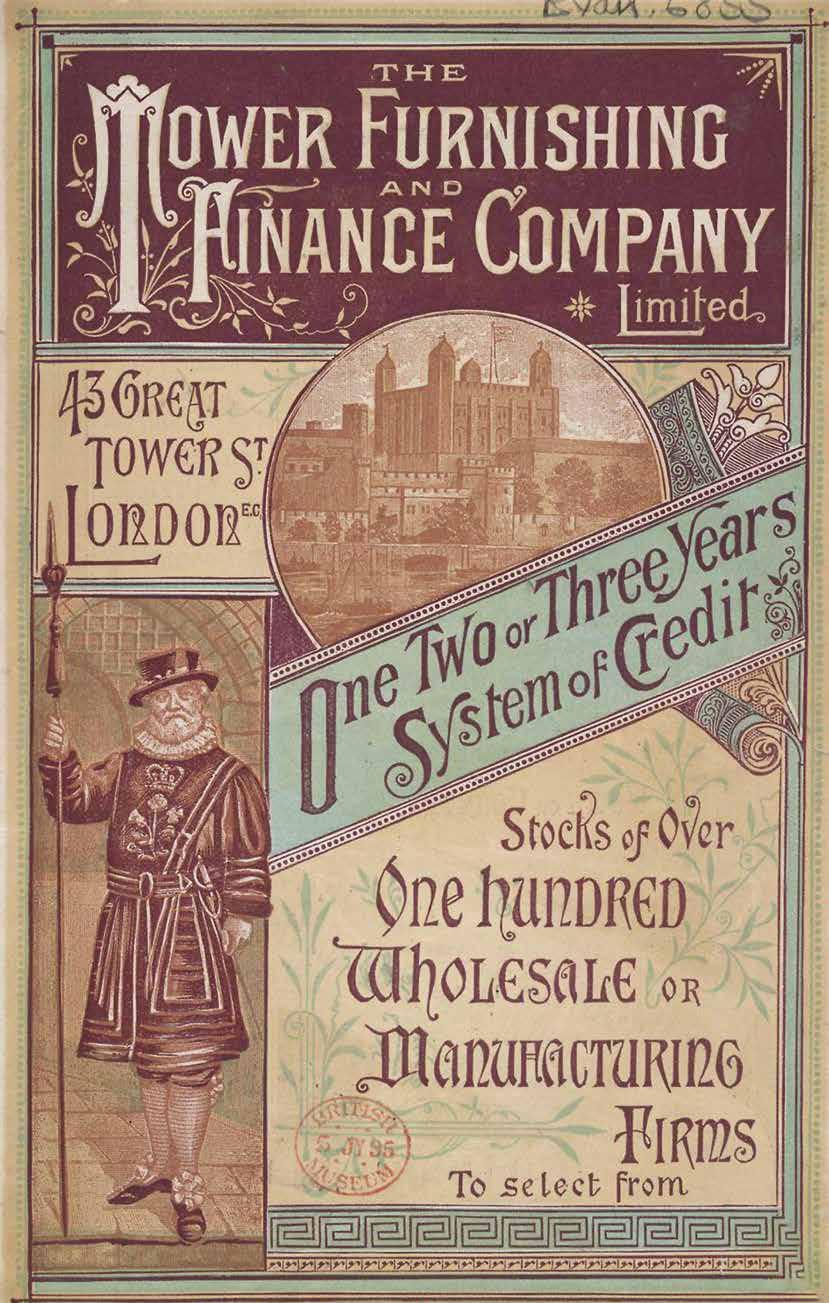
The Yeomen of the Guard is the nearest that Gilbert and Sullivan got to a grand opera. Both librettist and composer had a high opinion of the work. Gilbert told a newspaper reporter that he regarded it as ‘the best thing we have done’, and Sullivan said in an interview with the Strand Musical Magazine that he preferred it to any of their other collaborations.
Gilbert claimed that the inspiration for the work came to him while he was waiting for a train one morning at Uxbridge railway station and noticed a poster advertising the Tower Furnishing Company, which showed a beefeater against a background of the Tower of London. ‘I thought the beefeater would make a good picturesque central figure for another Savoy opera’, he later wrote, ‘and my intention was to give it a modern setting, with the characteristics and development of burlesque – to make it another Sorcerer. But then I decided to make it a romantic and dramatic piece, and to put it back into Elizabethan times.’
In fact, although this may explain the setting, he seems to have taken his plot from a French play, Don César de Bazan, by Adolphe d’Ennery and Philippe François Pinel, which had already formed the basis of the Irish composer William Wallace’s highly successful opera Maritana, first performed at the Theatre Royal, Drury Lane in 1845, and Jules Massenet’s rather less successful opéra comique, Don César de Bazan, which opened in Paris in 1872. Set in seventeenth century Spain, its central character is a popular knight who has been condemned to death by hanging for duelling during Holy Week. A royal pardon is maliciously intercepted but he is offered a soldier’s death by shooting rather than hanging if he marries a mysterious gypsy dancer. He does so and subsequently escapes being killed when a friend removes the lead shot from the pistol used for his execution. Don César escapes in disguise before eventually being reunited with his unknown bride.
Gilbert took this as his basic storyline, relocating the action to sixteenth century England and making the central character a handsome soldier unjustly accused of sorcery who is similarly condemned to death and marries an unknown bride, in his case to prevent a wicked cousin from inheriting his estate.
While working on the libretto in the autumn of 1887, Gilbert wrote to Sullivan: ‘It is quite a consistent and effective story, without anachronisms or pathos of any kind, and I hope you will like it’. Sullivan needed some reassuring as their most recent collaboration, Ruddigore, a take-off of Victorian melodrama, had not been a success and Gilbert had initially proposed as a sequel to it a return to the magic lozenge plot which he had used for their first full-length collaboration, The Sorcerer. Sullivan disliked this device, to which Gilbert kept returning, believing it to be silly and trivial and made clear his longing for a story that was more serious and romantic which would give him full scope for his considerable musical talents and not relegate him to what he regarded as his usual role as a mere rumpty-tumpty word setter. When Gilbert came round to his flat on Christmas Day 1887 to read him the outline of the proposed new piece, Sullivan was extremely relieved, noting ‘immensely pleased with it. Pretty story, no topsy-turvydom, very human and funny also’. At last, his librettist has provided him with a story of real drama and human emotion.
The composer rose to the challenge and provided some of his most powerful and dramatic music. The finales of both acts provide passages that are worthy of Verdi, notably in the Dies Irae like ensemble ‘Oh, day of terror! Day of tears!’ in Act 2. There are also apparently simpler songs in a much more recognisably English tradition like the unaccompanied Act 2 madrigal ‘Strange adventure!’ and haunting folk song style duet for Jack Point and Elsie Maynard, ‘I have a song to sing, O!’. Sullivan found this latter text more difficult to set than any other that Gilbert gave him.
The main difficulty lay in what he called its ‘House that Jack built’ character with an additional phrase being added to each verse. He spent a fortnight trying vainly to set it until Gilbert at last came to his aid by humming an old sea shanty which he had heard being sung by the sailors on board his yacht. After hearing a dozen bars, Sullivan exclaimed ‘That will do -I’ve got it’ and within an hour he had produced the tune that would become one of the opera’s greatest hits. Gilbert later commented, ‘I have sometimes thought that he exclaimed “That will do – I’ve got it” because my humming was more than he could bear; but he always assured me that it had given him the necessary clue to the proper setting of the song’.
Like several of Gilbert and Sullivan’s collaborations, the opera went through several changes of name. It was originally called The Tower of London. This was later changed to the Tower Warder and then to The Beefeaters. It was at Sullivan’s suggestion that The Yeomen of the Guard was finally adopted. As he so often did, Sullivan completed the score at the last moment and in a great rush. He wrote the overture in the auditorium during a final rehearsal and threw the parts to the players in the orchestra as he completed them. Tempers frequently flared between composer and librettist, and only an hour or so before the curtain went up on the first performance they had a somewhat stormy meeting to iron out some major production problems.
The first night, at the Savoy Theatre on 3 October 1888, was, however, an unqualified success. The Daily Telegraph spoke for critics and audience alike when it said of Sullivan’s score: ‘we place the songs and choruses in the Yeoman of the Guard before all his previous efforts of this particular kind. The music follows the book to a higher plane, and we have a genuine English opera, forerunner of many others, let us hope, and possibly a sign of an advance towards a national lyric stage.’ The original London run ended on 30 November 1889 after 423 performances. It was revived in 1897 and was subsequently seldom out of the D’Oyly Carte Opera Company’s repertoire.
There were successful runs in New York and Melbourne hard on the heels of the London opening and the opera received two early productions in German, the first of which opened at the Carlstheater, Vienna on 2 February 1889 with the curious title Capitän Wilson, and the second, entitled Der Königsgardist, in Berlin ten months later A D’Oyly Carte touring company took The Yeomen of the Guard to South Africa in 1896–7.
Twentieth century productions have included several staged outdoors at the Tower of London. Among the most memorable was one in 1978 as part of the festivities to mark the 900th anniversary of the Tower in which the rock-and-roll singer Tommy Steele played the part of Jack Point. There was a more recent production there in 2009 by Carl Rosa Opera as part of the Tower Festival. In 1995 a Welsh National Opera production conducted by Sir Charles Mackerras was taken to Covent Garden, where it became the first (and so far the only) complete Gilbert and Sullivan opera to be performed at the Royal Opera House.
Arthur Sullivan found The Yeomen of the Guard much more to his liking than his earlier and lighter collaborations with W S Gilbert and it strengthened his resolve to devote himself to serious opera. He was encouraged in this by Queen Victoria who told him after attending a royal command performance of his cantata The Golden Legend at the Albert Hall, ‘You ought to write a grand opera – you would do it so well!’ He was also encouraged by Richard D’Oyly Carte who began building his Royal English Opera House (now the Palace Theatre in Shaftesbury Avenue) in December 1888, just two months after Yeomen had opened at the Savoy. Commissioned to write its opening work, Sullivan asked Gilbert to supply the libretto, but he declined on the grounds that in grand opera the librettist’s role is subordinate to that of the composer, and that the public would, in any case, never accept a serious work from his pen. Sullivan turned to the American-born writer, Julian Sturgis, who set to work on a libretto based on Walter Scott’s novel Ivanhoe in the early summer of 1889. Meanwhile. Gilbert and Sullivan collaborated on The Gondoliers, their last really successful joint work, which opened on 7 December 1889. Sullivan’s Ivanhoe followed just over a year later. Despite having an initial run of 160 performances, it did not achieve the lasting success, and does not have the consistent quality, of The Yeomen of the Guard which remains the composer’s greatest and most dramatic operatic work.
Ian Bradley is Emeritus Professor of Cultural and Spiritual History at the University of St Andrews. His many books include The Complete Annotated Gilbert and Sullivan (Oxford University Press, 2016) and Sir Arthur Sullivan: A Life of Divine Emollient (Oxford University Press, 2021).


The Yeomen of the Guard, perhaps the deepest and darkest of Gilbert and Sullivan’s otherwise sunny satirical comedies, falls at a fascinating juncture in the arc of their collaborative work. Sullivan had recently celebrated the triumphant premiere of his serious cantata The Golden Legend, and a year later would complete his grand opera Ivanhoe. The darker and more ironic emotional tones of Yeomen reflect a deepening of the collaborators’ ambitions for their new opera.
Whereas most G&S operettas end with a happy and fortuitous resolution of their romantic entanglements, Yeomen does not. And this is because one of the central plots hinges on a protagonist who embodies the Jungian archetype of jester, trickster, fool: the figure of Jack Point. The comic, but morally and socially ambiguous, role of the jester has throughout history trod the same territory as that of theatre itself – a world of masks and trickery, of social and sexual rule-breaking, a licensed arena where anything is dangerously possible.
This is a world where an actor, a composer, a writer, can subvert the surface codes of his ‘official’ world, and through humour and irony, shock their audience into a new perspective and a new understanding. But being a privileged outsider with a licence to thrill may have its own price: that the jester is unable to be part of ‘normal’ society, is unable to enjoy its conventional comforts of love and marriage. The disruptive power and fascination of the jester contains the risk that simple, direct and honest emotional relationships become inaccessible for him. That the ambiguity of his ironic view of the world makes sincerity unthinkable, makes love impossible.
Looking back to the earliest forms of Western drama, the ancient Greek comedies of Aristophanes constantly disguise the venom of their political satire by the apparent buffoonery of the actor’s delivery. The anti-war sentiments of Lysistrata,
for example, could never be expressed directly and publicly in an open form, nor could the frequent slanderous personal attacks on leading figures be excused except in the context of the make-believe world of absurd comic theatre. Later, the ironic comedies of Menander, which led on to the Roman satires of Horace, also employ the ‘licensed fool’ to express otherwise unpalatable views through humour. Indeed the Dionysia festivals themselves, where such comedies were performed, represented, in their celebration of Dionsysiac freedom and anarchic chaos, a specially licensed time of the year where normal social and sexual rules might not apply.
In the medieval European world such organised drama did not exist, but the role of ‘licensed fool’ survived in jesters and fools, the personal comedians of royalty and aristocracy. These multitalented performers might well have excelled at singing, acrobatics, juggling and storytelling as well as comedy: the Norman French gestour, or jester, derives from words for singing and minstrelsy – as with Jack Point himself. And most European courts had their own stars for the nightly entertainment of the monarch and his guests.
However it was with the Renaissance, and the reinvention of organised theatre, that the jester rediscovered his unique value as an productive irritant or catalyst in drama. Shakespeare’s plays abound with ambiguous characters who move around and between the ‘official’ protagonists, tricking and turning them, guiding and twisting the labyrinths of the plot, as well as providing comic contrast and relief. Feste in Twelfth Night, Touchstone in As You Like It, Puck, in A Midsummer Night’s Dream, and the Fool in King Lear (the latter pair seen in recent years at The Grange) are all prime examples of dramatic pivots and catalysts, without whom their respective plays could never function.
“For there is humour in all things, and the truest philosophy is that which teaches us to find it and to make the most of it…”
Jack Point, Act I
Shakespeare’s development of the jester role is especially interesting as a change in casting led him into entirely new dramatic directions. The early plays were acted by Will Kempe, a conventional slapstick comedian with a tendency to improvise his own text. But when he departed the company, these roles fell to a genuine comic actor, Robert Armin, who was able to exploit pointed ironic humour in a far more lethal way. For him, Shakespeare wrote Touchstone (1599), Feste (1600), and finally, the Fool in King Lear (1605), taking the apparent lightness of the comic theme into far darker and more dangerous territory. Lear’s Fool, as noted by the Polish critic Jan Kott (in Shakespeare Our Contemporary), could easily be a character in, for example, a play by Samuel Beckett, so bitterly ambiguous and ironic is his humour.
In the following centuries, theatre in Britain stepped back from the intensity and danger of the Jacobean stage into a more social form of drama where extreme emotions rarely raised their heads openly. Nevertheless, the make-believe world of theatre continued to represent a playground where social and sexual rules could be tested and played with in a relatively safe environment. While European theatre dived headlong into the opportunities of Romanticism with Goethe and
Stiller, English theatre tended (with the exception of Shakespearean revivals) to the domestic world, a world where emotions could be exposed and expressed in a safely confined setting.
At a folk level, and in popular theatre, the jester found other outlets: in the rise of commedia dell’arte, with its plays derived from the varied employment of stock characters, and especially clowns. Characters, such as the German Till Eulenspiegel, appear throughout the folk traditions of the period, fulfilling the jester role for a new audience. Eulenspiegel’s stock stage prop, a mirror, is a witty embodiment of his role as someone who reveals to both actors and audience their true nature – a true reflection, like the Fool’s brutal revelations to Lear.

The eighteenth and nineteen centuries also saw the rise of opera as a key genre: a world which, by virtue of its structured artificiality (the ‘nonexistent’ orchestra, the characters who sing at each other), perhaps lends itself to manipulating the rules of its own game. From characters who can speak directly to the audience (Papageno? Leporello? Perhaps Alfonso?) to tricksters who precipitate the entire action (Loge’s temptation of Wotan?), opera has often found the jester a valuable and crucial disruptor and creative spark.
 English Elizabethan clown Will Kempe dancing a jig © Creative Commons / public domain
English Elizabethan clown Will Kempe dancing a jig © Creative Commons / public domain
And then there are the operas, such as Rigoletto and Pagliacci which specifically examine the double world of the jester himself, the way in which he cannot both break society’s rules and expect to live a normal life. Rigoletto’s attempts to defend a safe family space in which his daughter, Gilda, can lead a protected life are doomed by the ambiguities and moral double-crossing involved in his ‘professional’ life as a vicious jester. Likewise, Canio’s attempts to forge a happy, ‘normal’ marriage with Nedda are compromised by the pressures of theatre life, and finally the story of the play is tragically overtaken and invaded by the husband’s vengeance from ‘real life’.
In the modern period, the strongest support for Jung’s claim of the jester/trickster as a fundamental human archetype is the way in which this character has survived the loss of his historic habitats to reemerge as an essential figure in so many modern dramas and films. In the globally-successful series of Marvel/DC action films, based on Norse gods and legends, the role of Loki (the Loge of Wagner’s Ring Cycle) is central to every story, and is the only character to gain a spin-off series. Even in newly-invented myths, such as the Batman universe, it is not surprising that a key opponent is The Joker, whose ironic refusal to engage with Batman’s serious moral perspective reflects a fundamental human tendency to subvert or corrupt the established order through humour.
Perhaps the most modern jester figure of all is the stand-up comedian. This icon of our age embodies many of the facets of past jesters: although he is acting in a drama where all the other actors have disappeared, he is able to break the theatrical convention of the ‘fourth wall’ and be simultaneously a stage actor and a member of our audience world. An apparently sympathetic Everyman, who nevertheless punctures all our comfortable certainties with the ironic point (Point…) of humour, he represents a peculiarly modern variant of the jester as an antidote to the world of everyday order, a witty and dangerous threat to the powers that be. Hence the tight control of such figures in authoritarian societies, and their celebration where personal freedoms are highly valued.
The world of nineteenth century England was, by comparison with most of Europe, one of relative stability and economic success. English audiences were not experiencing vast shocks, like the catastrophic Gunpowder Plot which immediately preceded King Lear and resonates throughout the play as a risk of revolutionary breakdown and chaos. Despite Victorian problems, the world of Gilbert and Sullivan was one of relative calm and certainty, which enabled them to fashion a popular theatre of almost childish surrealism, with dramatic situations and plots which operate through a clockwork mechanism of ‘topsy-turveydom’, and which (as with any fairy tale) always result in an undisturbing Happy Ending for all concerned. The only time this overwhelmingly successful template shifted was when they chose, as a central protagonist, a jester, a trickster, a fool: Jack Point.
Despite being the audience’s favourite (and, tellingly, having the best music, repeated for the finale), Point is the ironic critic of his world, the outsider who, as professional jester, gets the best lines, but whom, ultimately, no-one wants. For irony cuts two ways: firstly it exposes the hypocrisy of all the other characters and the audience in their sentimental insistence on a Victorian happy end, and secondly, because if you live by irony, you cannot express your own emotions directly and honestly. Jack’s love for Elsie cannot be spoken openly. All he can do, in the ultimate dramatic irony of the operetta, is to tell in Act I the version of the story he would like to be true (‘The Merryman and his Maid’), where the girl would return to her honest lover, only to have it trumped by reality in Act II, where the girl remains married to her rich, aristocratic husband, and the Merryman is left with nothing but his tears.
Jesters never get the girl: the gap between the outsider and the world at which he laughs is the difference between ironic detachment and committed love. And it becomes the fatal fracture between Jack Point’s dream of his life and its final, fatal reality.
As Jack could have learned from Rigoletto and Canio, the jester who dares to love is doomed. He may have a song to sing-oh, but he is permitted nothing else.



MARCUS ROBERTS TRIO
Piano Marcus Roberts
Drums Jason Marsalis
Bass Rodney Jordan

—
Vocals and Wycliffe Gordon Multi Instruments with
BOURNEMOUTH SYMPHONY ORCHESTRA
Conducted by Gavin Sutherland
FIRST HALF
MARCUS ROBERTS TRIO & WYCLIFFE GORDON
INTERVAL (100 minutes)
SECOND HALF
ERIK SATIE
1st Gymnopédie (BSO only)
MAURICE RAVEL
Pavane pour une infante défunte
MARCUS ROBERTS
Seeking Peace
WYCLIFFE GORDON Solo
ROLAND GUERIN Solo
JASON MARSALIS
Solo
GEORGE GERSHWIN
Rhapsody in Blue

One might be hard-pressed to find an orchestral work more emblematic of New York City’s musical history than Rhapsody in Blue. As this vibrant work nears its centennial, this iconic chestnut of Gershwin’s remains one of the most beloved, recognized, performed, and imitated works in America’s musical canon.
It is all the more remarkable then, that its origin story tells a thrilling tale of rushed deadlines, a fly-bynight preparation by Gershwin, and even a partially improvised performance by Gershwin himself at the premiere. Approached by bandleader Paul Whiteman to prepare a Jazz concerto for an upcoming Experiment in Modern Music concert Whiteman had programmed, the legend tells us that Gershwin initially demurred. Undeterred, Whiteman proceeded forward, with Gershwin learning of the premiere via press announcement in January 1924, roughly five weeks before the February 12, 1924 concert! With rather limited lead time, the work that would ultimately become Rhapsody in Blue became, in its initial incarnation, a collaborative affair that combined Gershwin’s compositional genius with the arranging prowess and speed of Ferde Grofé (Whiteman’s chief arranger). In spite of rapid work, the opening night included unscored moments in which Whiteman, who conducted the band, simply had to look to Gershwin for the cue to bring the ensemble back in. Nevertheless, the performance proved a success, and a pivotal moment in the broader mainstream’s slow embrace of Jazz. The rest, they say, is history. Gershwin would follow up this work with later orchestral gems like the Concerto in F and An American in Paris (both works that put to bed any doubts as to his own arranging prowess), while Grofé himself would demonstrate his bona fides as a composer in his own right with the elegant Grand Canyon Suite
And yet, even as we near the piece’s 100th birthday, we find time and again that artists uncover new surprises in their performances, new items to explore. While the original work is not strictly Jazz, it draws so profoundly upon the burgeoning Jazz Age and the emerging big bands of New York City that its Jazz-infused soul has inspired generations of Jazz musicians to experiment with it, expand it, and improvise on it. Indeed, the piece would be revised again in Gershwin’s lifetime (1926) and yet again in 1942 to accommodate a larger orchestra. Rhapsody in Blue’s history is marked by reinterpretation and reimagination.
Here enters Marcus Roberts.
A pianistic hurricane whose virtuosity attained international renown in the mid-1980s as he spurred the small ensembles of Wynton Marsalis into a creative explosion, Roberts showed him as possessing of a remarkably expansive musical vision. A singular iconoclast in a world of followers, Roberts built up his Stride Piano chops while the rest of the Jazz piano world continued to relegate their left hands to rhythmic comping, and he embraced a full century’s worth of music in his playing. Roberts’ work has demonstrated time and again that the musical language of early forebears like Jelly Roll Morton and James P. Johnson deserve the same level of study and veneration as later figures like John Coltrane and McCoy Tyner. To hear Marcus Roberts play is therefore to recognize a broad and all-engrossing spectrum of black musical expression and to hear the many through lines that hold it together.
Roberts performing at Festival de Jazz de Vitoria in 2010 Photo by Alberto Cabello Mayero © Creative Commons“The performance proved a success, and a pivotal moment in the broader mainstream’s slow embrace of Jazz”
Perhaps it is no small wonder then that when Roberts recorded Rhapsody in Blue on his acclaimed 1996 release Portraits in Blue, we were granted a truly spectacular and utterly arresting new vision for the work. Drawing upon a deep knowledge of and love for the original work, Robert sought to enhance it with his own voice, building upon the brilliance of the music with a revised rhythmic and harmonic palette that make it feel as fresh and vital as it must have been at its premiere a century ago. As Roberts himself noted, Rhapsody in Blue was written before the musical revolutions of Louis Armstrong and of Duke Ellington. Given the expansive vision the original work embraces, and considering that its own history was marked by revisions, why not see how the ideas of Jazz’s legends might be brought to bear in a new approach?
While Rhapsody in Blue might be the work that brought you to the theater tonight, it sits nestled in an exquisite program of orchestral and small group

works. As Marcus Roberts takes the stage with his own ensemble, we are greeted with the opportunity to gain even further insight into the musical language that inspired Gershwin’s work. The Marcus Roberts Trio, with special guest Wycliffe Gordon, will offer a veritable master class in the unique musical style that sat so close to Gershwin’s heart.
In hearing Jazz performed by this ensemble of masters, we hear its Swing rhythm, that unique rhythmic pulse and heartbeat that is both elastic and unrelenting, a graceful and flowing meter that reveals the unique fusion of African and European traditions within America. As the individual musicians each take improvised solos, spinning out new melodies crafted in this moment and only for this moment, they also take part in another crucial part of Jazz’s story, the ability for artists to express themselves musically. Indeed, improvisation in Jazz enables the artists to tell their own stories, introducing you to their most deeply held ideas.
Wycliffe Gordon performing with Aarhus Jazz Orchestra 2018Lastly, Marcus Roberts’ wholehearted love for this music’s entire history ensures that his band’s performance is deeply rooted within the Blues aesthetic. Here, we delve into the very soul not just of Jazz, but of the vast array of American musical styles. This distinctive musical sound, descended from the musical heritage of Northwest Africa, blurs European notions of major and minor, happy and melancholy. Instead, it creates a complex and richly shaded experience, capable of holding a full suite of human emotions in its melodies, and therefore capable of expressing our hopes and frustrations simultaneously. This sound is felt throughout all strains of American popular music: as trumpet master Wynton Marsalis describes it, “the Blues was rural music made ‘city-fied’ by Jazz musicians and composers of American popular song. It was folk music, pop music, and fine art all at once.” Therefore, to hear and recognize the thread of Blues throughout American popular styles is to understand how the works of Delta musicians could inform the Ragtime brilliance of Scott Joplin, which could help shape the bravura of Jelly Roll Morton’s pianistic style, which in turn could help inspire the brilliance of Louis Armstrong’s trumpet song. George Gershwin certainly understood this, and Rhapsody in Blue in so many ways reflects his full-throated endorsement of it.
Gershwin’s New York City was one of transition, a time in which hundreds of thousands of African American families moved from the American South to New York, bringing with them an extraordinary array of musical and cultural traditions, melding them together in Manhattan neighborhoods like the Tenderloin, San Juan Hill, and Harlem. Cultural touchstones like Manhattan’s Black Bohemia at the turn of the 20th century; the Harlem Renaissance of the 1920s; and the rise of black musical theater, popular song, and dance orchestras all flourished as Gershwin himself came of age. The explosion of Black musical styles in New York City and the emergence of Gershwin’s unique songwriting are not coincidental in their timing: his work reflects fully the incredible musical landscape of his home. From the Stride Piano mastery of James P. Johnson to the songwriting genius of Eubie Blake to the big band mastery of Fletcher Henderson, Gershwin’s music reflects these many influences.
Tonight, these many threads will again be brought together, as the brilliant small ensemble swing of Marcus Roberts’ band will co-exist with the grandiose orchestral textures of Rhapsody in Blue. Watch tonight as Marcus Roberts unites these worlds, bringing a century’s worth of swing and improvisational vocabulary into a stunning and new reading of Rhapsody in Blue, a reading thoroughly faithful to the spirit of the original work, yet also faithful to Jazz’s embrace of the improvisational and the unexpected.
Seton Hawkins is a producer and educator based in New York City. He currently works for Jazz at Lincoln Center and the Juilliard School

“Robert sought to enhance it with his own voice, building upon the brilliance of the music with a revised rhythmic and harmonic palette that make it feel as fresh and vital as it must have been at its premiere a century ago”





Choreographer Jenna Lee
Composer Max Richter
Adapted from works by Antonio Vivaldi
Costume Design April Dalton
Lighting Design Andrew Ellis
Olivia Boyd
Giorgia Capogna
Eric Caterer-Cave
Daniel Corthorn
Jill d’Haene
Mischa Goodman
Natalia Kerner
Demelza Lesage
Camino Llonch
Tim Morgenstern
Xholindi Muçi
Mayuko Suzuki
Aitor Viscarolasaga Lopez
Sophie Allnatt (The Royal Ballet)
Luca Acri (The Royal Ballet)
DON QUIXOTE GRAND PAS DE DEUX
Choreographer Marius Petipa
Composer Ludwig Minkus
Dancers Haruhi Otani (English National Ballet)
Luca Acri (The Royal Ballet)
Artistic Director Karen Pilkington-Miksa
Assistant Director Daniela Cardim
Marketing & Communications Helga Brandt
Publicist Judy Lipsey
Development Intern Alice Sharp
Ballet Master Érico Montes
Production Manager Paul Godfrey
Stage Manager Chloe Astleford
Costume Coordinator Caroline Hagley
Costume Coordinator Lisa James
This production is supported by The Syder Foundation | Judy Quarry
Recomposed by Max Richter: Vivaldi – The Four Seasons
New English Ballet Theatre (NEBT) is a dynamic ballet company founded in 2010 by Artistic Director Karen Pilkington-Miksa as a reaction to a perceived lack of career opportunities for emerging ballet dancers and choreographers. A registered charity, NEBT’s mission is it to nurture and develop young talent in dance, choreography, music and design by providing high quality stage experiences in a nurturing company setting. No other UK company is focused solely on contributing to the development of new ballet choreography alongside emerging talent, and in the 12 years since its formation, NEBT has gained respect and recognition for its visionary, holistic approach to ballet making.

The 2022 dance programme at Grange Festival begins with one of the great classics of the traditional ballet repertoire, the Grand Pas de Deux from Don Quixote, a three-act ballet, based on the famous eponymous 17th-century novel by Miguel de Cervantes.
Although there are earlier versions, the most famous adaptation was created by the chief choreographer of St Petersburg’s Mariinsky Ballet, Marius Petipa, and Austrian-born composer, Ludwig Minkus.
Don Quixote was first premiered at the Bolshoi Theatre in Moscow in 1869. Petipa then restaged it in a far more opulent and grandiose production for the Mariinsky Ballet in 1871. The ballet was revived by Alexander Gorsky in 1900 and 1902, and although it was controversial at the time, Gorsky’s 1902 revival became the basis for all modern productions of Don Quixote
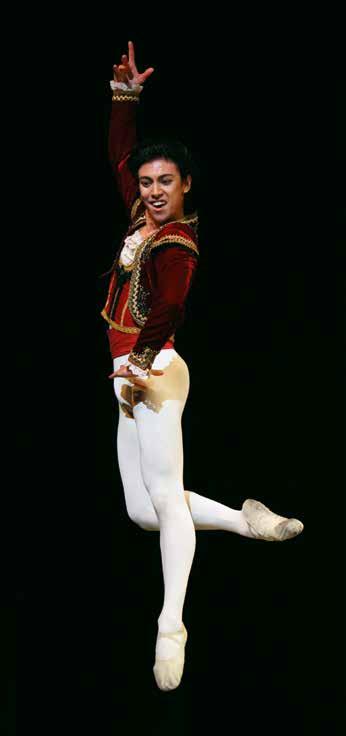
The famous Grand Pas de Deux is from the ballet’s final scene and takes place at the wedding banquet of Kitri and Basilio, the two lovers who achieve their happy ending despite the odds being stacked against them. It has become a favourite gala piece for virtuoso dancers all over the world; an opportunity to combine technical skills with distinctive characterisation even within the set structure of a classical pas de deux. The audience is set for a visual treat in which the ballerina and her partner playfully compete in their soaring jumps, bravura pirouettes and poised balances.
For the programme at Grange Festival, the roles of Kitri and Basilio are being performed by Haruhi Otani, Soloist at English National Ballet, and Luca Acri, First Soloist of The Royal Ballet.
Sources: petipasociety.com/don-quixote; canadaallstar.com/gala-programme/don-quixote
12 minutes
The Don Quixote pas de deux is followed by Jenna Lee’s contemporary ballet The Four Seasons (2017/18).

Written in 1721, Antonio Vivaldi’s four masterful violin concertos, famously known as The Four Seasons (Le quattro stagioni), each of which gives musical expression to a season of the year, may be the most widely heard piece of classical music ever composed.
Former English National Ballet soloist and choreographer Jenna Lee rejuvenates this much-loved classic into an elegant, abstract ballet, accompanied by Max Richter’s 2012 dynamic re-composition of Vivaldi’s score. The Four Seasons takes the audience on a stylish journey, carried through the splendour of the changing seasons as the dancers shift effortlessly from spring to winter. The music is familiar, even though Richter discarded some of Vivaldi’s score, looping and phasing the material he does use. The rich texture of the music is complemented by Andrew Ellis’s vivid lighting design and evocative costume designs by April Dalton.
“I really enjoy how familiar melodies do unexpected things, constantly taking you in different directions. Choreographically, I tried to show this with the dancers being swept from side to side, barely pausing for breath.
The texture in the music perfectly represents each season. The high-pitched plucking from the strings that sound like cold icy rain in winter contrasts beautifully with the balmy music representing a warm August evening.
I hope that this reinterpretation of a familiar work will lead existing audiences and new ones to engage and connect with the beauty of the ballet art form. Neoclassical in its ballet vocabulary, The Four Seasons will take the audience on a stylish journey; I think it’s a bold ballet and I’m very proud of it!”
— Jenna Lee on The Four Seasons (2018)
New English Ballet Theatre’s re-staging of The Four Seasons coincides with Max Richter releasing a new ‘Recomposed’ version, 10 years after Recomposed by Max Richter – Vivaldi, The Four Seasons made its impact on the world of classical music.
For the programme at The Grange Festival, the ‘Summer’ pas de deux is being performed by Sophie Allnatt, Artist of The Royal Ballet, who danced the part in NEBT’s 2018 season, and Luca Acri, First Soloist of The Royal Ballet.
Sources: Recomposed by Max Richter: Vivaldi, The Four Seasons – Doku, KlassikAkzenteYouTube channel; www.klassikakzente.de/max-richter
38 minutes




A co-production by Shobana Jeyasingh Dance and Sadler’s Wells London
Concept, Shobana Jeyasingh Choreography and Direction
Composer Act 1 Claudio Monteverdi
Composer Act 2 Kareem Roustom
New commission
Music Director/Conductor Robert Hollingworth
Assistant Music Director Naomi Burrell
Set and Costume Designer Merle Hensel
Lighting Designer Lee Curran
Video Designer Nick Hillel/YeastCulture
Sound Designer Fred de Faye
Tenor (Testo) Ed Lyon
Dancer (Clorinda) Jemima Brown
Dancer (Tancredi) Jonathan Goddard
Dancer Emily Thompson-Smith
Dancer Harriet Waghorn
Dancer Ellen Yilma
Rehearsal Director Estela Merlos
Deputy Rehearsal Director Catarina Carvalho
Harpsichord Robert Hollingworth
Violin 1 Jane Gordon
Violinist 2 Flora Curzon
Viola Francesca Gilbert (13 July)
Viola Elitsa Bogdanova (14 July)
Cello Gavin Kibble
Chitarrone Eligio Quinteiro

Production Manager Simon Sturgess
Re-lighter Nia Wood
Sound Engineer Fred De Faye
Video technician Ben Walden
Stage Manager Maz Bryden
Costume Supervisor Helen Lovett-Johnson
Artistic Director Shobana Jeyasingh
Executive Director Beth Cinamon
Creative Producer Emma Dunton
Company Manager Lise Smith
Head of Creative Learning Alice Odin
Head of Development Kate Knight
Finance Manager Chris Davis
Marketing and Mark Slaughter

Communications Manager
Press and PR Martha Oakes PR Administrator Zöe Grain
Harpsichord supplied by Simon Neal
Clorinda Agonistes is a co-production by Shobana Jeyasingh Dance and Sadler’s Wells London.
The work is generously supported by:
The Dr Michael and Anna Brynberg Charitable Foundation, Cockayne Grants for the Arts, a donor-advised fund at The London Community Foundation, Garcia Family Foundation, the Deborah Loeb Brice Donor Advised Fund at CAF, the Leche Trust, the Mila Charitable Organisation, Oak Foundation, the Royal Philharmonic Society with funding from the RPS Drummond Fund, and the Garfield Weston Foundation.
Shobana Jeyasingh Dance would also like to thank our Creative and Apsara Circle supporters.
Shobana Jeyasingh Dance is a National Portfolio Organisation funded by Arts Council England.
www.shobanajeyasingh.co.uk
Shobana Jeyasingh Dance, Somerset House, New Wing, Strand, London WC2R 1LA
After the interval, the second part of the evening also revisits a historical classic, but with an utterly different line of attack. The combative metaphor is deliberate: where Richter, Vivaldi and Lee are in harmony with each other, Jeyasingh is more interested in dissonance – those forces of tension and discrepancy that reveal a world not of coherence, but of contradiction. Her source score is Monteverdi’s Il Combattimento di Tancredi e Clorinda, first performed in 1624, a full century before the Vivaldi, for which Monteverdi too was spurred by the idea of conflict: he invented the now common, then innovative techniques of tremolo and pizzicato as means to evoke the turbulence and violence of battle. Indeed, Il Combattimento became part of a series (Songs of Love and War) that developed a concitato (“agitated”) style to contrast with the more temperate traditions of the time, and likened the struggles of the heart to those of war.


Monteverdi’s libretto is based on an episode in Torquato Tasso’s epic poem Gerusalemme Liberata, a fictionalised account of the first crusades. In this canto, the Christian knight Tancredi kills a Muslim warrior during a bitterly fought duel, not knowing that his opponent is in fact a woman, nor that it is Clorinda, with whom he has previously fallen in love. Tancredi slays Clorinda, but in her dying moments
she asks for water, so that she can be baptised.
In delving into this story, Jeyasingh finds a stark dissonance at its core. Retellings and portrayals commonly cast Clorinda and Tancredi as lovers, the killing as a tragedy of mistaken identity, and the baptism as Clorinda’s redemption, its reward being the promise of reunion with Tancredi in heaven. Yet in examining the Tasso text and Monteverdi’s libretto, Jeyasingh finds a different tale. Tancredi is besotted with Clorinda from afar, but they are not lovers; she doesn’t even know him. In battle Tancredi asks for her name; she refuses to give it, ferociously identifying herself only as his enemy who had burnt down the Christian’s hard-built siege tower, in a daring nighttime raid. Furthermore, that very morning Clorinda has discovered that she was born of an Ethiopian Christian princess – which slants the significance of baptism towards her mother, rather than Tancredi.
Retellings of the story have, then, remodulated the conflict between Clorinda and Tancredi into a more one-sided tale that casts him as protagonist, and her as willing lover, tragic victim and final convert. It’s as if the narrative, once dissonant, has become more diatonic, its internal discords now harmonised in favour of the male crusader. What is left of Clorinda?
Clorinda Agonistes – Clorinda the Warrior © Chris NashThe question is at the core of Jeyasingh’s brand new work Clorinda Agonistes, not a recomposition but a reimagining of its Monteverdi source. It is divided into two linked sections. The first follows Monteverdi’s music and story, and is interpreted by a narrator (tenor Ed Lyon, who also participates in the choreography) alongside Tancredi and Clorinda (dancers Jonathan Goddard and Jemima Brown). Its physical tensions indicate interpersonal dissonances, and the figure of Clorinda is neither lover nor victim but rather active combatant, fighting to assert her presence as a counter-narrative to those of the men.
In Jeyasingh’s version, Clorinda’s spirit does not ascend to heaven, but instead transmigrates, in the second section, to a twenty-first century theatre of war: the Middle East. A newly commissioned score by Syrian-American composer Kareem Roustom inhabits an Arabic musical world, its intoned and chanted melodies, polyrhythms and drones forming a very different soundscape from the classical European field of tonal harmony and metred time. Here, Clorinda is incarnated by four dancers so that she appears as both collective spirit and composite story, while the figures of the narrator and Tancredi are represented as documentary filmmakers from Europe, recording their view of the war. The struggle for control of the narrative continues.
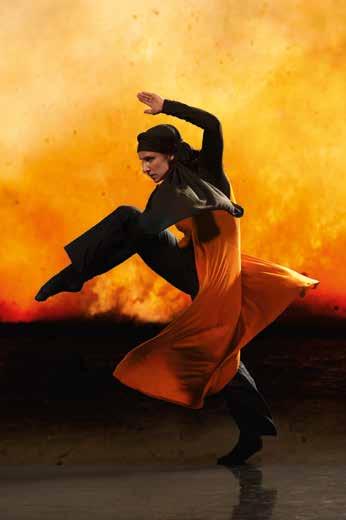

 Sanjoy Roy
Sanjoy Roy


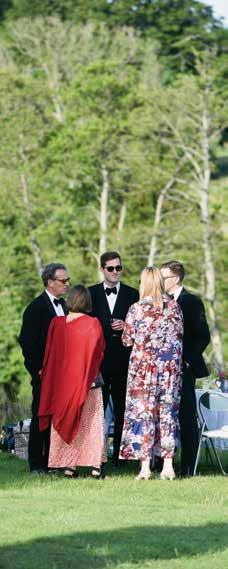






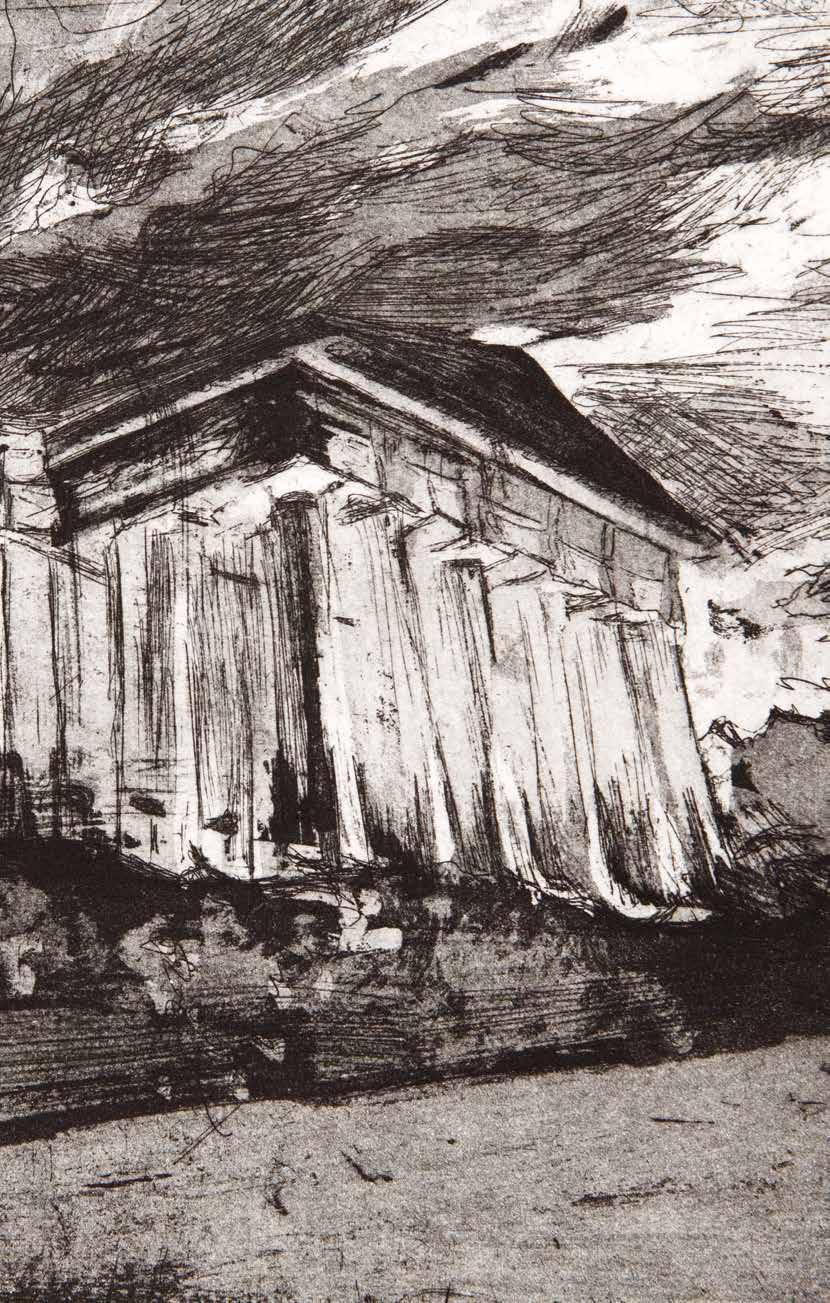
Rebuilt in the 19th century to resemble a Greek Temple, many of this year’s artworks at The Grange resonate with classical mythological references; themes of transformation, metamorphosis and the passage of time. Anthony Lloyd’s alabaster head references the Greek Cycladic era, while Nicola Godden’s sculpture in bronze represents Theia, the Greek Goddess of sight who endowed gold with its brilliance and value.
‘Mother of the sun, Theia of many names, for your sake men honour gold as more powerful than anything else’ – Pindar
David Williams-Ellis captures and transforms life in bronze with his Ram’s head, and Charlie Langton’s Ianus seems to have been touched by King Midas, as its surface cracks and transforms from bronze to gold.
Joanna Cohn’s series of ambitious multimedia paintings harness themes of the Midas myth to explore the consequences of human exploitation on the environment.

Midas, full of remorse was able to wash away his powers by bathing in a river. And so everything he touched was reclaimed by nature to its original state and life.
Johannes von Stumm’s Emptiness – Fullness, (Seated Figure), represents an embodiment of this restored emptiness and calm, which might be filled with light or darkness, hail, snow, sunshine.
At this time of political turmoil, we can, for a moment, stand in these rooms and gardens, and savour this once splendid house returning to the earth and to nature.
Joanna Cohn, Straighten your tie Hard ground, sugar lift and aquatint etching. 40 x 50cm framed, £320, 143 x 105cm, £1,600 archival print on canvas
Maryana is professional portraitist, fashion and beauty photographer, who uses monochrome and palettes derived from Caravaggio and Rembrandt. She enjoyed working with dancers; their bodies expressing simultaneous power and grace.

After the invasion of the Ukraine, Maryana left the country and is now working for The Grange Festival.

Elli Carr is a ceramic artist with a background in drawing and sculpture. She has been working with clay in a variety of ways for many years. After completing a Postgraduate Diploma in Sculpture at City and Guilds School of Art, she worked figuratively in clay and then bronze. She was awarded the De Laszlo Award for Portraiture and Madame Tussaud’s Award for Sculpture. Her work is currently on display at Jenna Burlingham Fine Art, Hampshire and she has recently shown work at the The Zuleika Gallery, The Broadway Arts Festival and Little Buckland Gallery. www.ellicarrceramics.com

 Ceramic Form (Orange)
Ceramic Form (Orange)

Joanna is a painter and printmaker who specialises in etching, multimedia painting and hybrid printmaking. Her work challenges traditional portrayals of landscape, finding new ways of recording place, scale and meaning. She is widely exhibited and recent exhibitions include, The Royal Overseas League, Royal Geographical Society, Mall Galleries. Woolwich Contemporary Art Fair and one of her larger works hangs in the Nasdaq HQ in New York. She has been selected as one of the artists to create a sculpture for The World Reimagined, a ground breaking national art project taking place this summer in cities across the UK that examines the Transatlantic slave trade.
For this years festival, Joanna has presents a series of multimedia paintings and etchings.
www.joannacohn.com
 Pactolus Valley Multimedia painting, 76 x 102cm
Pactolus Valley Multimedia painting, 76 x 102cm
Simon Cox is a journalist and photographer living in Gloucestershire whose work is primarily concerned with our perception of and relationship with the natural world. Micro becomes macro as intricate detail and pattern are revealed in this new edition of works produced specifically for the festival.

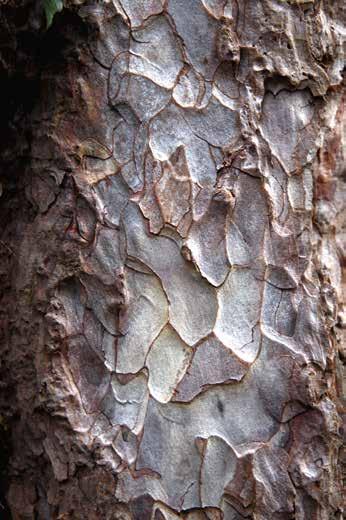 Typhon’s Scales
Aluminium print, 80 x 60cm | £1,200
Typhon’s Scales
Aluminium print, 80 x 60cm | £1,200
Nicola has been producing figurative sculpture, in bronze, for over 30 years. Large commissions have included ‘Icarus’ for the London 2012 Olympic Village, the ‘Sir Peter Scott’ sculpture in bronze for the London Wildfowl and Wetlands Centre in Barnes and ‘Hammersmith Man’ for the Hammersmith fly-over and ‘Survivor’ for Eastman Kodak HQ in the US. The bulk of Nicola’s work has been private work of various sizes exhibited in galleries in the United Kingdom, Ireland and the United States. www.nicolagodden.com


Trained in Fine Art at the Ruskin School of Art in Oxford, Jane Gordon Clark now enjoys a triple career as sculptor, artist and designer. Her art works are frequently exhibited in London galleries and she has had solo exhibitions at the Oxo Tower Gallery, The Orangery Gallery and The Exhibition Road Gallery. Her sculpture and art works are in private collections and public spaces in the UK, USA and Europe.

Jane is a former trustee of the V&A and of Heatherley’s Art School.
www.janegordonclark.co.uk
Environmental artist Mark Antony Haden Ford is known internationally for his woven sculptures from natural materials, and has created the 12m moustache and the circle of trees for previous Grange Festivals. The Oil Paintings on display are inspired by Kingley Vale where Mark spent much of his childhood, and is known for its twisted and ancient yew trees and includes a grove of veteran trees which are among the oldest living things in Britain. Many are older than 500 years old, within the South Downs national park. www.twocirclesdesign.co.uk


“Art has the power to change the way we view the world and questions our role within it”Dressed so darkly, 2018 Oil on canvas, 100cm x 100cm | £1200
Heather Jansch (1948–2021), was a renowned British sculptor whose lifelong passion was to achieve mastery of the equine form.
Her pioneering use of driftwood as a medium was frequently copied, but rarely rivalled.
Jansch spent many years perfecting the complex translation of her original driftwood works into bronze, establishing a technique that often made them indistinguishable from the original.
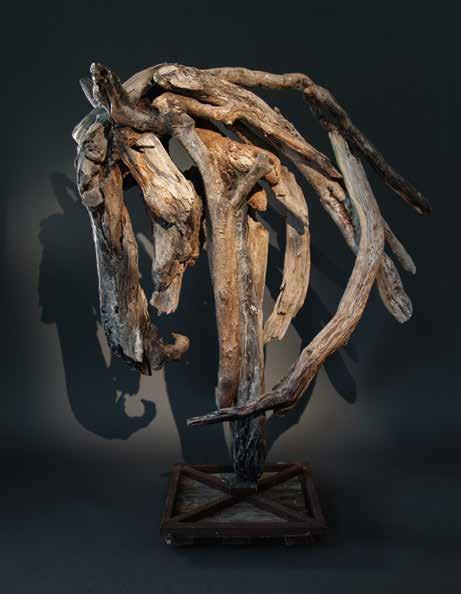
Her work is held in collections across the world. www.heatherjansch.com

Charlie Langton is committed to the Classical principles of the old masters, underscored by a thorough understanding of equine anatomy and a love for the horse.
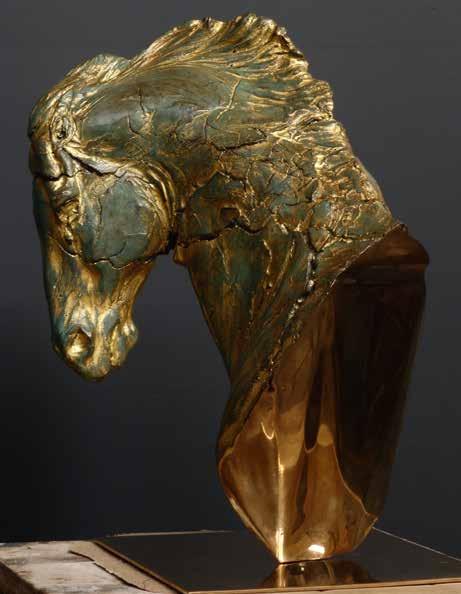
Major works include his bronze tribute to Gold Cup winner, Yeats, at Ascot Racecourse, unveiled by Her Majesty The Queen, and the mare and foal for Her Majesty The Queen’s 90th birthday statue in Newmarket. He collaborated with Asprey to create the silver Derby and Oaks Perpetual trophies for the Epsom festival. He continues to work on life-size commissions of the world’s best racehorses.
www.charlielangton.com
www.anthonylloyd.co.uk
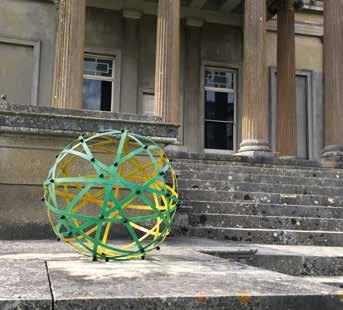
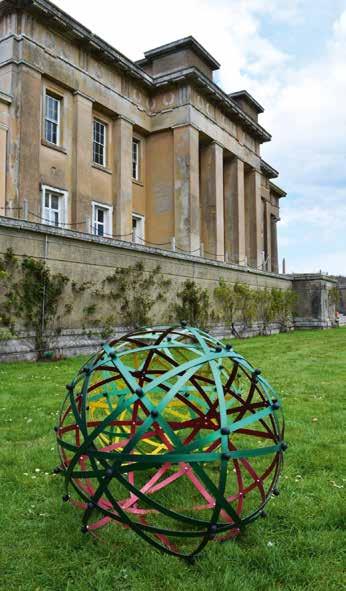 Anthony Lloyd is a sculptor and printmaker based in Oxfordshire. His work ranges from site-specific installations and sculpture, to traditional printmaking.
Anthony Lloyd is a sculptor and printmaker based in Oxfordshire. His work ranges from site-specific installations and sculpture, to traditional printmaking.
“We have all become increasingly aware of the way that we are connected, whether by risk of infection, by our responses to human suffering, by climate change and in many other physical or virtual ways”Everything is Connected Polycarbonate, 80cm diameter | £1,800

The Grange was first built in the 17th century and added to in the 18th and early 19th by Robert Adam and others, and remodelled in neoclassical style by William Wilkins. Around it, the pleasure grounds and terraces were laid out, looking over woodland and farmland, once worked and peopled, now empty – a landscape tamed and designed, a rural idyll. Now, most of us live in the city. I grew up in Clydebank; for me the stories of the land were of the Highland Clearances, and of mythical, dramatic mountainous terrain devoid of people. I was nine when I first saw paintings of workers in the field at Kelvingrove Art Gallery and Museum in Glasgow. Paintings by Courbet, Millet and Corot, the Barbizon School of painters in the mid 19th century who worked outdoors and – as Gainsborough and Constable had before them – populated their landscapes not with figures from classical myth but with real people, labourers working the land.
There are few, if any, figures to be seen now if you look out from the Grange. I have brought some back, repopulating the landscape with figures, twodimensional, black (for the moment at least), their poses taken from those famous nineteenth-century paintings. Upright shadows, in the middle distance. I have had this idea from since Art School “how much information does the eye need?” and it was The Grange that gave me the opportunity to realise it. www.vigogallery.com



 Shadows in the Landscape, 2019 Plywood, Black Paint
Shadows in the Landscape, 2019 Plywood, Black Paint
Gill Parker is an acclaimed sculptor with a passion for animals and nature.
Initially inspired by the early animalier artists, the forms of the natural world are her inspiration and motivation. Gill has developed a distinct and empathetic style, exploring a simplified focus on form and feel.
‘I don’t make sculpture to shock, make statements, or that need explanation, I make sculpture that is a ‘standalone’ thing of beauty, based on the perfect forms of nature’.
Gill has become a leader in the field of equine and wildlife sculpture with many major commissions to her name including the life-size bronze Motivator at Ascot Racecourse, the ‘Emirates’ bronzes, in-flight lounges around the world.
www.gillparker.com
 The Brewer’s Horse Height 102 cm (40″), length 120cm (47″) | £48,950 inc VAT
The Brewer’s Horse Height 102 cm (40″), length 120cm (47″) | £48,950 inc VAT
Johannes von Stumm’s “Seated Figure” embodies an emptiness which might be filled with light or darkness, hail or snow, rain or sunshine. It accepts quietly every moment of being.
Johannes von Stumm has a Diploma in Fine Art from the Academy in Munich/ Germany.

He is the President of the Oxford Art Society, a Founding Member of Sculpture Network Europe and a member of the Deutsche Kuenstlerbund in Berlin.
www.vonstumm.co.uk

“It is the spiritual energy of a piece of art which counts and nothing else”
Andy Waite’s contemporary land and seascapes are essentially expressionistic in form and energy. They are a poetic celebration of the English sky and weather in all their elemental power and their abstracted quality offers an ongoing dialogue that only slowly unfolds. Although his paintings originate from the Sussex countryside, his work embraces the freedom to explore an inner, symbolic landscape that reaches beyond pure geography. The dynamic play of light and darkness in nature is mirrored by the emotions driving the painting process, reflecting and re-imagining both the gentle and tumultuous landscapes of earth and soul.


Andy has been a practising artist for over 30 years and is widely collected both in this country and abroad. He is represented by several galleries across the UK and holds an annual open house exhibition at his studio in Arundel, West Sussex. He has published three books of images and accompanying poems, and his work and home have been featured in Country Living, Vogue, Country Homes & Interiors and 25 Beautiful Homes.
www.andywaite.net
David Williams-Ellis’ studied in Florence under the legendary octogenarian drawing teacher, Nerina Simi. He has exhibited at the Portland, Sladmore and Cadogan Contemporary galleries, and at many international shows in Japan, Hong Kong, California, and Europe.
Today his work can be seen in public spaces and buildings from Newby Hall, North Yorkshire, to Swires in Hong Kong. His D Day Sculpture was unveiled above Gold Beach in Normandy by the Prime Minister and the president of France to mark the 75th anniversary of D Day. www.dwe.com

 Ram Large Ram’s head | £149,000
Ram – detail
Ram Large Ram’s head | £149,000
Ram – detail
Maryana Bodnar had to leave her home and family in Ukraine. She has recently joined us at the Festival. Here is her journey…
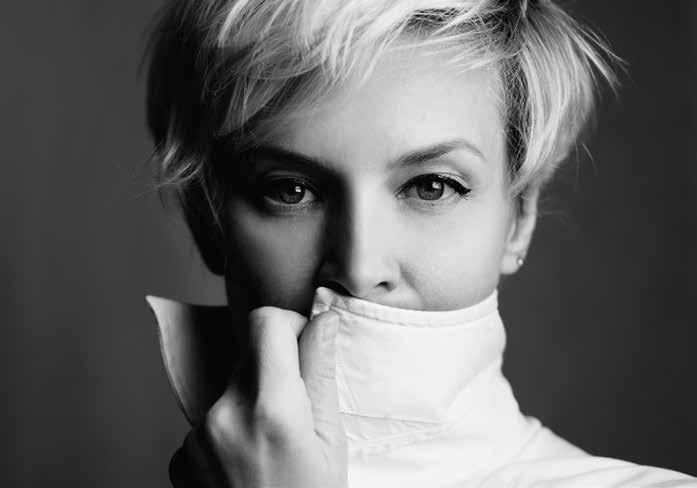
After the revolution of 2014 we (me and my husband) decided to return to Ukraine and become part of the growth of a new country. During the next 4 years I discovered a new amazing world of operetta, musicals, drama.
The 25th February there was supposed to be premiere of a new production, plastical drama by Italian director Matteo Spiazzi “The Bal”, where I had so many characters and a very dramatical story to express… but the day before the premiere, in the morning, at 4am while we all peacefully slept and waited for a new meeting on stage, we found ourselves under bombing…
On the 24th we left our home in the center of Kyiv. We went to the suburbs of Kyiv first, hoping to wait there. But that area where we were, Gostomel, Stoyanka, Bucha, Irpin, became the epicenter of the battle. Explosions, fighter jets overhead, panic, fear,
despair – that’s in a few words what I felt. It was the first day of the war. So, we decided to move further, to Western Ukraine. Endless roads in traffic jams. Enormous lines of people leaving their homes, trying to find a safer place to wait for a few days. We thought at the beginning that in a few days, a week some resolution will come.
Despite numerous invitations and offers of shelter in various European countries, I could not think of leaving Ukraine at first. But at the moment we offered a shelter in our house to one of my friends who escaped from Kyiv a few days earlier, only with one small bag and two cats, she was ready to go further, so I decided to try to see what’s behind the border... just for a few days and then back. Still remember the feeling on the border, at night (we took a night evacuation train to Budapest) in a crowded hall with people from destroyed cities and villages, with all that they could last minute grab from their homes and eyes full of tears, going nowhere. Many of them didn’t have international passports, many have never been abroad in their lives.
And at a certain moment for me. I am a person of Europe, lived there, traveled a lot, I feel very comfortable in any country I go… but even I felt this feeling of hopelessness and indistinctness. I was going to refuse, don't remember having such a panic attack. But my husband insisted and I made that step with other refugees into the embracement of openhearted people of Europe. From that moment started my unexpected voyage through different countries of people’s hearts, can't call it in another way. I really can't stop admiring people’s kindness and love they share, starting from the volunteers on the train station in Zahony and Budapest.
I was invited to come for a concert in Cologne and some other events. These possibilities to step up on stage were so important. From one side – I missed theatre, singing, stage so much, but from another, the most important – I could talk about Ukraine, about what we live and suffer now for this long period of almost three months, about our pain and fear. But also this was a possibility to say thank you to people in Europe that are so kind, generous, open-hearted and sincere to open their doors and hearts to absolutely unknown people.
Meanwhile, due to another long chain of different people, letters, communications and amazing opera web I found a sponsor family in London and an invitation to become a part of The Grange Festival. Couldn’t believe my happiness. As soon as I received my visa – I came to London. And here I am now.


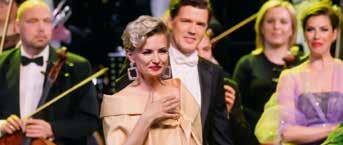
First of all I pray and hope for the victory of Ukraine in this cruel, unfair and very devastating Russian invasion, hopefully soon. The most important is to save people's lives and to get back our stolen by Russia lands. We are a very hardworking nation, we will rebuild the country quickly but till the last Russian boot steps away from our land that won’t be possible.
Recent years have taught me a lot not to plan anything for more than a day, sometimes a week, probably The Grange Festival will be an exception, since you never know what’s going to happen next minute and life can change in an instant. So I just accept with gratitude what the World offers me now, follow the flow of art, hope to see my husband and mom soon and pray for a better future.
However there’s few things that I really feel now… I am smiling again, I’m full of creative energy, I started singing, I started shooting with my camera and the most important – I started dreaming again. When I have a dream, there’s the way to get to it, there’s life and hopefully the future. Feel, like I’m healing.”
Maryana Bodnar
“From that moment started my unexpected voyage through different countries of people’s hearts”
From the moment I took up the French Horn at 10, all I have ever wanted to do is music. From 13 to 18 I played in two Youth Orchestras every weekend, one in Harrow and one in Surrey, (my poor parents!) plus five years in the National Youth Orchestra during the holidays. Music gave me a way to express myself, and the discipline, flexibility, teamwork and listening skills, fuelled my desire to give musical opportunity to others.
Eleven years in the horn section at Opera North gave me incredible experiences that no-one can take away. Sitting in the pit literally underneath John Tomlinson in the Coronation Scene of Boris Godunov, or Andrew Shore as Wozzeck (OMG), or Phyllida Lloyd’s production of Britten’s Gloriana with the incomparable Dame Josephine Barstow as Elizabeth I, the Act 3 Finale of la Gioconda (outrageous!), anything by Verdi or Puccini, or the joy when as a horn player you nail a performance of The Marriage of Figaro – surely one of the most glorious of all operas.
It also taught me that being a performer is hard, stressful, unglamourous most of the time and physically exhausting. Many musicians carry injuries when they play and mine – a playing related jaw injury – ended my horn playing career in 2000.

“I run the Bournemouth Symphony Orchestra”.
There is always a delay before whoever has casually asked me what I do whilst chatting on the train, at the garage, or in the shoe shop, responds. Sometimes I hear the words ‘wow that’s amazing’ or ‘incredible, I love the BSO’, or ‘they were the first orchestra I heard as a kid’, but just as often the reply is simply… a bemused smile…
Rarely is the delay because the person hasn’t heard of the BSO, it is much more that people think of arts and culture as ‘entertainment’, as ‘fun’, something that is just ‘always there’ rather than realising that the Creative Industries pre-pandemic were one of the fastest growing economic drivers in the UK and give employment to 1 in 11 of the UK workforce.
So, I guess in that context, someone does need to run it…
Thanks to the legendary General Director of Opera North, Richard Mantle, who saw something in me, I was given the opportunity to develop and grow as a Manager and then Director running the orchestra, chorus, and concert programme. In 2012 I was invited to apply for the CEO role at the Bournemouth Symphony Orchestra, leaving ON after 23 years at that remarkable company.
 Age eleven at Saturday morning music school Sartorial elegance from an early age!
Age eleven at Saturday morning music school Sartorial elegance from an early age!
So, my Day in the Life is all about making the case about why music, arts and culture, should and can be for everyone. Going back to the bemused smile when I say what I do; yes it’s entertainment, it is definitely fun but there is no guarantee that it will always be there.
BSO is very fortunate to have strong support from Arts Council England, Local Authority Partners and wonderful Corporate, Trust & Foundation and individual supporters. In a challenging postpandemic funding landscape, my role and that of my team and Trustees is to ensure we have the right people and enough financial resources so that BSO is here for this and future generations.
The BSO exists to bring music into people’s lives. Our Mission is ‘to be a Cultural Beacon at the heart of our communities’ and for the BSO that means communities across 10,000 square miles of the South and South West of England. So, whether that is a concert hall in Bristol, Exeter or Poole, a theatre in Alresford, Barnstaple or Truro, a school in Portsmouth or Yeovil, a community centre in the New Forest or the Isles of Scilly, or a care home in Bournemouth or Torquay, we use the power of music to enrich lives.

In a nutshell my role is to guide the strategy and lead the charge.
We hear in every performance the remarkable talent that there is in the BSO. There is also a brilliant Head Office team behind the scenes planning, administering, and supporting the delivery of our work, telling the story of the BSO to audiences, funders and stakeholders and ensuring BSO is run as a first-rate business and charity.
At a time when musical opportunities are reduced in schools, when the mental health challenges in our communities post-pandemic are more acute than ever, and when the isolation of lockdown has not gone away for so many, making the case for why music can help has never been more important. I see every week how our concerts across the region lift people’s spirits and when you see a child hearing an orchestra for the first time, you know that what we do makes the world a better place.
But we have the statistics too. We have shown that when one of BSO’s specialist community musicians is on an acute care ward of a hospital, the prescription of anti-agitation drugs reduces by 27%, levels of hydration in patients improve and staff report positively on how it makes them feel. As the Head Porter at one of Hampshire’s main hospitals said, “what you do you can’t put in a syringe”.
I have one other great passion which drives me, and helps me cope with a challenging day job, and that is running. There is simply nothing better at the end of a hard week than doing a long run round the Purbecks or the New Forest, or a Half Marathon round Richmond Park raising funds in the blue and orange colours of the Motor Neurone Disease Association.

At the BSO we all love our partnership with Grange and the strange little 10-year-old who took up the horn, can’t believe his luck that all these years later he is able to help keep the music playing.
Dougie Scarfe Chief Executive BSO The Richmond half marathon in 2019 One of 15 half marathons we did that year to raise money for the Motor Neurone Disease Association Opera North horn section, early 1990s“Our
heart of our communities”
Paul Pyant is a bear of a man – genial, reassuring, practical with a smile, and mercifully untheatrical –the sort of person you’d like to work with in the highly tense atmosphere of live theatre when surrounded by hysterical thesps, screaming queens and sopranos. He’s also determinedly modest having had a highly successful career spanning nearly 50 years and is adamant that ‘my whole career has been very fortunate happenstance’. The proof however is in his success; he was nominated for Oliver Awards for his designs for The Wind in the Willows (RNT 1991), Hamlet (2001), A Streetcar Named Desire (2003), All’s Well that Ends Well (2005), and the musicals The Lord of the Rings (2008) and Charlie and the Chocolate Factory (2014). He won the Olivier for the last of these.

Born just after the second World War in Croydon, he started life as a performer. His family had no television so they made their own entertainment all playing instruments and singing – Paul played the piano and sang much to his father’s delight, having named his son after his hero Paul Robeson. His father, an enthusiastic bass baritone himself, also encouraged Paul into the local professional operatic society, the Croydon Operatic and Dramatic Association ‘where we did the whole gambit, every single Gilbert and Sullivan that you could ever mention, probably still do most of them standing on my head… so that’s where the interest in theatre came from encouraged by my dad, up to the point when I decided I wanted to do it for a career, then he wasn’t so sure…’ (he laughs). Paul also had a good piano teacher and music master at school so music was quite important at that point. Not being a particularly academic child, music and theatre were his escape. ‘As long as you could play loo paper over a comb, you were in the orchestra.’
As he explored theatre and music his interest increased and he took every opportunity he could. The Croydon Operatic and Dramatic Association used the Ashcroft Theatre in Croydon for their productions ‘and I sort of wheedled my way in there and started doing ‘get in’s’ and ‘get out’s’ – anything like that as a school boy earning extra pocket money. I remember ‘dressing’ for the Pocket Theatre Company when I was about 15 or 16 and there was a group called the Croydon Youth Theatre and I was quite politically active at that time – socialist, and we formed our little theatre group doing what these days we’d call Woke things like Alan Plater’s Close the Coalhouse Door.
Ambitiously he applied for RADA which bemused his parents so ‘I then launched into my other interest, farming.’ Paul’s aunt and uncle had a farm outside Rye with 5,000 free-range Rhode Island Red chickens, another passion of his (he still chickensits a friend’s chickens in his garden in Lewes). ‘The same day I was meant to have an interview as a jobbing reporter on Farmers Weekly I actually got accepted for Rada which was extraordinary.’
Against huge competition, 5 places with about 2,000 applicants Paul was accepted on the stage management course finding himself more at home back stage having had a bit of experience in the Ashcroft Theatre. The course covered everything, building sets, running shows, wardrobe, lighting, props and over four terms he did about 40 shows. ‘It was very hard work and I just loved it. At nighttime I used to sleep on the fly floor amongst all the black tabs because I was commuting from home and there was so much to do…’ His passion for lighting was sparked during a production of Oedipus Rex and RADA asked him to stay on an extra term as a member of staff. RADA then was run by a formidable lady called Dorothy Tenham and ‘it was dictated from the top what was happening so I was informed one day I had an interview. I hadn’t applied for this job and it turned out to be a totally unknown organisation called Glyndebourne…’. As luck would have it, he didn’t get the job as an assistant stage manager but he’d mentioned during his interview his interest in
lighting and they did have a vacancy in the lighting department. He got the job and ‘was suddenly in the lighting department at Glyndebourne in 1974 and it was something of an epiphany. They were in stage and orchestra when I arrived and they didn’t know quite what do to with me so they sent me to box 6 in the old theatre to watch the rehearsal, see what I thought. It was Calisto with Ileana Cotrubas and Annie Howells, and I was absolutely blown away, it was just one of the most magical things I think I’d ever seen and I’ve never looked back since – opera has been my passion.’
Through his contacts at Glyndebourne and RADA, Paul advanced into the world of lights and theatre. Glyndebourne was only seasonal from April till August with a short TV season and touring programme until October/November. Paul neatly filled up is year by becoming company stage manager for Kent Opera through a contact from Rada, Noel Staunton who was their technical director. Kent had a winter and spring tour.
His big break came with the newly established New Sussex Opera who were producing big shows for the Brighton Festival. Paul lit their first show, Boris Godunov and was invited back the following year to light Peter Grimes directed by an unknown director Nick Hytner. Paul was originally booked to production manage the latter but the week before the lighting designer discovered he was double-booked so ‘it fell to me to light the show for Nick so that was a bit of a baptism but that led Nick to use me the following year when he did Queen of Spades and then Nick was offered a Handel opera at the Coliseum called Xerxes and that was my first go at a big theatre.’
Artistic talent which Paul says ‘was just always there’, combined with considerable practicality and composure have produced this lighting legend. He explains ‘You have to understand where you are physically, and your imagination has to understand what the space is. At Glyndebourne there is a basic rig which you can add and subtract from. If it’s a musical, you have to imagine the whole thing from scratch and you have to order every piece of equipment, and then you can suggest to the director and designer how to make it better, and you can point out it’s going to be difficult in this space to have this window here because there aren’t the positions to have light coming through the window – all practical things – it’s all about managing expectations ultimately. Eventually when you have a good relationship with a director you’ve worked with for many years like Peter or Trevor Nunn, or Nick Hytner or Sam Mendes – all those sort of people they get to rely on you and know your kind of taste and it sort of evens out’.
Paul knows Yeoman of the Guard well having been in the chorus line as a Yeoman at the tender age of 14… He shouts with laughter and bursts into song:
This the autumn of our life, This the evening of our day; Weary we of battle strife, Weary we of mortal fray.
But our year is not so spent, And our days are not so faded…
Further proof of Paul Pyant’s huge success over the years is the starry list of directors (some mentioned above) and designers he’s worked with about which he says ‘I’ve been very lucky to hang onto the coat tails of these people…’. Furthermore, that he’s still around in a business in which the technology has evolved beyond all recognition is a formidable achievement. ‘When it used to be me turning up with my hammer, screwdriver and my spanner it now has to be a team of programmers and people with expertise on all the new equipment we have – it’s a minefield – I can’t just turn up and say turn that light on because I don’t even know how to turn the lights on anymore…’
‘Similarly, Peter Hall at Glyndebourne had seen me around and I was assisting John Bury doing things like Dream. He rang to say he was doing a West End show and was stood up by his lighting designer for a little production of a Tennessee Williams play called Orpheus Descended starring Vanessa Redgrave…’
Last year Paul lit all 3 shows at the Grange due to Covid restrictions with other lighting designers. This year he’s only lighting The Yeomen of the Guard which means he must plug in his show to two other designers’ rigs. The lighting manager of the Grange, Teresa Nagel must therefore ‘manage all our expectations but luckily she was a student of mine at RADA so I can get a head start there…’ he smiles.
“You have to understand where you are physically, and your imagination has to understand what the space is”
BOARD OF TRUSTEES
Chairman
Tim Parker
Nicholas Allan
Lord Ashburton
Daniel Benton
Sophie Caruth
Caroline Greenhalgh
Rosamund Horwood-Smart QC
Malcolm Le May
Richard Morse
COMPANY
Chief Executive & Artistic Director
Michael Chance CBE
Director of Artistic
Administration
Scott Cooper
Chief Operations Officer
Michael Moody
Production Assistant
Kimberley Munroe
Director of Development
Rachel Pearson
Head of Partnerships
Lucy Futter
Finance Manager
Annabel Ross
Head of Marketing
Alice Blincoe
Box Office Manager
Caroline Sheahan
Dining Administrator
Sofia Quick
Box Office & Dining Assistant
Daisy Norwood
Director of Learning
Susan Hamilton
AMERICAN FRIENDS OF THE GRANGE FESTIVAL
BOARD OF TRUSTEES
Executive Director and Trustee
Sarah Jones Baker
Secretary
Emily Andrewes
WARDROBE
Head of Wardrobe
Ben Ryder
Dep Head of Wardrobe
Serica Kavaz
Dressers
Phil Couch
Mae Smith
Julia Wojciechowska
Michele Beiny Harkins
Anthony Haller
ADVISORY BOARD
Leigh Biddlecome
Molly Boynton
Piers Playfair

THANK YOU
Louise Verrill
Brown Rudnick LLP
Events and Education Co-ordinator
Harriet Taylor
Production Manager
Tom Nickson
Company Manager
Jonathan Gosling
Front of House Manager
Rachel Hannyngton
WIGS Head of Wigs
Lottie Davies
Dep head of Wigs
Shealyn Caulfield
Wig/make up
assistant
Elizabeth Fisher
Wig/make up assistant
Hannah Sinclair
STAGE
Technical Manager
Ben Nickson
Head of Props
Robyn Hardy
Surtitle Operator
Izzy Thorn
Deputy Technical Manager
Tim Turnbull
Deputy Technical Manager
James Boyd
Crew
Carys Davies
Johan Beavis-Berry
Hannah Morrison
Matt Miles
Jack Hayward
Matt Rudkin
LIGHTING
Head of Lighting
Teresa Nagel
Chief Lx
Paul Millford
Dep Lx/Programmer
David Ayton
Dep Lx
Paddy Hepplewhite
LX Support
Sam House
Jonathan Blunsdon
TRANSPORT
Transport by
Paul Mathews
GROUNDS MAINTENANCE
Caretaker of The Grange
Richard Loader
John License
Colin Luff
Judy Bishop
Jude Mezger
Jo Seligman
Di Threlfall
Felicity Urquhart
MARQUEES & PAVILIONS
John M Carter Ltd
Phil Heather
SITE STRUCTURES
John Waterworth
Richard Morgan
Michael Odysseos
Joel Shepherd
Steve Turner
Mike Holland
FLOOR PAINTING
John Waterworth
CLEANING E & E Services
FESTIVAL SHOP
Festival Shop Manager
Lucy Baring
Festival Shop
Assistant
Ellie Perry
Illustrator
Tilly Perry
FESTIVAL VOLUNTEERS
Head of Volunteers
Nicky Cambrook
Judy Bishop
Hugh Brown
Sue Brown
Jan Burgess
Nick Cambrook
Henrietta Cooke
Ruthie Coombs
Pru de Lavison
Karin Doresa
Ann Gilbertson
Martin Gillie
Jenny Gove
Andrea Harris
Wendell Harris
Natalia Hazeldine
Mary Hogg
Lizzie Holmes
Sally Johnston
Lynwen JonesThomas
Penelope Kellie
Sue Kennedy
Anne Lain
Angela Larard
Derek Lintott
Susie Lintott
Catherine Maddock
Jenny Makins
Brigid McManus
Belinda Mitchell
Peter Paice
Sue Paice
Di Peisley
Caroline Powell
Jane Powlett
Clare Read
Jo Seligman
Katherine Sellon
John Theophilus
Marie-Caroline
Theophilus
Hilary Trickle
Felicity Urquhart
Sarah Vey
FIRST NIGHT AND DINING FLOWERS
Caroline Perry
Jane Powlett
PR & MARKETING
Valerie Barber
Jacqueline Whitbread
SOCIAL MEDIA
Social Media Manager
Leela Bennett
IT SUPPORT
Chelsea Connected Dudley Rees
DINING@THEGRANGE
BECKA COOPER
@THE GRANGE
Ali Booth
Georgia Beech
Victoria Blashford-Snell
Kirsty Dowling
Mark Emmerson
Tim & Penny
Cooper
Colin La Fontaine
Jackson
Amanda Stebbing
Sofia Quick
DESIGN &PRINTING
Design and Identity
Jon Ashby at wearenoun.com
Programme Printers
Generation Press
HEALTH & SAFETY
Health and Safety Consultant
John Young
ACCOMMODATION
GENEROUSLY DONATED BY
Daniel & Alison Benton
John & Wendy Trueman
Sarah & Peter Vey
Royston & Tana Riviere
SPARKLING WINE
The Grange Sparkling Wine
Zam Baring
Claire Hunt
WINE
Stone, Vine & Sun
Simon & Alison Taylor
THE TEA PAVILION
Winchester Hospice
Sabrina Marsden
Katie Harrington
Julie Luke
1ST VIOLIN
Leader
Amyn Merchant
Mark Derudder
Edward Brenton
Kate Turnbull §
Karen Leach §
Magdalena Gruca-Broadbent
Kate Hawes §
Stuart McDonald
Joan Martinez
Jennifer Curiel §
2ND VIOLIN
Carol Paige *
Dmitry Khakhamov
Vicky Berry §
Lara Carter §
Rebecca Burns
Agnieszka Gesler
Janice Thorgilson
VIOLA
Tom Beer *
Miguel Rodriguez Ω
Jacoba Gale §
Liam Buckley
Eva Malmbom
Judith Preston §
1ST VIOLIN
Leader
Amyn Merchant
Mark Derudder
Edward Brenton
Karen Leach §
Magdalena Gruca-Broadbent
Tim Fisher §
2ND VIOLIN
Carol Paige *
Dmitry Khakhamov
Vicky Berry §
Lara Carter §
Agnieszka Gesler
CELLO
Jesper Svedberg *
Thomas Isaac
Hannah Arnold
Philip Collingham
Sally Flann
DOUBLE BASS
David Daly §
Nicole Boyesen §
Jane Ferns §
FLUTE
Anna Pyne *
Owain Bailey
PICCOLO
Owain Bailey *
OBOE
Edward Kay * §
Holly Randall
COR ANGLAIS
Holly Randall
CLARINET
Barry Deacon *
Helen Paskins
BASSOON
Tammy Thorn *
Kim Murphy
HORN
Alexander Wide Ω
Ruth Spicer §
Robert Harris §
Kevin Pritchard §
TRUMPET
Paul Bosworth
Peter Turnbull §
TROMBONE
Kevin Morgan * §
Robb Tooley
BASS
TROMBONE
Kevin Smith §
TUBA
Jonathan Riches
TIMPANI
Geoff Prentice
PERCUSSION
Matt King * §
Ben Lewis
Alastair Marshallsay
HARP
Eluned Pierce * §
KEY
* Asterisk denotes Section Principal
§ denotes Long Service Award
Ω denotes Diversity Champion
VIOLA
Tom Beer *
Miguel Rodriguez Ω
Liam Buckley
Eva Malmbom
CELLO
Jesper Svedberg *
Thomas Isaac
Philip Collingham Ω
DOUBLE BASS
David Daly * §
Jane Ferns §
FLUTE
Anna Pyne *
Owain Bailey
RECORDER
Olwen Foulkes
Caoimhe de Paor
OBOE
Edward Kay * §
Holly Randall
BASSOON
Kim Murphy
HARPSICHORD
Robert Howarth
Jonathan Darbourne
THEORBO
Paula Chateauneuf
1ST VIOLIN
Leader
Amyn Merchant
Mark Derudder
Edward Brenton
Kate Turnbull §
Tim Fisher §
Kate Hawes §
Julie Gillett-Smith §
Stuart McDonald
2ND VIOLIN
Carol Paige *
Dmitry Khakhamov
Vicky Berry §
Lara Carter §
Agnieszka Gesler
VIOLA
Tom Beer *
Miguel Rodriguez Ω
Jacoba Gale §
Judith Preston §
CELLO
Jesper Svedberg *
Thomas Isaac
Hannah Arnold
Philip Collingham Ω
DOUBLE BASS
David Daly * §
Nicole Boyesen §
FLUTE
Anna Pyne *
Owain Bailey
PICCOLO
Owain Bailey *
OBOE
Edward Kay * §
CLARINET
Barry Deacon *
Helen Paskins
BASSOON
Tammy Thorn *
Kim Murphy
HORN
Alexander Wide Ω
Edward Lockwood §
TRUMPET
Bob Farley
Peter Turnbull §
TROMBONE
Kevin Morgan * §
Robb Tooley
BASS TROMBONE
Kevin Smith §
TIMPANI
Geoff Prentice
PERCUSSION
Matt King * §
Ben Lewis
1ST VIOLIN
Leader
Amyn Merchant
Mark Derudder
Edward Brenton
Kate Turnbull §
Karen Leach §
Magdalena GrucaBroadbent
Jennifer Curiel §
Tim Fisher §
Julie Gillett-Smith
Kate Hawes §
Joan Martinez
Stuart McDonald
2ND VIOLIN
Carol Paige *
Dmitry Khakhamov
Richard Thomas
Emma Lisney
Vicky Berry §
Lara Carter §
Rebecca Burns
Agnieszka Gesler
Janice Thorgilson
VIOLA
Tom Beer *
Miguel Rodriguez Ω
Jacoba Gale §
Liam Buckley
Eva Malmbom
Judith Preston §
CELLO
Jesper Svedberg *
Thomas Isaac
Hannah Arnold
Philip Collingham Ω
Kate Keats
DOUBLE BASS
David Daly * §
Nicole Boyesen §
Jane Ferns §
FLUTE
Anna Pyne *
Jenny Farley
OBOE
Edward Kay * §
Holly Randall
CLARINET/
Barry Deacon *
Helen Paskins
BASS CLARINET
Chris Goodman
ALTO SAXOPHONE
Kyle Horch
Amy Green
TENOR SAXOPHONE
Melanie Henry
BASSOON
Tammy Thorn *
Kim Murphy
HORN
Alexander Wide Ω
Ruth Spicer §
Robert Harris §
Kevin Pritchard §
Edward Lockwood §
TRUMPET
Bob Farley
Peter Turnbull §
Ed Sykes
TROMBONE
Kevin Morgan * §
Robb Tooley
BASS
TROMBONE
Kevin Smith §
TUBA
Elliot Launn
TIMPANI
Geoff Prentice
PERCUSSION
Ben Lewis
Alastair Marshallsay
HARP
Eluned Pierce * §
BANJO
Mitch Dalton
FOR THE BOURNEMOUTH SYMPHONY ORCHESTRA
Chief Executive
Dougie Scarfe
Head of Concerts & Artistic Planning
Heather Duncan
Head of BSO
Participate
Lucy Warren
Head of BSO
Participate (Maternity)
Bea Hankey
Head of Marketing
Anthony Brown
Concerts Manager
Annie de Grey
Orchestra Manager
Liz Williams
Deputy Orchestra Manager
Adam Glynn
Senior Stage Manager
Scott Caines
Stage Manager
Kat Wallace
PRODUCTION TEAM
Conductor
Francesco Cilluffo
Director
Maxine Braham
Designer
Madeleine Boyd
Lighting Designer
Matt Haskins
Associate
Choreographer
Francesco
Mangiacasale
Assistant Conductor
Tom
Fetherstonhaugh
Assistant Director
Rachel Wise
Repetiteur/ Language Coach
Valeria Racco
Fight Director
Xavi Monreal
Chorus Master
Tom Primrose
Stage Manager
Sam Lambounre
Deputy Stage Manager
Elizabeth Barry
Assistant Stage Manager
Grace Moore
Wardrobe Supervisor
Caroline Hughes
CAST
Macbeth
Gezim Myshketa
Lady Macbeth
Judith Howarth
Banquo
Jonathan Lemalu
Macduff
Samuel Sakker
Lady-in-waiting
Katie Lowe
Malcolm
Andrés Presno
Doctor
Timothy Dawkins
Servant
James Wafer
Assassin
Tiziano Martini
1st Apparition
Pedro Ometto
2nd Apparition
Isabel Maria Araujo
3rd Apparition
Grace O’Malley
Duncan
Xavi Monreal
Fleance
Kai Patel
Dancers
Electra
Liam John Hill
Angela McIntosh
Justyna Sochaj
Anna Emilia Yliaho
Young Apparitions
Holly Dodgson
Sion LlywelynDavies
Kirsty Louw
Laurie Westlake
Florence LlywelynDavies (cover)
Ben Lown (cover)
CHORUS
Soprano
Isabel Maria Araujo
Isabelle Atkinson
Corina Ignat
Elena Garrido
Madrona
Grace O’Malley
Caroline Taylor
Mezzo-soprano
Deirdre Arratoon
Rebecca Barry
Angharad Davies
Rebekah Jones
Amy Kerenza
Sedgwick
Miriam Sharrad
Tenor
Joshua Baxter
Michael Gibson
Samuel Knock
David Menezes
Vladimir-Mihai Sima
Martins
Smaukstelis
Bass
Tiziano Martini
Johannes Moore
Pedro Ometto
Armand Rabot
Andrew Randall
James Wafer
Conductor
Robert Howarth
Director
Daniel Slater
Designer
Robert Innes Hopkins
Lighting Designer
Johanna Town
Assistant Conductor & Repetiteur
Jonathan Darbourne
Assistant Director
Louise Bakker
Language Coach
Alessandra Fasolo
Stage Manager
Tanith MacKenzie
Deputy Stage Manager
Siobhan MacIntyre
Assistant Stage Manager
Grace Moore
Wardrobe Supervisor
Josie Thomas
Conductor
John Andrews
Director
Christopher Luscombe
Designer
Simon Higlett
Lighting Designer
Paul Pyant
Choreographer
Ewan Jones
Assistant Conductor
Chad Vindin
Assistant Director
Laurie Slavin
Assistant
Choreographer
Lawrence Guntert
Repetiteur
Nicholas Bosworth
Chorus Master
Tom Primrose
Stage Manager
Di Holt
Deputy Stage Manager
Katie Bingham
Assistant Stage Manager
Jack Sheffield
Wardrobe Supervisor
Karen Large
CAST
Sir Richard Cholmondeley
John Savournin
Colonel Fairfax
Nick Pritchard
Sergeant Meryll
Graeme Broadbent
Leonard Meryll
David Webb
Phœbe Meryll
Angela Simkin
Jack Point
Nick Haverson
Elsie Maynard
Ellie Laugharne
Wilfred Shadbolt
Nicholas Crawley
Dame Carruthers
Heather Shipp
Kate
Caroline Taylor
CAST
Tamerlano
Raffaele Pe
Bajazet
Paul Nilon
Asteria
Sophie Bevan
Andronico
Patrick Terry
Irene
Angharad Lyddon
Leone
Stuart Orme
Captain Wilbraham (1st Yeoman)
David Menezes
Corporal Medcalf (2ndYeoman)
Pedro Ometto
Sergeant Murton (3rd Yeoman)
Vladimir-Mihai Sima
Major Lewis (4th Yeoman)
Armand Rabot
First Citizen
Joshua Baxter
Second Citizen
James Wafer
Third Citizen
Martins Smaukstelis
Fourth Citizen
Samuel Knock
CHORUS
Soprano
Isabel Maria Araujo
Isabelle Atkinson
Corina Ignat
Elena Garrido Madrona
Grace O’Malley
Caroline Taylor
Mezzo-soprano
Deirdre Arratoon
Rebecca Barry
Angharad Davies
Rebekah Jones
Amy Kerenza
Sedgwick
Miriam Sharrad
Tenor
Joshua Baxter
Michael Gibson
Samuel Knock
David Menezes
Vladimir-Mihai
Sima
Martins Smaukstelis
Bass
Tiziano Martini
Johannes Moore
Pedro Ometto
Armand Rabot
Andrew Randall
James Wafer
PRODUCTION TEAM
Producer
Piers Playfair
Producer
Frankie Parham
Stage Manager
Di Holt
Deputy Stage Manager
Katie Bingham
CAST
Piano
Marcus Roberts
Drums
Jason Marsalis
Bass
Ronald Guerin
Vocals & Multi Instruments
Wycliffe Gordon
Orchestra Bournemouth Symphony Orchestra
BAROQUE COUNTERPOINT DANCE@THE GRANGE
PT1 THE FOUR SEASONS | NEW ENGLISH BALLET THEATRE
CREATIVE TEAM
Choreographer
Jenna Lee
Composer
Max Richter
Costume Design
April Dalton
Lighting Design
Andrew Ellis
DANCERS
Olivia Boyd
Giorgia Capogna
Eric Caterer-Cave
Daniel Corthorn
Jill d’Haene
Mischa Goodman
Natalia Kerner
Demelza Lesage
Camino Llonch
Tim Morgenstern
Xholindi Muçi
Mayuko Suzuki
Aitor Viscarolasaga
Lopez
GUEST DANCERS
Luca Acri (The Royal Ballet)
Sophie Allnatt (The Royal Ballet)
Haruhi Otani (English National Ballet)
DON QUIXOTE GRAND PAS DE DEUX
Choreographer
Marius Petipa
Composer
Ludwig Minkus
NEW ENGLISH BALLET THEATRE TEAM
Artistic Director
Karen PilkingtonMiksa
Assistant Director
Daniela Cardim
Marketing & Communications
Helga Brandt
Publicist
Judy Lipsey
Development Intern
Alice Sharp
PT2 CLORINDA AGONISTES | SHOBANA JEYASINGH DANCE
MANAGEMENT TEAM
Artistic Director
Shobana Jeyasingh
Executive Director
Beth Cinamon
Creative Producer
Emma Dunton
Company Manager
Lise Smith
Head of Creative
Learning Alice Odin
Head of Development
Kate Knight
Finance Manager
Chris Davis
Marketing and Communications Manager
Mark Slaughter
Press and PR
Martha Oakes PR
Administrator
Zöe Grain
CREATIVE TEAM
Concept, Choreography & Direction
Shobana Jeyasingh CBE
Composer
Kareem Roustoum
Music Director/
Condictor
Robert Hollingworth
Assistant Music Director
Naomi Burrell
Set & Costume Design
Merle Hensel
Lighting Design
Lee Curran
Video Design
Nick Hillel/ YeastCulture
Sound Design
Fred de Faye
Rehearsal Director
Estela Merlos
PERFORMERS AND CREATIVE COLLABORATORS
Tenor (Testo)
Ed Lyon
Dancer (Clorinda)
Jemima Brown
Dancer (Tancredi)
Jonathan Goddard
Dancer
Emily ThompsonSmith
Dancer
Harriet Waghorn
Dancer
Ellen Yilma
Rehearsal Director
Estela Merlos
Deputy Rehearsal Director
Catarina Carvalho
Ballet Master
Érico Montes
Production Manager
Paul Godfrey
Stage Manager
Chloe Astleford
Costume Coordinator
Caroline Hagley
Costume Coordinator
Lisa James
MUSICIANS
Harpsichord
Robert Hollingworth
Violin 1
Jane Gordon
Violinist 2
Flora Curzon
Viola (13 July)
Francesca Gilbert
Viola (14 July)
Elitsa Bogdanova
Cello
Gavin Kibble
Chitarrone
Eligio Quinteiro
PRODUCTION
Production Manager
Simon Sturgess
Re-lighter
Nia Wood
Sound Engineer
Fred De Faye
Video technician
Ben Walden
Stage Manager
Maz Bryden
Costume Supervisor
Helen LovettJohnson

NEW ENGLISH BALLET THEATRE
DANCE – FOUR SEASONS/DON QUIXOTE
Luca Acri is a First Soloist of The Royal Ballet. Acri began his training at the AcriHorimoto Ballet Academy in Japan, and was a finalist for the 2010 Prix de Lausanne. That year he entered The Royal Ballet Upper School and graduated into the Company during the 2012/13 Season, promoted to First Artist in 2014, Soloist in 2015 and First Soloist in 2019.

Acri’s repertory with The Royal Ballet includes Hans-Peter/ Nutcracker (The Nutcracker), Franz (Coppélia), Mercutio (Romeo and Juliet), Alain (La Fille mal gardée), Puck (The Dream), Bluebird and Florestan (The Sleeping Beauty), Lescaut and Beggar Chief (Manon), Henry Clerval (Frankenstein), Bratfisch (Mayerling), lead pas de six and Hilarion (Giselle), Benno (Swan Lake), and roles in Solo Echo, Dances at a Gathering, Jewels, Symphonic Variations, Within the Golden Hour, Chroma, Woolf Works and Asphodel Meadows. He has created roles in Liam Scarlett’s The Age of Anxiety and Symphonic Dances, Hofesh Shechter’s Untouchable, Wayne McGregor’s Obsidian Tear and The Dante Project
Luca is performing by kind permission of The Royal Ballet.
DANCE – FOUR SEASONS
Sophie Elizabeth Allnatt is an artist at The Royal Ballet Company. She was born in Essex and trained at The Royal Ballet School from the age of 9. As a student at White Lodge, she was awarded the April Olrich Award for Dynamic Performance. Whilst at upper school Sophie toured with The Royal Ballet Company and performed with Birmingham Royal Ballet.
Sophie has danced professionally in four companies, including Scottish Ballet, New English Ballet and Ballet Magdeburg. Sophie joined The Royal Ballet Company in 2018, where she has performed as Clara (The Nutcracker) The White Cat (The Sleeping Beauty) and Cygnet (Swan Lake).

Sophie is performing by kind permission of The Royal Ballet.

THE YEOMEN OF THE GUARD
John Andrews is Artistic Director of Red Squirrel Opera, Conductor-inAssociation with the English Symphony Orchestra and Principal Guest Conductor of the UK’s National Symphony Orchestra. His recording of Malcolm Arnold’s The Dancing Master for Resonus Classics won the BBC Music Magazine Opera Recording Award 2021.
Notable engagements include Wolf Ferrari’s Susanna’s Secret with OHP (nominated for the 2020 International Opera Awards), Tolomeo, Don Giovanni, Anna Bolena, Pia de’ Tolomei, Elisabetta and Seraglio for English Touring Opera, the Garsington Opera production of Hansel and Gretel at West Green House, a debut performance of La Cenerentola for the Garsington Festival, The Mikado for Co-Opera, Cosí fan tutte for English Chamber Opera, Orfeo ed Euridice at St John’s Smith Square and Offenbach’s Robinson Crusoe for Opera della Luna at the Iford Festival For Stanley Hall he has conducted The Barber of Seville, Eugene Onegin and a double bill of Mozart’s Der Schauspieldirektor and Pagliacci. In Europe he has conducted Die Entführung aus dem Serail in Rostock, Germany, and he is a resident conductor for Opéra de Baugé where he has conducted Lucia di Lammermoor, Riccardo Primo, Don Pasquale, Die Entfürung aus dem Serail, La traviata, Giulio Cesare, La bohème and Il barbiere di Siviglia. As assistant to Andrew Litton he prepared Der fliegende Holländer for Den Nye Opera with the Bergen Philharmonic.
His interest in neglected English music has resulted in a recording of Sullivan’s complete incidental music to The Tempest and Macbeth with the BBC Concert Orchestra and the BBC Singers issued on two separate CDs by Dutton Epoch, and Gilbert/Cellier’s opera The Mountbanks for the same label. Sullivan’s oratorio The Light of the World was released in December 2018. He gave performances of newly discovered works by Sir Malcolm Sargent with the Leicester Symphony Orchestra and the premier of Percy Sherwood’s Double Concerto for Violin and Cello with the English Symphony Orchestra at the English Music Festival, which has also be recorded. In 2018 he made his debut at the London Handel Festival conducting Arne’s Judgement of Paris,
which he subsequently recorded for Dutton. He recently recorded works by Christopher Wright with the Royal Scottish National Orchestra. As part of his commitment to education work, he has conducted the Royal Philharmonic Orchestra in the West End Live Festival, and he recently conducted Will Todd and Maggie Gottlieb’s children’s opera Alice’s Adventures in Wonderland at the London College of Music and for OHP. He lectures for the Cambridge Music Hubs programme, has devised a schools project with the Blackheath Conservatoire, and has lectured at the Elgar School of Music on the birth of English Opera. Born in Nairobi, and brought up in Manchester, he took up conducting at the age of 17, studying with Michael Trowski, Colin Metters, Alan Hazeldine and now with David Parry. He continued his professional development at the Bela Bartok Centre for Musicianship, and has taken part in conducting classes in the Czech Republic, and at the National Opera Studio. John Andrews was the recipient of the Leonard Ingrams Memorial Award 2012 from Garsington Opera, and was awarded the special ‘Orchestra Prize’ at the First Bela Bartok Opera Conducting Competition in Romania in 2005. He completed a doctorate on the political and religious world of eighteenth-century oratorio. Opera plans include The Merry Widow for OHP. He will also record Sullivan’s oratorio The Martyr of Antioch with the BBC Concert Orchestra and BBC Symphony Chorus.
TAMERLANO
Supported by Roger Mayhew
Recognised as one of the leading lyric sopranos of her generation Sophie Bevan studied at the Royal College of Music where she was awarded the Queen Mother Rose bowl for excellence in performance. She was the recipient of the 2010 Critics’ Circle award for Exceptional Young Talent, The Times Breakthrough Award at the 2012 South Bank Sky Arts Awards, Young Singer award at the 2013 inaugural International Opera Awards and was made an MBE for services to music in the Queen’s Birthday Honours in 2019.
She works regularly with leading orchestras worldwide and with conductors including Sir Antonio Pappano, Daniel Harding, Andris Nelsons, Edward Gardner, Laurence Cummings, Sir Mark Elder, Ivor Bolton and Mirga Gražinytė-Tyla. Recent and future highlights include Ah! Perfido, The Seasons and Ryan Wigglesworth’s Augenlieder all with the London Philharmonic Orchestra, Strauss’ Four Last Songs with the Philharmonia, Les Illuminations with the BBC Philharmonic Orchestra, the Aurora Orchestra and the Finnish Radio Symphony Orchestra, Faure Requiem and Haydn Nelson Mass with the Netherlands Radio Philharmonic, Schubert Mass no 6 at the Concertgebouw, Messiah with the Orchestra of the Age of Enlightenment, Gluck Orfeo ed Euridice at the Edinburgh Festival, an evening of Viennese repertoire with the BBC Concert Orchestra at the 2020 BBC Proms Festival and Knussen’s Songs and a Sea-Interlude with the Swedish Radio Orchestra. An acclaimed recitalist she has appeared with pianists including Julius Drake, Malcom Martineau, Ryan Wigglesworth, Christopher Glynn and Graham Johnson at the Concertgebouw, Amsterdam and the Wigmore Hall in London.
Sought after for her work in opera Sophie’s recent and future engagements include Ilia Idomeneo, Sophie Der Rosenkavalier, Susanna Le nozze di Figaro Dalinda Ariodante and Pamina Die Zauberflöte at the ROH, title role The Cunning Little Vixen for WNO, Hermione in Ryan Wigglesworth’s The Winter’s Tale and Télaïre Castor and Pollux for ENO, Ginevra Ariodante for the Bolshoi Moscow, Melisande Pelleas et Melisande for Dresden
Semperoper, Freia Das Rheingold at Teatro Real, Madrid and Governess
The Turn of the Screw in the acclaimed production for Garsington Opera. She made her debut at Glyndebourne Festival Opera as Michal Saul and at the Salzburg Festival and Metropolitan Opera as Beatriz in Thomas Adès’ The Exterminating Angel Sophie lives in Oxfordshire with her husband, son and two cocker spaniels.
MACBETH
Madeleine studied Theatre Design at Central Saint Martin’s College of Art and Design, she was awarded the 2008 Design Fellowship from Independent Opera.
Her recent designs include: Set and costume design for the world premiere of Raising Icarus by Michael Zev Gordon, which Opened in Birmingham April 2022; Set and costume design for A Little Night Music (Leeds Playhouse, co-production with Opera North); Set design La traviata (Komische Oper, Berlin); Set and costume design for Carmen (Nikikai Opera Foundation, Tokyo); Set and costume design Wuthering Heights (Opéra National de Lorraine, Nancy); Set and costume design for A Quiet Place (Opera Zuid, Maastricht – Winner of a Place de L’Opera Award for Best Opera 2018); Set and costume design Powder Her Face (Royal Danish Opera, Copenhagen – Winner of the Arets Reumert Prize 2016 for Best Opera Production); Set and costume design Albert Herring (Maggio Musicale, Florence); Set and costume design the Donizetti Trilogy: Anna Bolena, Maria Stuarda and Roberto Devereux (WNO; Devereux was revived as the opening of the 2015/16 season Teatro Real, Madrid and goes to Valencia in Autumn 2022. Her theatre credits include: Schnitzler’s Liebelei (Vorarlberger Landestheater, Bregenz) and L’Histoire du Soldat (Maggio Musicale, Florence).
NEW ENGLISH BALLET THEATRE
DANCE – FOUR SEASONS
Olivia trained at Central School of Ballet, from which she graduated in 2019. She has since worked as freelance dancer and was a member of NEBT’s 2021 company.



DIRECTOR & CHOREOGRAPHER
MACBETH
Maxine works internationally directing opera, spoken theatre and pure dance. Her directing credits include Madama Butterfly (Teatro Nacional de São Carlos, Lisbon), An Eye for an Eye (The Bath International Festival and St Magnus International Festival), Don Juan (The Citizens’ Theatre, Glasgow), La Cenerentola (Opera Four, London), Le Docteur Miracle, (Wexford Festival Opera), La Belle de la Bête (National Theatre Studio), San Francisco Xavier (International Baroque
Opera Festival, Nottingham), The Strangler (Martinu Festival, The Barbican), Shadows of Gobustan for The National Ballet of Azerbaijan in Baku, and for Unesco in Paris and Strasbourg. Most recently she directed the world premiere of Three Women -a chamber opera by Vasos Agyrides at The Cyprus International Festival (Nicosia and Limassol).
Maxine was associate director on Tim Albery’s Otello, Macbeth and Madama Butterly as well as working with Claudia Solti on Britten’s Midsummer Nights Dream (conducted by Gergiev) at The Maryinski, St Petersburg, which won The Golden Soffit Award. Maxine has directed the revivals of Albery’s Macbeth for Opera New Zealand and David Alden’s Olivier shortlisted Billy Budd at The Bolshoi. The revival won The Golden Mask, Best Opera Production in Russia 2018.

SERGEANT MERYLL
THE YEOMEN OF THE GUARD
Graeme Broadbent (bass) studied at the Royal College of Music with Lyndon Vanderpump and at the Tchaikovsky Conservatoire, Moscow, with Yevgeny Nesterenko. He has performed 135 operatic roles to date, including 43 for The Royal Opera, most recently Odin in the world premiere of Higgins’ The Monstrous Child at the Linbury Theatre, also Satyr and Pluto in Rossi’s Orpheus and King Ariadenus in L’Ormindo (Royal Opera at The Globe’s Sam Wanamaker theatre), King Marke, Colline, Timur, Angelotti and Doctor Grenvil. Other appearances include Ratcliffe Billy Budd (Bolshoi Opera, Moscow); John Claggart in Billy Budd (Mikhailovsky Theatre, Saint Petersburg); Sarastro
Die Zauberflöte (New Zealand Opera); Doctor Grenvil and Hans Foltz (Glyndebourne Festival); Prince Gremin Eugene Onegin, Don Basilio Il barbiere di Siviglia and Doctor Bartolo
Le nozze di Figaro (Scottish Opera); Padre Guardiano La forza del destino, the Commendatore and Claggart (Genoa); Ramfis Aïda, Sparafucile Rigoletto, Gremin and the Commendatore (OHP); Swallow Peter Grimes (Rome and Beijing) and Where the Wild Things Are (Los Angeles). Recent roles include Don Diego in Malcolm Arnold’s The Dancing Master (Buxton Festival), the Old Servant in Rubinstein’s The Demon (Chelsea Opera Group) and Chief Priest in Eccles’ Semele (Cambridge Handel
Opera). Graeme’s many concert appearances include Shostakovich’s 14th Symphony (Queen Elizabeth Hall), Mahler’s 8th Symphony (Royal Festival Hall) and Verdi’s Requiem (Royal Albert Hall).
DANCER
DANCE – CLORINDA AGONISTES
Jemima is a freelance dance artist and musician originally from Belfast, Northern Ireland. Jemima studied at London Contemporary Dance School where she graduated with a First Class BA(Hons) in Contemporary Dance.
Jemima has toured in the UK and internationally with Tom Dale Company’s ‘I-Infinite’, ‘Surge’ and ‘Step Sonic’, Avant Garde Dance Company’s ‘Fagin’s Twist’, James Cousins Company ‘Epilogues’ and Joss Arnott Dance ‘5|0’. Jemima was nominated for 2 awards at The Critics Circle National Dance Awards 2020; The Emerging Artist Award and Outstanding Female Modern Performance.
Jemima worked on the creation of Clorinda Agonistes in 2021.
NEW ENGLISH BALLET THEATRE
DANCE – FOUR SEASONS
Giorgia trained at the Young Dancers Academy London and graduated from the Dance School of the Teatro dell’Opera di Roma before joining the English National Ballet School Graduate Programme. She was part of NEBT’s 2021 season.

NEW ENGLISH BALLET THEATRE
DANCE – FOUR SEASONS
Eric trained at Central School of Ballet.
Before joining NEBT, he danced with – among others – Ballet

Central, Circa Australian
Contemporary Circus Company, Moravske Divadlo Ballet Company, Oliveira & Bachtler Circus and Contemporary Dance Company and Kamea Dance Company.
His roles include Dame of the Camellias, Othello, Swan Lake, Taming of the Shrew, Paquita, Nichts (chor. Marco Goecke) and Peeled (chor. Itzik Galili).

MACBETH
Francesco Cilluffo’s future engagements include Isabeau (OHP and New York City Opera), L’Oracolo and Mala Vita (Wexford Festival), La Voix Humaine (featuring Anna Caterina Antonacci) and Cavalleria Rusticana for the OperaLombardia in Italy.
Recent operatic engagements include: Tosca (Tulsa Opera), Roméo et Juliette, Madama Butterfly and La bohème (Israeli Opera), A Midsummer Night’s Dream (Teatro Ponchielli in Cremona, Reggio Emilia and OperaLombardia), Risurrezione (Wexford Festival), L’italiana in Algeri (Opera Toulon), Napoli Milionaria (Teatro Carlo Felice in Genoa), Rigoletto (Israeli Opera), La traviata (Opéra Royal de Wallonie), Il barbiere di Siviglia (Teatro Carlo Felice, Genoa); Wolf-Ferrari’s Il Campiello (Opera di Firenze and Teatro Verdi diTrieste); L’elisir d’amore (Teatro Regio diParma, Teatro Comunale di Modena and New Israeli Opera); Tutino’s Le braci (Festival della Valle d’Itria, Martina Franca and Opera di Firenze); Nabucco (Theater Kiel); and Mascagni’s Guglielmo Ratcliff (Wexford Festival broadcast on BBC Radio 3).
Born in Turin, he received his conducting and composition degree from the Conservatorio Giuseppe Verdi and graduated in Musicology from Turin University. He continued his studies in London, where he was awarded Master in Composition (with distinction) Guildhall School of Musicand Drama and a PhD in Composition King’s College, London.
NEW ENGLISH BALLET THEATRE
DANCE – FOUR SEASONS
Dan trained at The Royal Ballet School (2008–2013) and graduated in 2016 from Laine Theatre Arts.

His roles include The Nutcracker, The Grand Défilé and Coppélia as well as Cats The Musical at Dubai Opera House.

In 2017 Dan performed with Michael Clark Company in to a simple, rock ‘n’ roll… song at the Barbican and on tour.
Dan was part of NEBT’s 2019, 2020 and 2021 companies.
WILFRED SHADBOLT
THE YEOMEN OF THE GUARD
Nicholas Crawley’s current and future engagements include Masetto Don Giovanni (Komische Oper Berlin), Leporello Don Giovanni (Nevill Holt Opera Festival), Melisso Alcina, (Stadttheater Klagenfurt), and Truffaldino Ariadne auf Naxos (Opéra National de Montpellier). Most recent projects have included Quince A Midsummer Night’s Dream (Opéra National de Montpellier), Don Basilio Il barbiere di Siviglia (Nederlandse Reisopera), Pistola Falstaff (Garsington Opera), and Parsi Rustomji/Krishna Satyagraha and Masetto Don Giovanni (Theater Basel). Other notable engagements were Naval Captain Manon Lescaut (ROH), and Jim Larkens La Fanciulla del West and Nightwatchman Die Meistersinger von Nürnberg and Masetto (ENO). Past engagements also include Guglielmo Così fan tutte, Don Basilio Il barbiere di Siviglia, Sleep, Hymen and Winter Fairy Queen and Petrus St John Passion (Nederlandse Reisopera), Colline La bohème, Zaretsky Eugene Onegin and The Helmsman Tristan und Isolde (GPO), Don Basilio Il barbiere di Siviglia (OHP), Leorello Don Giovanni, Publio La Clemenza di Tito, Douphol La traviata and Bottom A Midsummer Night’s Dream (Stadttheater Klagenfurt) and Sparafucile Rigoletto (Nevil Holt Opera).
Nicholas was born in Buckinghamshire. He was head chorister at St Albans Cathedral Choir and studied singing at the Royal Academy Opera (RAO).


LIGHTING DESIGN
DANCE – CLORINDA AGONISTES
A lighting designer of theatre, dance, opera and music, Lee has worked with artists and organisations including National Theatre, the Royal Court, Regent’s Park Open Air Theatre, Donmar Warehouse, Almeida Theatre, Hofesh Shechter, RSC, LIFT, ROH, Rambert Dance Company, Royal Exchange Manchester, Boy Blue Entertainment, Royal Ballet, English Touring Theatre, Nederlands Dans Theater, Frieze Art Fair, and Breakin’ Convention.
In 2019, Lee’s design for Summer and Smoke at the Almeida Theatre and Duke of York’s Theatre London was nominated for an Olivier Award.
This followed a Knight of Illumination nomination for the same. In 2017, Lee’s design for Jesus Christ Superstar at Regent’s Park Open Air Theatre was nominated for an Olivier Award and a Knight of Illumination Award. He previously received an Olivier nomination in 2013 for Constellations at the Royal Court and Duke of York’s, and in 2016 was nominated for a Knight of Illumination Award for Orphee et Eurydice at the ROH.
NEW ENGLISH BALLET THEATRE
DANCE – FOUR SEASONS
Jill studied at The Royal Ballet School and graduated from English National Ballet School. She was part of NEBT’s 2021 season.

COSTUME DESIGN
DANCE – FOUR SEASONS
April Dalton graduated from The Royal Welsh College of Music and Drama in 2014, winning the ‘Costume Design Award’, and was shortlisted for the Linbury Prize for Stage Design.

Opera design highlights include Le Vin Herbe (Welsh National Opera), Lamentio Di Arianna, Ariadne auf Naxos and Witch World Premiere and Cherubin (The Royal Academy of Music), Der Zaubertrank (Theater und Konzert St. Gallen, Switzerland), FREEDOM Season (Welsh National Opera), Dido and Aeneas and La Belle Helene (Blackheath Halls Opera), The Return of Ulysses (Longborough Festival Opera) and Cavalleria Rusticana and Pagliacci (Shanghai Opera). Design for dance highlights include Imminent (Birmingham Royal Ballet), Vertex, Four Seasons, Land of Nod, Remembrance and Two Husbands (New English Ballet Theatre) and So Long As We Remember (National Dance Company Wales). Current and upcoming work includes La liberazione di Ruggiero and Spell Book (Double bill, Longborough Festival Opera), Migrations World Premiere (Welsh National Opera) and Silla (Northern Opera Group).
MACBETH
Current and future plans of Timothy Dawkins include Doctor Grenvil in La traviata, Zweiter Gefangener in Fidelio and cover, Lieutenent Ratcliffe in Billy Budd, ROH, Covent Garden; Truffaldino in Ariadne auf Naxos, Longborough Festival Opera; Simone in Gianni Schicchi, Talpa Il, Tabarro and Il Commendatore in Don Giovanni, English Touring Opera and cover; Dikoy in Katya Kabanova, Opera North.
Most important opera credits have included Ashby in La fanciulla del West, Sparafucile in Rigoletto, Angelotti in Tosca, Badger/ Parson in The Cunning Little Vixen, Haushomeister in Capriccio and Surin in The Queen of Spades, GPO; Superintendent Budd in Albert Herring, English Touring Opera and Aldeburgh Festival; Don Fernando in Fidelio and Sparafucile in Rigoletto, Longborough Festival Opera; Quinault in Adriana Lecouvreur; Tom in Un ballo in maschera, Colline in La bohème and Jake Wallace in La fanciulla del West, OHP; Graf Dominik in Arabella; and The Captain in Eugene Onegin, Glyndebourne; Leporello in Don Giovanni, Batignano Festival, Italy; Le Spectre in Hamlet, Chelsea Opera Group; Winter/Sleep/Hymen in The Fairy Queen, English Bach Festival at the Linbury Theatre, Covent Garden; Benoit/Alcindoro in La bohème, Scottish Opera; and Maitre Andre in Fortunio, Buxton Festival.
Timothy Dawkins was born in London and studied at the Royal College of Music. Glyndebourne Festival Opera awarded him the Erich Vieteer Award.
LIGHTING DESIGN
DANCE – FOUR SEASONS
Andrew trained at the Royal Central School of Speech and Drama. Previous designs for New English Ballet Theatre include New Works, Remembrance, Quint-Essential and Tryst. Other design credits include Legally Blonde & Bring It On for Urdang Academy (Bernie Grant Centre), Ballet Icons (Dubai Opera House and London Coliseum), Cinderella (The Hawth, Crawley), Carmen for Agudo Dance Company (International Tour), Girls Just Wanna Have Fun for RED Ents (UK Tour), Acis & Galatea (Vache Baroque Festival), Chrissie
Hynde Sings Bob Dylan (Royal Opera House & Sky Arts), The Distance You Have Come (Apollo Theatre), Darcey Bussell’s British Ballet Gala (Royal Albert Hall), Winter Showcase for English National Ballet School (Roundhouse), Wonderlands for National Youth Ballet (Sadler’s Wells), Bare: A Pop Opera (The Vaults), Flashdance The Musical (South Korea, Europe and UK Tour), Eugenius! (The Other Palace), Murmur for Aakash Odedra Company (International tour), and for Balletboyz: Deluxe, Them / Us, Void, B-Banned & Alpha (West End, Sadler’s Wells & International Tours), Young Men (Wilton’s Music Hall and The Joyce, New York), Kama Sutra (Sky Arts).
Production management credits include Russell Maliphant Dance Company (2020–present), BalletBoyz (2010–present), New English Ballet Theatre (2013–present), National Youth Ballet (2008–present) & Ballet Central (2019).



Awards: Broadway World UK Award for Best Lighting Design Eugenius! 2018.
SOUND DESIGN
DANCE – CLORINDA AGONISTES
Fred learnt his trade as a recording engineer in Paris and has mixed and recorded albums for the Eurythmics and Bob Dylan, The Prodigy, Depeche Mode and David Gray. He has designed sound for theatrical experiences created by Punchdrunk, Burberry and Philipp Plein Fashion Show.
Composition credits include Alone Together and Pull Me Closer for Levy Dance Company at the San Francisco International Dance Festival. Fred has toured as a live sound engineer for Lea Anderson, Patti Smith, The KLF, Yang Liping Dance Company on the Under Seige international tour and Rite of Spring. He has worked with Shobana for ten years.

DANCE – CLORINDA AGONISTES
Jonathan is a professional dance artist, movement director and choreographer who has worked for many major British dance companies including Richard Alston Dance Company, Scottish Dance Theatre and Rambert. In 2013 Jonathan took the title role of Mark
Bruce Company’s production of Dracula which won the Sky Arts South Bank Award for Dance. Recent work includes The Mother, a full evening duet with Natalia Osipova by choreographer Arthur Pita and Phantoms by Mark Bruce. He was the first contemporary dancer to win the Critics’ Circle Award for Best Male Dancer in 2008 which he went on to win again in 2014. He won further Critics’ Circle awards for Outstanding Male Performance (modern) in 2014 and 2019.
As a Movement Director: Romeo and Juliet (NT Lyttelton Films); Antony and Cleopatra, Strange Interlude, Man and Superman, Beaux Stratagem, As You Like It, Sunset at the Villa Thalia (National Theatre); The Cherry Orchard (Roundabout Theatre Broadway); Timon of Athens, The Two Gentlemen of Verona (RSC). Movement and Research Associate: Matilda (Working Title Films / Netflix). Movement Associate: Legally Blonde (Regent’s Park), A Chorus Line, West Side Story (Leicester Curve). Dance Associate: Charlie and the Chocolate Factory (West End). His choreography credits include: While You Are Here with director Lily McLeish and Company Chameleon’s Pictures We Make (the ROH, Linbury Theatre). Jonathan joins us for the first time in 2022.
NEW ENGLISH BALLET THEATRE
DANCE – FOUR SEASONS
Mischa trained at the Royal Ballet School and the Nationale Ballet Academie, Amsterdam. Since then, he has danced with Finnish National Ballet and English National Ballet. His roles include Nutcracker, Snow Queen, La Bayadere, Jekyll & Hyde, Raymonda (chor. Tamara Rojo) and Playlist (chor. William Forsythe).

MULTI - INSTRUMENTS & VOCALS
FROM BLUES TO RHAPSODY
Wycliffe Gordon has an impressive career touring the world performing to great acclaim from audiences and critics alike.
Jazz Journalists Association named him 2021 “Trombonist of the Year” for the record-breaking 14th time, and he’s topped Downbeat Critics Poll for “Best Trombone”
for an unprecedented six times (2020, 2018, 2016, 2014, 2013 & 2012). Recent awards include the “Louie Award”, the International Trombone Award, the Satchmo Award, and the South Arts Jazz Road Creative Residency Award among others. Wycliffe is a prolific recording artist and is extremely popular for his unmatched signature sound, plunger technique and unique vocals. He can be heard on hundreds of recordings, soundtracks, live DVDs and documentaries.
In addition to an exceptionally successful solo career, Gordon tours regularly leading his All Stars, headlining at legendary jazz venues and performing arts centers throughout the world. He is commissioned frequently, and has an extensive catalog of original compositions that span the various timbres of jazz and chamber music. Musicians and ensembles of every caliber perform his music throughout the world and his arrangement of the theme song to NPR’s “All Things Considered” is heard daily across the globe.
Gordon is a former veteran member of the Wynton Marsalis Septet, the Lincoln Center Jazz Orchestra and has been a featured guest artist on Billy Taylor’s Jazz at the Kennedy Center Series. Gordon is also one of America’s most persuasive and committed music educators, and serves as Director of Jazz Studies at Augusta University in Augusta, GA.
Recent projects include several commissions including a piece marking the 100th anniversary of the historic Douglass Theater in Macon, GA, and two trombone ensemble works for Georgetown College. Recent guest appearances include concerts with the Boston Brass, the Brass Band of Battle Creek, Vail Jazz, Jazz at Lincoln Center, Newport Jazz Festival and numerous zoom masterclasses and concerts across the globe.
Wycliffe Gordon is a Yamaha Performing Artist and has his own line of Wycliffe Gordon Pro Signature Mouthpieces by Pickett Brass.

BASS
FROM BLUES TO RHAPSODY
New Orleans-based bassist and singersongwriter, Roland Guerin, is influenced by a wide range of musical styles, including jazz, blues, American folk, and zydeco. His singular style involves telling compelling stories through multi-
layered melodies, rhythm, and lyrics. Guerin was raised in a musical family – his father was a great lover of jazz and classical music, and his mother was a blues and zydeco bass player. He started playing the bass himself at the age of 11.
Guerin graduated from Southern University in Baton Rouge, Louisiana, and it was there that he joined the band of the legendary jazz educator and performer Alvin Batiste and his Jazztronauts. Guerin was heavily influenced by Batiste’s many musical innovations, and his early years in that band helped him to develop his own musical voice. Over the course of his career, Guerin has toured and performed with many legendary jazz musicians, including George Benson, Jimmy Scott, Frank Morgan, Vernel Fournier, Gerry Mulligan, Allen Toussaint, Dr John, John Scofield, Mark Whitfield, Ellis Marsalis and Marcus Roberts. He has also participated in the recording of numerous albums, including the Blind Boys of Alabama’s Grammy Award winning album Down in New Orleans, Marcus Roberts’s Grammy Award nominated recording of George Gershwin’s classic “Rhapsody in Blue” on Portraits in Blue(Sony Classical).

Guerin held the bass chair in the Marcus Roberts Trio from 1995 to 2009 and during that time, he performed with many symphony orchestras around the world, including the Berlin Philharmonic, the Boston Symphony, the Chicago Symphony, and the New Japan Philharmonic. Guerin brings a deep and resonant bass sound to the trio, and he was instrumental to the development of the Marcus Roberts’ unique trio concept that was first presented on his Time and Circumstance recording.
In 1998, Guerin released his first album, The Winds of the New Land, featuring Peter Martin on piano, Nicholas Payton on trumpet, Donald Edwards on drums, and Mark Whitfield on guitar. The recording was acclaimed for its innovative compositional style and arrangements. The JazzReview called it “a literal piece of art”, while the New Orleans Magazine called Guerin a Contemporary Jazz All-Star. He has released 5 more records in his own name since then, and he has continued to tour with his own band at major venues and festivals worldwide. Guerin’s most recent recording, Bridge to Open Waters, is due out soon. As Marcus Roberts has often said, “Roland Guerin enriches any musical environment with his musical wit, strong country groove, and relaxed feeling of swing. It’s always a pleasure to have him in the band.”
MACBETH
Matt is London based and works internationally on theatre, opera, site specific, concert and corporate projects.


He has recently lit the West End production of Peter Pan Goes Wrong and the ROH premiere of Coraline. As an associate designer Matt had memorable experiences on the acclaimed Complicité production of The Master & Margarita. He has also lit Grace Jones in concert at the Royal Albert Hall.
Theatre: I & You, The Strange Death of John Doe, No One Will Tell Me How To Start A Revolution, Kiss Me (Hampstead Theatre), Nina – A Story About Me & Nina Simone (Young Vic, Unity & Riksteatern Stockholm), Death of a Salesman, Wind in the Willows, The Years Between (Royal & Derngate), Some Mothers Do ‘Ave’ Em (UK Tour), Till We Meet In England (Peckham Safehouse), Great Apes, The House of Mirrors & Hearts (Arcola Theatre), Roundelay (Southwark Playhouse), Truth and Reconciliation (Royal Court), Crocodiles (Royal Exchange), Much Ado About Nothing (Queens Theatre Hornchurch), The Last Five Years (New Wolsey Theatre).
Opera: Le nozze di Figaro (Nevill Holt), The Snowmaiden, Hansel & Gretel, La Cenerentola, La traviata, Don Giovanni, The Turn of the Screw, Cautionary Tales (Opera North), The Commission/Café Kafka, Glare, The Virtues of Things (ROH, Linbury Theatre), Sukanya (Royal Festival Hall), Anna Bolena, Maria Stuarda and Roberto Devereux (WNO), Albert Herring (Maggio Musicale, Florence), Der fliegende Holländer (Estonian National Opera), Cendrillon (Royal Northern College of Music).
JACK POINT
THE YEOMEN OF THE GUARD
Nick trained at LAMDA. His Theatre credits include: Charlie & Stan (Told by an Idiot); Loves Labour’s Lost & Won (Much Ado About Nothing) (RSC Stratford & Haymarket London); Too Clever By Half (Royal Exchange Manchester, Told by an Idiot); Ben Hur (Watermill Newbury); The Devil and Mr Punch (Improbable, Philadelphia USA/ Barbican UK); ‘1984’ (Northern Broadsides); Low Pay, Don’t Pay (Salisbury Playhouse); The Lost Voice (Southbank Centre); The Venetian Twins (Bolton Octagon);

Ruby Moon (Northern Stage): Satyagraha (Improbable at London Coliseum/Metropolitan Opera House, NY); Theatre of Blood (Improbable at The National Theatre); The Hanging Man (Improbable US tour & Sydney Opera House); And The Horse You Rode In On, Beauty and The Beast (Told by an Idiot); The Pirates of Penzance (Orange Tree, Richmond); The Solid Gold Cadillac (Garrick); By Jeeves (Duke of York /Lyric); The Magic Carpet (Lyric Hammersmith).
TV credits include: Scott & Bailey; Tales from the Old Bailey; The Mimic; Thank God You’re Here (series); Ashes to Ashes; Spooks; New Tricks; Casualty; Head Over Heels (series, for which he also recorded the title song); Murder Rooms – The Dark Beginnings Of Sherlock Holmes; Sunday; A Fatal Inversion; Last Days of Ashenden; The Bill; Redemption; Devices and Desires; Absolutely True; Wyrd sisters (The Worst Witch 2).
Films include: Wormeater; Muppets Most Wanted; Tim Burton’s Sweeney Todd; Hilary & Jackie; Susie Gold; The Tales of Despereaux (animation); Gulliver’s Travels; Men Who Sleep in Cars; Original Skin (BBC short); Gli Zii (short); Sherman (Short). Radio: Hilda, The Barchester Chronicles, Two to Tandem, Men Who Sleep in Cars, By Jeeves, (BBC Radio 4); The Edge (BBC Radio York).

SET & COSTUME DESIGN
DANCE – CLORINDA AGONISTES
Merle Hensel works internationally in a wide variety of styles and genres. She collaborated with Shobana Jeyasingh Dance on the 2018 production Contagion and is currently working with Shobana on a commission for Opera National du Rhin which will premiere in Strasbourg in 2022.
Merle has also worked with acclaimed choreographers Hofesh Schechter on Political Mother and Sun and Jasmin Vardimon Theatre on Justitia and Park. Hensel’s theatre work is prolific with international commissions from Germany to China. Her UK theatre credits includes National Theatre (Protest Song), RSC (The Arden of Faversham) Royal Court (The Mistress Contract, X and A Profoundly Affectionate, Passionate Devotion to Someone), Young Vic (MacBeth, Parallel Elektra and The Shawl), National Theatre of Scotland (The Wheel, 27 and Glasgow Girls), Royal Exchange Manchester (Much Ado About Nothing), James Son of James, The Bull (Irish entry to Prague Quadrennial Theatre
Design exhibition, nominated for the Oliver Award for best new dance production) and The Flowerbed (Time Out Critics Choice Award) for (Fabulous Beast Dance Theatre; Barbican, Dublin Theatre Festival). Film credits include: Morituri te salutant and Baby (Phillip Stölzl). Merle is a lecturer at Central St Martins School of Art and Design in London.
THE YEOMEN OF THE GUARD
Supported by Brian Spiby
Simon’s 2021 designs include Singin’ in the Rain (Sadler’s Wells), Derren Brown’s Showman, and Private Lives with Nigel Havers and Patricia Hodge (Theatre Royal Bath and UK tour). Among his recent designs are The Wizard of Oz (Leeds Playhouse), Falstaff (The Grange Festival), The Butterfly Lion and The Wizard of Oz (Chichester Festival Theatre), Big the Musical, and The Price with David Suchet directed by Jonathan Church (both West End).
Other recent designs include An Ideal Husband with Freddie Fox and Frances Barber (West End), The Magic Flute (Scottish Opera), The Chalk Garden with Penelope Keith and The Norman Conquests (Chichester), Twelfth Night (RSC), Love’s Labour’s Lost and Love’s Labour’s Won (Theatre Royal Haymarket, RSC Stratford/ Chichester), Saturday Night Fever (Denmark) and Chitty Chitty Bang Bang (West Yorkshire Playhouse/UK tour)
Among earlier highlights: Singin’ In The Rain (West End/Chichester/ world tour), Blithe Spirit with Angela Lansbury (West End/USA), Present Laughter and She Stoops To Conquer (Bath), Derren Brown’s Infamous and Miracle (West End), The Importance of Being Earnest and Mrs Warren’s Profession (Washington D.C), Enemies, Whistling Psyche and The Earthly Paradise (Almeida), The Accidental Death Of An Anarchist (Donmar), The Force Of Change (Royal Court), The Merry Wives of Windsor (Stockholm), Haunted (NYC/Brits Off Broadway), Pygmalion (Old Vic), Singer, A Russian In The Woods and Thomas More (RSC), The Resistible Rise of Arturo Ui, Yes Prime Minister, Rosencrantz and Guildenstern Are Dead, When We Are Married, The Rivals, Man and Boy, Hay Fever, Of Mice and Men, Amy’s View (all West End), and numerous designs at Chichester Festival Theatre including Stevie with Zoe Wanamaker (also Hampstead) and Amadeus with Rupert Everett.
Simon designs for opera worldwide and is the recipient of the Manchester Theatre Award for Best Design Wonderful Town, two TMA Best Design Awards Elizabeth Rex and Three Sisters and Helen Hayes Best Design Award Lady Windermere’s Fan (USA).

DANCE – CLORINDA AGONISTES
YeastCulture
creates original and immersive visuals and projection mapping for live events, performances and installations. With over a decade of experience the company works across art forms blending film, live performance, animation, documentary, set design and projections. Their work has featured in classical performances, contemporary dance, theatre and galleries as well as visuals for live bands for international tours. The London based company was started by in 1999 as a place to discover innovative ways of film-making and explore new ideas for unifying the stage and video in live performance. Visit www.yeastculture.org for further info.

DANCE – CLORINDA AGONISTES
Robert Hollingworth has spent much of his life thinking about how audiences receive music instead of just how performers are used to delivering it. He founded voice ensemble I Fagiolini in 1986; with them he has presented signature projects including Simunye, The Full Monteverdi, Tallis in Wonderland, How Like An Angel (with Australian contemporary circus group C!RCA) for the 2012 Cultural Olympiad, Betrayal: a polyphonic crime drama, and Leonardo: Shaping the Invisible with Professor Martin Kemp.
I Fagiolini has won the Royal Philharmonic Society’s Ensemble Award, Gramophone Awards and the Diapason D’Or de l’Annee. In 2017 the group returned to the BBC Proms and gave their debut at the Edinburgh International Festival. Releases on Decca Classics include the multi-award winning Striggio Mass in 40 Parts, Amuse-Bouche and Monteverdi: The Other Vespers.
Recent projects include a short series of three films (Le Zoom, Phone-y Canzone-y, and Cake Mix) for socially distanced chamber musicians, #NotInThisTogether, and a weekly educational and outreach series Sing The Score (funded by ACE and University of York). Robert’s podcast ‘choral chat’ collaboration, Choral Chihuahua, with The Sixteen’s Harry Christophers and Eamonn Dougan has also been winning admirers globally.

LADY MACBETH
MACBETH
One of the most sought-after sopranos in Europe, Judith Howarth has consolidated a strong public following and critical appraisal for her work. She first came to public attention when she joined the ROH, Covent Garden as a principal aged 21. During nine seasons there she sang many roles including Oscar (Un ballo in maschera), Musetta (La bohème), Liù (Turandot), and Gilda (Rigoletto). Career highlights include Ellen Orford (Peter Grimes) in Toulouse, Santiago, Oviedo, Deutche Oper Berlin, Staatsopera Vienna and at E.N.O. She sang all the heroine roles in Hoffmann in Miami. Liù at the Staatsoper, Berlin and Covent Garden. Marie (La Fille du régiment) in Geneva. Maria Stuarda at WNO and Minnesota. Also Madam Butterfly at ENO, Minnesota and Helsinki. Critically acclaimed Mrs Mao at ENO, Athens and New York.
Her festival appearances include Aix-en- Provence, the BBC Proms, Tanglewood, Edinburgh and Salzburg. She has worked with many distinguished conductors including Georges Prêtre, Bernard Haitink, Claudio Abbado, Daniel Barenboim, Sir Charles Mackerras, Giuseppe Sinnopoli and Sir George Solti.
More recent engagements include Strauss’s Four Last Songs in Seoul, Switzerland and in Vienna with Sir Simon Rattle, Brahms’s Requiem in Florence, the Glagolitic Mass with the Bergen Philharmonic under Edward Gardner, Elijah with the Royal Liverpool Philharmonic Orchestra under Vasily Petrenko, and in Vienna with Georges Prêtre and Katerina (Martinů’s The Greek Passion) for Graz Opera and Palermo.
She has over 35 recordings including Troilus and Cressida which won the Gramophone opera recording of the year.

Robert Howarth read music at the University of York and is fast establishing a enviable reputation as director and conductor of early and classical repertoire. Howarth’s opera engagements have included Il ritorno d’Ulisse in patria for Opernhaus Zürich and Longborough Festival Opera; Giulio Cesare and Die Zauberflöte for Opera North; Agrippina at The Grange Festival; The Fairy Queen in St Gallen, Haydn’s L’Isola Disabitata for the Norwegian Opera, L’Incoronazione di Poppea with the Academy of Ancient Music at The Barbican, London and in Venice and Dido and Aeneas with The English Concert at the Buxton Festival and Birmingham Opera Company. Amongst other projects he has directed are Il Ritorno d’Ulisse in Patria for WNO, Birmingham Opera Company and English Touring Opera; Alcina for the Hamburg State Opera, Theater St Gallen and English Touring Opera, Monteverdi Ballo del Ingrate with Il Combattimento di Tancredi e Clorinda for the Birmingham Opera Company, Acis and Galatea with The Early Opera Company and Tolomeo for English Touring Opera. Other projects include Charpentier La déscente d’Orphée aux enfers for Glyndebourne’s Jerwood Programme, Charpentier Actéon and Purcell King Arthur for the Dartington International Summer School and Almeida La Spinalba for the Guildhall School of Music and Drama.
Howarth was Music Director for Claire van Kampen’s play Farinelli and the King staring Mark Rylance and Iestyn Davies at the Sam Wanamaker Playhouse, Duke of York’s Theatre, London and Belasco Theater, New York.
He has led a number of programmes with the Orchestra of the Age of Enlightenment such as Messiah in Spain and Moscow; Monteverdi Vespers 1610, (recorded for OAE Released), The Glory of Venice – Gabrieli and contemporaries –and Bach Lutheran Masses. He has conducted Messiah with The Hallé Orchestra, Danish Radio Symphony Ochestra, Bilbao Symphony Orchestra, Real Filharmonia de Galicia, the Irish Baroque Orchestra, Bournemouth Symphony Orchestra and the Royal Seville Symphony Orchestra; St Matthew Passion with the RTE National Symphony Orchestra; Mozart, Haydn and Rameau with The English Concert; Monteverdi and Rossi with the Early
Opera Company; Bach and Handel with the English Chamber Orchestra; Bach Cantatas with the Salzburg Mozarteum Orchestra and Athalia for the Ambronay Festival. He regularly co-directs La Serenissima, most recently for Vivaldi’s Ottone in Villa. His recent and forthcoming engagements include Haydn Creation and Seasons in Bilbao and Tamerlano at The Grange Festival. Robert Howarth is Director of Music at The University Church, Oxford.
Opera: Das Rheingold, Die Walkure, Rigoletto (Lyric Opera Chicago); In Parenthesis, War and Peace, Rigoletto, Flying Dutchman (WNO); Madame Butterfly (Den Jyske Opera); Charodeika (Teatro di San Carlo, Naples); The Italian Girl in Algier, Peter Grimes, Billy Budd (Santa Fe Opera); Tosca, Lohengrin, The Cunning Little Vixen (San Francisco Opera); Tristan und Isolde (La Fenice Venice); Aida (OHP); The Cunning Little Vixen, Mamoetto II (Garsington Opera).
Theatre: Julius Caesar, Anthony and Cleopatra, Titus Andronicus, Coriolanus, Don Quixote, Oppenheimer (RSC); Neville’s Island, Speed the Plow, Clybourne Park (West End); Kenny Morgan (Arcola); Other Desert Cities (Old Vic); Noises Off (Nottingham Playhouse/Northern Stage/Nuffield Southampton); The Crucible, Swallows and Amazons (Bristol Old Vic); Lady In The Van, Kafka’s Dick (Theatre Royal Bath); King Lear (Chichester Festival Theatre/BAM); The Boy in the Striped Pyjamas (Chichester Festival Theatre/UK Tour); A Doll’s House (NT Scotland); The Crucible (Bristol Old Vic); Twelfth Night, Romeo And Juliet (Regent’s Park); Arturo Ui (New York); The Weavers (Awarded Critics Circle Designer Of The Year at The Gate) The Member Of The Wedding (Young Vic).

DANCE – CLORINDA AGONISTES
Shobana Jeyasingh
CBE is an internationally recognised choreographer who founded Shobana Jeyasingh Dance over 30 years ago. She has created over 60 critically acclaimed works for
diverse platforms including stage, screen and unconventional public spaces such as Palladian monasteries, fountain courtyards and city offices. Her work is noted for both its intellectual rigour and its visceral physicality.
Over the course of a distinguished career she has collaborated with scientists, gallery curators, composers, film makers, digital creatives, dancers and designers to make bold multi disciplinary work. Her work has toured extensively to Europe, USA, India and the Far East and is now part of the national curriculum in the UK.
Shobana’s recent dance works Material Men redux (2017) and Contagion (2018) were both chosen to be in the top ten dance works of the year by UK broadsheets. TooMortal, a site specific work for historic churches, was awarded a place in the best dance of the 21st century by The Guardian in 2019. Shobana is the recipient of numerous awards for choreography as well for her contributions to the dance world though her writings and talks. She was a judge for BBC Young Dancer in both 2017 and 2019. Shobana was awarded the prestigious Lifetime Achievement Award at the WOW Women in Creative Industries Awards in 2017.
THE YEOMEN OF THE GUARD
Ewan trained at Arts Educational Schools and holds an MA in Choreography. Choreography for screen includes seasons 2 & 3 of Sex Education (Netflix).
Stage credits as choreographer include: She Loves Me (Sheffield Crucible); Milky Peaks (Theatre Clywd); Der Mond (Opera National de Lyon); L’Enfant et les Sortileges (Opera de Limoges); L’Etoile (Theatre Sao Carlos, Lisbon); Offenbach’s Fantasio (Garsington Opera); The Phantom Of The Opera (Folketeatret, Oslo); Bring It On (as director/choreographer, Southwark Playhouse); West Side Story (Future Stages/RNCM Theatre, Manchester); The Wizard Of Oz (Sheffield Crucible); 13 – The Musical (as director/choreographer, Ambassadors Theatre); Travels With My Aunt (Chichester); Ragtime (Charing Cross Theatre); What I Go To School For (Brighton Theatre Royal); The Phantom Of The Opera (Teatrul National Bucharest); The Tales Of Hoffman (English Touring Opera); Ariodante and Giove In Argo (International Handel Festival); The Three Little
Pigs (as director/choreographer, Palace Theatre/UK & International Tour – Broadway World nomination for Best Choreography); Vert Vert (Garsington Opera); Elegies for Angels, Punks & Raging Queens (Criterion Theatre); Altar Boyz (Greenwich Theatre); L’Enfant et Les Sortileges (Britten Theatre); The Mikado (Hackney Empire); Ha Ha Hoods! (UK tour); The Three Billy Goats Gruff, Goldilocks And The Three Bears (Singapore Repertory Theatre); The Dreaming (Rose Theatre); Mexican Hayride (Sadlers Wells); Don Pasquale (OHP); Cabaret (Grand Theatre Swansea); Fame (Grimsby Auditorium); HMS Pinafore – Revisited (Kings Head Theatre – Offies nomination for Best Choreographer); Carousel (Broadway Theatre); Aladdin (Sunderland Empire), Cinderella, Snow White & The Seven Dwarves, Jack and the Beanstalk (Palace Theatre Mansfield), Sleeping Beauty (Malvern Festival Theatre).
Ewan has choreographed work for various drama schools including Royal Conservatoire of Scotland, Guildhall, RADA, RAM, Bird College, Arts Educational Schools London, LSMT and Guildford School of Acting.


NEW ENGLISH BALLET THEATRE
DANCE – FOUR SEASONS
Natalia trained at the Academie Princesse Grace, Monaco, Monte Carlo. Before joining NEBT, Natalia danced with the Norwegian National Ballet, Northern Ballet and English National Ballet.
ELSIE MAYNARD
THE YEOMEN OF THE GUARD
Ellie Laugharne studied on the Guildhall School of Music & Drama Opera course after graduating from Birmingham University and Birmingham Conservatoire. While at the Guildhall she won the Musicians Benevolent Fund Maggie Teyte Prize and Miriam Licette Scholarship. She was a Jerwood Young Artist for the Glyndebourne Festival and more recently an Associate Artist for Opera North. She is also a Samling Artist and an Associate Artist of the Classical Opera Company.
Recent operatic roles include Cupid Orpheus in the Underworld and Frasquita Carmen both at ENO, Susanna Le nozze di Figaro in her


company debut at The Grange Festival, Pamina The Magic Flute for Opera North, the title role in Blackheath Halls’ production of Offenbach’s La Belle Hélenè, Polissena in Handel’s Radamisto and a semi-staged performance of the St Matthew Passion for English Touring Opera.
Further operatic appearances have included: Susanna Le nozze di Figaro and Lucia The Rape of Lucretia (in a new production by Fiona Shaw) for Glyndebourne on Tour; Phyllis in a new production of Iolanthe and Barbarina Le nozze di Figaro for ENO; Adina L’elisir d’amore, Frasquita Carmen and Mabel The Pirates of Penzance for Scottish Opera; Governess The Turn of the Screw (in a new production by Annilese Miskimmon), Tina Flight and Zerlina Don Giovanni for OHP; Despina Cosi fan tutte, Gretel Hänsel und Gretel and Susanna Le nozze di Figaro for Opera North; Sandrina La Finta Giardiniera and Edna Tobias and the Angel (by Jonathan Dove) for the Buxton Festival; Valencienne The Merry Widow for the International Gilbert and Sullivan Festival and Yum Yum The Mikado for Raymond Gubbay Productions in London, Birmingham and Manchester. Among her concert engagements
Ellie has sung Mozart’s Requiem with the Royal Philharmonic Orchestra; St John Passion with the Ulster and Bournemouth Symphony Orchestras; Beethoven’s Choral Fantasy at the Edinburgh International Festival; a programme of music commemorating the Battle of the Somme for Brighton Festival; Auretta in Mozart’s unfinished opera L’oca del Cairo, completed by Stephen Oliver for the London Mozart Players, and recitals for Glyndebourne, Opera North, the Ryedale Festival and with the Myrthen Ensemble. With Classical Opera and Ian Page, Ellie has performed Haydn’s cantata Applausus and Zerlina Don Giovanni at Cadogan Hall and made her debut at Wigmore Hall singing Bastienne in Mozart’s Bastien und Bastienne. Recent engagements include Eliza Doolittle My Fair Lady at the Barcelona Liceu and her American debut with Richard Egarr and the Philharmonia Baroque Orchestra in San Francisco.

DANCE – FOUR SEASONS
Jenna Lee is a freelance choreographer with a Master’s Degree in Choreography and a former soloist of English National Ballet. She specialises in neo-classical collaborations and innovative choreographic pieces, whilst also running her own company, JLee Productions.

Jenna has worked on a multitude of creative commercial projects including music videos, festivals and cultural collaborations. Jenna choreographed an acclaimed UK tour, collaborating with World Dance Champions, Flawless, to create an explosive fusion of ballet, breakdancing and acrobatics.
For NEBT, Jenna created Classical Symphony for Synergies in 2012, and The Four Seasons in 2017 which also featured in NEBT’s 2018 Remembrance Programme.
Jonathan Lemalu, a New Zealand born Samoan, is a joint winner of the 2002 Kathleen Ferrier award and the recipient of the 2002 Royal Philharmonic Society’s Award for Young Artist of the Year. He has worked at leading houses all around the world. His concert and recital performances span both classical and contemporary repertoire and include the Berlin, New York, Rotterdam, Hong Kong, Strasbourg and Los Angeles Philharmonic Orchestras, and the New Zealand, London, Boston, Chicago, San Francisco, Toronto, Paris and Tokyo Symphony Orchestras with conductors that include Davis, Dutoit, Gergiev, Harding, Harnoncourt, Mackerras, Mehta, Norrington, Pappano, Rattle and Summers.

Jonathan’s debut recital disc was awarded the Gramophone Magazine Debut Artist of the Year award. He subsequently released his first solo recording, with the New Zealand Symphony Orchestra, and then a recital disc with Malcolm Martineau, also featuring the Belcea Quartet.
Recent engagements include Publio Clemenza di Tito for the Theater an der Wien, Messiah and Don Fernando Fidelio with the Stavanger Symphony Orchestra,
King Sharyaati Sukanya with the London Philharmonic Orchestra and Rocco Fidelio for the West Australian Symphony Orchestra.
NEW ENGLISH BALLET THEATRE
DANCE – FOUR SEASONS
Demelza trained with English National Ballet School.
She has danced with English National Ballet, Ballet de Barcelona, Ballet du Rhin and the ballet of the Croatian National Theatre in Split. Her repertoire includes Cinderella, Swan Lake, Paquita, Don Juan, chor. Thierry Malandin, Migrations, chor. Aaron Kok, Esmeralda, chor. Vasily Medvedev and Stanislav Fečo, Peter and the Wolf, chor. Anna Ishii, Nutcracker, chor. Chase Johnsey and Chaplin, chor. Mario Schröder.
Demelza was part of NEBT’s 2020 company.
NEW ENGLISH BALLET THEATRE
DANCE – FOUR SEASONS
Camino trained at Centre de Dansa de Catalunya. She has performed with Balletto del Sud, the Tivoli Ballet Theatre in Copenhagen, Viviana Durante Company and, most recently, Delattre Dance Company in Mainz.
Her repertoire includes roles in José Carlos Martínez’s The Nutcracker (with Compañía Nacional de Danza in Madrid), The Sleeping Beauty, La Giara and L’après-midi d’un faune


LADY - IN - WAITING
MACBETH
Winner of the Elizabeth Connell Prize at the International Singing Competition for Dramatic Sopranos, Katie Lowe studied at the Royal Northern College of Music, the Royal College of Music and the Wales International Academy of Voice, returning to the RNCM to complete the International Artist Diploma Course studying with Susan Roper, supported by the Sir John Fisher Foundation.
A Samling Scholar, her awards further include a Josephine
Baker Trust Award a Countess of Munster Award, the Sybil Tutton Award MBF, the Ian Fleming MB, the Robin Kay Memorial Prize, a Dennis O’Neill Foundation Award and an Independent Opera Postgraduate Voice Fellowship. At the Royal Northern College of Music, her roles included Anna Maurrant Street Scene. Since graduating, her engagements have included covering The Foreign Princess Rusalka for ENO, the title role in Tosca for Scottish Opera and Helmwige Die Walküre for the Royal Opera, London, as well as singing Brünnhilde in Act 3 of Götterdämmerung for The Mastersingers conducted by Anthony Legge and Helmwige for Longborough Festival Opera. This is her debut at The Grange Festival.
THE YEOMEN OF THE GUARD
Christopher Luscombe read English at Cambridge. He began his career as an actor, spending seven years with the Royal Shakespeare Company. He went on to appear at the National Theatre, the Old Vic and in the West End. Whilst at Stratfordupon-Avon, he devised and directed The Shakespeare Revue with Malcolm McKee, and this transferred to the Vaudeville Theatre in London. His subsequent productions at Stratford include Twelfth Night, Love’s Labour’s Lost and Much Ado About Nothing, the last two transferring to Chichester Festival Theatre and then to the Theatre Royal, Haymarket. He is an Associate Artist of the RSC.
His other directing credits in London include Star Quality and The Madness of George III (Apollo); Home and Beauty (Lyric); Fascinating Aïda (Harold Pinter – Olivier Award nomination for Best Entertainment); The Comedy of Errors and The Merry Wives of Windsor (Shakespeare’s Globe); Nell Gwynn (Shakespeare’s Globe and Apollo – Olivier Award for Best New Comedy); A Midsummer Night’s Dream (Regent’s Park); Enjoy (Gielgud); Alphabetical Order (Hampstead); When We Are Married (Garrick – Olivier Award nomination for Best Revival); Travels With My Aunt (Menier Chocolate Factory) and Spamalot (Playhouse).
Regional and international credits include Masterpieces (Birmingham); Little Shop of Horrors and The History Boys (Leeds); Hobson’s Choice (Sheffield); Hay Fever
(Minneapolis); Henry V (Chicago); While The Sun Shines and The Argument (Bath); The Winter’s Tale (Cincinnati); Gigi (West Green) and tours of The Importance of Being Earnest, Tell Me on a Sunday, The Lady in the Van, Candida, Lord Arthur Savile’s Crime, Single Spies, Admission: One Shilling, Dandy Dick, Blue/Orange, The Nightingales and Private Lives.
His production of The Rocky Horror Show has toured for the last sixteen years. It has completed several seasons in the West End, played in Australia, New Zealand and South Africa, and has also been broadcast in cinemas worldwide. It is currently on tour in the UK and will be visiting Israel and Italy later in the year.
His operatic work includes Candide and Falstaff (Broadway World nomination for Best New Opera Production) at the Grange Festival, Sweeney Todd for Bergen National Opera and Pagliacci for Opera Ensemble.

IRENE
TAMERLANO
Supported by Robert Hugill and David Hughes
Mezzo-Soprano
Angharad Lyddon is a graduate of the Royal Academy of Music, London, having studied with Janice Chapman, Audrey Hyland and Glenville Hargreaves on the college’s Advanced Diploma in Opera, B Mus and MA degree courses. She continues to study with Janice Chapman.

While at the college, her roles for Royal Academy Opera included Lucretia The Rape of Lucretia, Baba the Turk The Rake’s Progress, Zita Gianni Schicchi, Filipyevna Eugene Onegin, Madame de la Haltière Cendrillon and Polinesso Ariodante In opera scenes, she performed the Title Role Carmen, 1st Maid Elektra, Nancy Albert Herring, Orfeo Orfeo ed Euridice, Older Woman Flight and Marcellina Le nozze di Figaro Angharad made her professional début for ENO in 2015 as Kate Pirates of Penzance and performed the role again in their 2017 revival. She sang the role of Daughter of Akhnaten in their 2019 revival of Phelim McDermott’s Olivier Awardwinning production, Akhnaten She has also understudied Hermia A Midsummer Night’s Dream, Perdita The Winter’s Tale and Schoolboy, Dresser and Waiter Lulu for the company. Other operatic roles include Olga Eugene Onegin at the 2019 Buxton International Festival
and Flosshilde Das Rheingold for Grimeborn Festival in 2019, Hansel in Iford Arts’ 2018 Education Project, entitled ‘Gingerbread’, based on Humperdink’s Hansel and Gretel, Suzuki Madam Butterfly for Salon Opera, Julia Bertram Mansfield Park for The Grange Festival, Cherubino The Marriage of Figaro for Clonter Opera and Dritte Dame Die Zauberflöte at the Åbo Svenska Theater in Finland. She was a Jerwood Young Artist at Glyndebourne in 2013 and in 2016, sang Woodpecker Cunning Little Vixen and covered Hermia. Other covered roles include Polinesso Ariodante and Alto in Trauernacht, a staging of Bach Cantatas, for Festival d’Aix en Provence.
Angharad is a Samling Artist and among her concert highlights are performances at the Wigmore Hall, Stravinsky’s The Faun and the Shepherdess and Requiem Canticles with Vladimir Jurowski and the London Philharmonic Orchestra at the Royal Festival Hall, Bach Cantatas with Sir John Eliot Gardiner and Handel’s Messiah at the Royal Albert Hall. Recent concert performances include recitals at St David’s Hall, Cardiff and the Cowbridge Music Festival, the roles of Marta and Pantalis in a concert performance of Boito’s Mefistofele for the Chelsea Opera Group at the Southbank Centre, a tour of Mendelssohn’s Elijah in Cardiff, St Davids and Berlin, Mahler 2 with the Horsham Symphony Orchestra, a concert celebrating the 250th anniversary of Beethoven’s birth with the Orchestra of WNO and BBC National Orchestra of Wales and BBC NOW’s St David’s Day concert.
Angharad represented Wales in the 2019 BBC Cardiff Singer of the World Competition and was a Finalist in the Song Prize competition.
Other awards include Semi Finalist at the Wigmore Hall International Song Competition, 2nd prize at the International Voice of the Future, Llangollen International Eisteddfod, 3rd prize at Das Lied International Song Competition 2015 and Finalist and Maureen Leharne Competition, Wigmore Hall. Recent engagements include Hippolyta in A Midsummer Night’s Dream and Musico in Manon Lescaut for The Grange Festival and Olga in West Green House Opera’s Eugene Onegin
DANCE – CLORINDA AGONISTES
Ed Lyon studied at St John’s College Cambridge, the RAM and the National Opera Studio. He has a wide repertoire from the baroque to contemporary and has appeared in many of the world’s leading opera and concert venues including the ROH, Glyndebourne, Bayerische Staatsoper, Netherlands Opera, Teatro Real Madrid, Edinburgh, Aix, Holland, Aldeburgh and BBC Proms Festivals with conductors including Sir Antonio Pappano, Sylvan Cambreling, William Christie, Douglas Boyd, Hartmut Haenchen, René Jacobs, Ivor Bolton, Emmanuelle Haïm, Teodor Currentzis and Christian Curnyn.
Past operatic roles include title role in Denisov’s L’écume des jours (Stuttgart Opera), Steva Jenůfa (Opera North), Dancing Master Ariadne auf Naxos, Seeman Tristan und Isolde, Steurmann Der fliegende Holländer and Walther Tannhäuser (the ROH), Eduardo, Adès’ Exterminating Angel (Salzburg Festival and ROH) Jupiter Semele (Karlsruhe), L’Ormindo (ROH at the Globe), Don Ottavio Don Giovanni and Lurcanio Ariodante (Scottish Opera), world premiere of Lens’ Shell Shock (Brussels), Don Alonze L’amant Jaloux and Septimus Theodora (Pinchgut Opera Sydney) as well as many title roles with Les Arts Florissants / William Christie, the title role in Hippolyte et Aricie, (Glyndebourne Festival) Monteverdi Orfeo (Aix Festival) and Haydn L’anima de filisofo with Currentzis.
Recent and future highlights include Frère Massée St François d’Assise (Yomiuri Nippon Symphony Orchestra), Belmonte Die Entfuhrung aus dem Serail (The Grange Festival), Alessandro Eliogabolo (Netherlands Opera), Tamino Die Zauberflöte, the Prologue The Turn of the Screw, Spoleta Tosca and Don Gomez Henry VIII (La Monnaie), Lurcanio and Septimus for ROH, The Diary of One who Disappeared in a staged production with Musiktheater Transparent at venues worldwide, Peter Quint The Turn of the Screw and the title role in Orfeo (Garsington Opera), the title role in Orpheus in the Underworld for ENO, Evangelist St Matthew Passion with the Bach Choir, War Requiem and St John Passion with the Royal Liverpool Philharmonic Orchestra, Elijah at St Alban’s Cathedral, The Apostles with the BBC Philharmonic Orchestra and the Halle, Gerontius with the Oxford Bach Choir, and a tour of Europe
and US performing Beethoven 9 with the Monteverdi Choir and Orchestra / Sir John Eliot Gardiner, as well as many concert performances with leading orchestras and ensembles internationally. Recordings include Les Troyens (DVD) with the ROH Covent Garden and Antonio Pappano, L’enfance du Christ with the Mozarteum Orchester Salzburg and Ivor Bolton, St John Passion with King’s College Cambridge, Handel’s Alexander’s Feast, Ode for St Cecilia’s Day and The Triumph of Time and Truth with Ludus Baroque. In October 2019 Ed released his first solo album, The 17th Century Playlist on Delphian records and will perform a concert based on this recording at the Wigmore Hall in 21/22.


MACBETH
Fran Mangiacasale is a contemporary and neoclassical dancer, choreographer and teacher based in London. Born Italy he trained in Genova with national and international teachers. In Italy he has danced in several local companies. In November 2002 he moved to London where he continued his professional development in contemporary, ballet (with Roger Tully) and Dance Mastery (with Konstantin Pavlidis founder of the system). Since moving to the UK Fran has danced in numerous companies including The Lindsay Kemp Company, National Dance Company of Wales, Fabulous Beast Dance Theatre, Smallpetitlkein, YDance, Unstructured Light, The ROH and ENO and performed in production choreographed by Maxine Braham, Lucy Burge, Philippe Giraudeau, Chris Marney, Jo Meredith and Renato Zanella among others.
Fran was also Assistant Choreographer and Dance captain in productions at the ENO, Hamburg Staatsoper, Deutsche Oper Berlin, Teatro Sao Carlo Lisbon and In 2013 he was Assistant Choreographer and Guest Soloist with the Azerbaijan State Academic Ballet in “Shadow of Gobustain” choreographed by Maxine Braham.
As Choreographer Fran has created work for Toos Foundation, Opera Fabula (Vienna), XOGA, and The London Ballet Company (where is also creative coordinator and dancer).
FROM BLUES TO RHAPSODY
Jason Marsalis is widely considered one of his generation’s most gifted drummers.

Drummer Jason Marsalis is the youngest son of the late pianist and music educator, Ellis Marsalis. At the age of six, he began taking drum lessons with the legendary drummer, James Black, and by age seven, he had progressed so rapidly that his father started using him for some of his own shows. During high school, Marsalis studied at renowned New Orleans Center for Creative Arts and during his last year there, in 1995, he joined the new trio founded by the virtuoso pianist, Marcus Roberts. He began touring regularly with Roberts the next year while at the same time furthering his education at Loyola University in New Orleans. Marsalis has now held the drum chair in the Marcus Roberts Trio for a remarkable 26 years.
In addition to his renown as a drum, Marsalis began playing vibraphone and touring with his vibes quartet in 2008. At the same time remaining an critical member of the Marcus Roberts Trio. His skill at the drum set has been a critical part of the sound and philosophy of the trio for many years. Marsalis has been featured on all of Roberts’ recordings for the past 25 years. During that same time period, he continued to tour and record with his father and other groups.
Marsalis has released five of his own critically-acclaimed recordings both on vibes and drums and has been featured on at least two dozen other recordings. His recording, The 21st Century Trad Band, showcased his remarkably creative approach soloing while his later release, Melody Reimagined, Book 1 (Basin Street Records, 2019), highlights his creative imagination by reinventing a series of historic tunes, some famous and some obscure, for a modern audience.
Marsalis’ style is heavily influenced by the greats of both jazz and classical music. With his bandmates in the Marcus Roberts Trio, he has performed with symphony orchestras all over the world. In short, he is a versatile and extraordinary musician who has made enormous contributions to the jazz music genre. When he is not touring, he can be found working on music or helping to train other young musicians.
DANCE – CLORINDA AGONISTES
Born in Barcelona, Estela is an independent performer, teacher, choreographer and rehearsal director. Trained at Escola de Dansa Madó and Central School of Ballet, Estela danced for Cannes Jeune Ballet and IT Dansa and Rambert (2008–2014).

As a dancer Estela has worked with choreographers Shobana Jeyasingh, Didy Veldman, Marcos Morau – La Veronal, Avatara Ayuso, Patricia Okenwa and Thomasin Gulgeç.
Estela’s choreographic work, inspired by somatic movement and internal martial arts, has been presented in the UK and Spain; since 2017 she has been Associate Artist at Swindon Dance.
NEW ENGLISH BALLET THEATRE
DANCE – FOUR SEASONS
Tim trained at Elmhurst Ballet School and has been an Apprentice at the Estonian National Ballet. His roles include Swan Lake, Nutcracker, Anna Karenina and Alice in Wonderland


NEW ENGLISH BALLET THEATRE
DANCE – FOUR SEASONS
Xholindi trained with the International Dance Academy of Albania and Central School of Ballet.
He has danced with Tirana Youth Ballet, The National Theatre of Opera and Ballet of Albania, Ballet Central and London Cabaret Club. His repertoire includes roles in Swan Lake, La Fille mal gardée, Sleeping Beauty, Le Corsaire, La Bayadere, Giselle, Nutcracker, Highland Fling by Matthew Bourne and Monger by Barak Marshall.
In 2021 Xholindi performed with London Cabaret Club at West End Live 2021. He was part of NEBT’s 2021 season.
MACBETH
Gezim Myshketa is born in Albania in 1982. He graduated at the Arrigo Boito Music Conservatory in Parma (Italy) under the guidance of Giuliano Ciannella and Lelio Capilupi. After winning the As.Li.Co. competition in 2006, he made his debut as Leporello in Don Giovanni on a tour in Italy and at the Opéra de Massy.

At the beginning of his career, Mr Myshketa performed: Orphée et Eurydice (Amore – La Guida) and L›Elisir d›Amore at the Teatro Comunale in Bologna, in Massy, at the Teatro Filarmonico in Verona and in Rome under the baton of Bruno Campanella. He also performed: Le Villi, Iris, Madama Butterfly, Trouble in Tahiti and Maria Stuarda at the Teatro Verdi in Trieste; Die Lustige Witwe (Danilo) at the Teatro Carlo Felice in Genoa and in Verona (Teatro Filarmonico); Carmen at the Sferisterio Opera Festival in Macerata; Le Nozze di Figaro (Conte d’Almaviva) and Don Giovanni in Palm Beach; Giulio Cesare in Egitto in Bilbao; Rodelinda (Garibaldo) at the Valle d’Itria Festival; and Simon Boccanegra at the Teatro Massimo in Palermo. Past engagements also include: Maria Stuarda in Piacenza and Modena; Le Convenienze e inconvenienze teatrali (Biscroma) and I Pazzi per Progetto (Venanzio) in Zurich; Cléopatre at the Salzburg Festival; I Puritani and Le Villi at the Slovak National Opera in Bratislav; Carmen (Escamillo) in Novara and at the Sferisterio Opera Festival in Macerata; La Gazza Ladra in Verona; Gianni Schicchi in Trieste and in Pordenone; La Battaglia di Legnano (Rolando) at the Teatro Regio for the Festival Verdi in Parma; Il barbiere di Siviglia in Treviso and Ferrara; I Puritani in Bratislava; Ali Pascha von Janina in Tirana; Turandot in Cagliari.
Gezim Myshketa has recently gained great successes singing Lord Enrico Ashton in Lucia di Lammermoor in Marseille; Lord Guglielmo Cecil in Maria Stuarda and Fra Melitone in La Forza del Destino at the Teatro Filarmonico in Verona; Don Giovanni (title role) in a new production by Graham Vick for the AsLiCo circuit and on tour also in Jesi, Fermo and Bolzano; Escamillo in Carmen at the Deutsche Oper in Berlin and in St Gallen; La traviata in Hamburg; Turandot in Toulouse; Ezio in Attila at the Teatro Comunale in Bologna (Michele Mariotti conducting and Daniele Abbado directing).
After his successful debut as Ford in Falstaff at the Stuttgart
Staatsoper in 2013, Mr Myshketa started a constant collaboration with this Opera House, he sang: Giorgio Germont in La traviata, Marcello in La bohème, Escamillo in Carmen, Valentin in Faust, Conte d’Almaviva in Le Nozze di Figaro, Sir Riccardo in I Puritani, Iphigénie en Tauride.
In 2016 he performed as Giorgio Germont in La traviata in Leipzig, afterwards he was invited in the Leipzig Theatre to sang in the productions of Madama Butterfly and Lucia di Lammermmoor. Mr Myshketa has recently performed in Simon Boccanegra (Paolo Albiani) in Antwerp and Naples; La Rondine in Toulouse; Cavalleria Rusticana in Bologna; I Pagliacci in Oman with Opera di Roma; Faust and I Puritani in Stuttgart; La traviata in Leipzig; La forza del destino at the Zurich Opernhaus; Carmen at the Dresden Semperoper and in Leipzig; Cavalleria Rusticana in Turin; La bohème in Leipzig; Beatrix Cenci (Ginastera) in Strasbourg; Guglielmo Tell in Como and on tour in Italy; Macbeth in Cagliari.
He collaborated with such renowned conductors as Philippe Auguin, Frédéric Chaslin, Daniel Oren, Nello Santi, Bruno Campanella, Paolo Arrivabeni, Michele Mariotti, Maurizio Benini and such directors as Robert Carsen, Giancarlo del Monaco, Pierluigi Pizzi, Damiano Michieletto, Graham Vick and Calixto Bieito.
Future plans include: Falstaff in Montpellier, Lille, Luxembourg and Caen; La Rondine at the Teatro San Carlo in Naples; La traviata in Hobart with the Tasmanian Symphony Orchestra; Luisa Miller in Marseille; revival of Carmen in Leipzig; La Forza del Destino in Toulouse; La traviata in Tokyo.
Paul Nilon is established as one of Europe’s outstanding lyric tenors in a wide repertoire ranging from Monteverdi to Britten.
Paul Nilon’s major operatic roles include: Septimius Theodora and Pirro Ermione for Glyndebourne Festival Opera; Grimoaldo Rodelinda, Alfredo La traviata for Glyndebourne Touring Opera; Narraboth Salome, Tamino The Magic Flute, Almaviva The Barber of Seville, Don Ottavio Don Giovanni, Lurcanio Ariodante and the title roles of La Clemenza di Tito and Idomeneo for ENO; Tom Rakewell The Rake’s Progress, Nerone L’incoronazione di Poppea, Prologue/ Peter Quint The Turn of the Screw, Benedict Beatrice and Benedict,

Eisenstein Die Fledermaus, Pylade Iphigenie en Tauride and the title role in Il ritorno di Ulisse in patria for WNO; Osmin/L’incontro improviso, Haydn, Don Ottavio, Sultan /La verità in cimento by Vivaldi, the title role of Vivaldi’ L’incoronazione di Dario and PaoloMaometto II for Garsington Opera. His many roles, over 23 years, for Opera North include: Don Ottavio, Ferrando Cosi fan tutte, Contino Belfiore La Finta Giardiniera, Fenton Falstaff, King Ouf L’Etoile, Chartkov in Weinberg’s The Portrait, Michel/Julietta by Martinu (also at the National Theatre, Prague and the Ravenna Festival), Albert Gregor The Makropulos Case, Golo Genoveva by Schumann at the Edinburgh Festival and the title roles of Idomeneo, Orfeo (Monteverdi), Croesus The Fortunes of King Croesus by Keiser, Zemlinsky’s The Dwarf, Werther and La clemenza di Tito. For The Birmingham Opera Company he has sung Basilio in the world premiere of Life is a Dream by Jonathan Dove, The Scribe Khovanschina and the title roles of Idomeneo and Ulisse
Overseas appearances include Monteverdi’s Ulisse at the Maggio Musicale Fiorentino and Netherlands Opera; Lurcanio with the Bayerische Staatsoper in Munich and on tour in Japan, Grimoaldo in Munich, at The Montreux Festival and for both the San Francisco and Dallas Operas; Croesus for Minnesota Opera; Ferrando, Tom Rakewell and Almaviva for New Israeli Opera and Pylade and Lurcanio for Opera di Oviedo.
Recent and future operatic engagements include Aschenbach/ Death in Venice for the Deutsche Oper Berlin, Garsington Opera and Gothenberg Opera, the title role of Idomeneo for Gothenburg Opera, the Lithuanian National Opera and the Buxton Festival, Bajazet Tamerlano for the Buxton Festival and The Grange Festival, Paolo Maometto II for the Volkstheater Rostock Ulisse Il ritorno di Ulisse in Patria for The Grange Festival, Soliman Zaide for the Teatro dell’Opera in Rome and Grimoaldo Rodelinda for the Bolshoi Theatre Moscow.
He has an active concert career with highlights including Bach’s B Minor Mass with the LPO, Mozart’s Requiem and Schumann’s Das Paradies und die Peri (conducted by Mark Elder) and Handel Susanna, all with the Orchestra of the Age of Enlightenment, Beethoven’s Missa Solemnis with the BBC National Orchestra of Wales, Handel’s L’Allegro with the Ensemble Orchestral de Paris, Handel Solomon in Florence and Israel under Ivor Bolton, Britten’s War Requiem and Serenade for Tenor, Horn and Strings with the
Hallé, Beethoven Symphony No 9 with the BBC Philharmonic and Gianandrea Noseda, Britten’s War Requiem with the Huddersfield Choral Society, Mendelssohn Elijah for the Newbury Spring Festival, Elgar’s The Dream of Gerontius with the Royal Liverpool Philharmonic, Mahler (arr Schoenberg) Das Lied von der Erde with the London Philharmonic and Mark Elder at the Wigmore Hall, a concert performance of Handel’s Jephtha for City of Birmingham Symphony Orchestra and Beethoven’s Christ of the Mount of Olives for the Russian National Orchestra, Janáček’s Diary of one who Disappeared for the Bath Festival, Mahler’s Das Lied von der Erde with Bournemouth Symphony Orchestra, Tippett’s A Child of our Time with the Northern Sinfonia and Honneger’s Jean d’arc du Boucher with the London Symphony Orchestra.
Recent and future concert engagements include Dvořák’s Stabat Mater with the BBC Philharmonic, Beethoven Symphony No 9 with Scottish Chamber Orchestra, Elgar’s The Kingdom in Worcester Cathedral, Dvořák’s Stabat Mater, Rachmaninov’s The Bells and The Dream of Gerontius at Three Choirs Festival, the world premiere of Blackford’s Not in our Time with Bournemouth Symphony Chorus in Bremen, Mozart’s Requiem with the ORTVE in Madrid, Stanford’s Stabat Mater with Huddersfield Choral Society, Britten Serenade with the Bremen Philharmoniker as well as recitals for Kirker Festival, Ischia and Ilkley Concert Club.
Paul Nilon has appeared on a number of notable recordings for Opera Rara including: 100 years of Italian Opera Volumes 2 and 3, Rossini’s Ricciardo et Zoriade and Donizetti’s L’assedio di Calais, Mayr’s Medea in Corinto, Mercandante’s Orazi e Curiazi, Paer’s Sofonisba and most recently Rossini’s Ermione
LEONE
TAMERLANO
Stuart is a Samling Artist from Bewdley in Worcestershire. His studies took place in Manchester at the Royal Northern College of Music where he obtained in Bachelor of Music and Master of Music degrees.
Roles on stage include Sharpless Madama Butterfly (Opera Loki), Gregorio Romeo et Juliette (GPO), Sicario Macbeth (Buxton Festival), Eldest Son Judith Weir’s The Vanishing Bridegroom (British Youth Opera), Luther and Crespel Tales of Hoffmann (Opera Mio), Guglielmo Così fan tutte

(RNCM), Papageno Die Zauberflöte (RNCM), Harry Easter Street Scene (RNCM), Figaro The Marriage of Figaro (Heritage Opera), Schaunard La bohème (Heritage Opera), Sciarrone Tosca (Mananan Opera Festival), and Aeneas Dido and Aeneas (Eboracum Baroque). Stuart also took part in a research and development project for a new opera ‘Tan Tan & Dry Bone’ by Hannah Kendall. This project was in partnership between Opera North and the ROH. On the concert platform, Stuart has been a soloist for Durufle’s Requiem (Manchester Chamber Choir) at the Bridgewater Hall, Macmillan’s Seven Last Words on the Cross (BBC Philharmonic Orchestra), and Walton’s Belshazzar’s Feast with the Huddersfield Choral Society and BBC Phil. Other Oratorio solo performances include include Orff’s Carmina Burana, Mozart’s Requiem, Handel’s Messiah, Faure’s Requiem, Bach’s Christmas Oratorio, Bach’s Mass in B Minor, Bach’s Magnificat, and Rossini’s Petite Messe Solennelle.
NEW ENGLISH BALLET THEATRE
DANCE – DON QUIXOTE
Born in Japan, Haruhi Otani began her training as a professional ballerina in 2010 at the Sasaki Mika Ballet Academy in Kanagawa, Japan. She has won several awards at international contests. In 2012 she won the Bronze Slipper at the Le Chausson D’Or International Classical Dance Contest (Paris, France); in 2014 she won first prize at the Kobe Dance Contest (Kobe, Japan) and made it to the semi-finals at the Prix de Lausanne Contest (Lausanne, Switzerland). In July 2014 she won the Grand Prix at the International Ballet Contest in Tokyo, being rewarded with three months at the National Dance Company in Spain (CND). During this period, she danced solo roles in Delibes Suite, Quixote Suite and Raymonda Divertimento, by José Carlos Martínez.

In September 2015 she joined the Spanish National Dance Company under the direction of Joaquín de Luz and was promoted to soloist in September 2018 under the artistic direction of José Carlos Martínez.
In February 2022 she joined English National Ballet as a Soloist under the direction of Tamara Rojo, where she danced one of the solos in Playlist and Blake Works by William Forsythe.
Haruhi has been invited to dance in many galas all over the
world, including the Roberto Bolle and Friends gala (2018). Her roles include Kitri in José Carlos Martinez’s Don Quijote, Clara/Sugarplum Fairy in José Carlos Martinez’s Nutcracker, Giselle in Joaquín de Luz’s Giselle, Concerto DSCH by Alexei Ratmansky, Apollo by George Balanchine, Johan Inger’s Carmen, Akram Khan’s Giselle, The vertiginous thrill of exactitude and Artifact by William Forsythe.
Haruhi is performing by kind permission of English National Ballet.
Born in Italy, Raffaele Pe started his vocal and organ studies at the Lodi Cathedral where he was a chorister,working under Pietro Panzetti. He continued his training in London with Colin Baldy and became a member of the Monteverdi Choir’s Young Artists’ programme collaborating closely with SirJohn Eliot Gardiner. Hethen perfected his skills with Fernando Cordeiro Opain Bologna.
A leading artist in the baroque scene of the new generation, Raffaele Pe’s unique voice embraces a vast musical repertoire that extends from recitar cantando to contemporary works.
Recently, hehas been awarded the “Premio LiricoInternazionale Tiberinid’ Oro 2021” on the occasion of a gala concert streamed live at the Teatro Rossinidi Pesaro.
Raffaele made his US debut at the Spoleto Festival USA, interpreting the leading male role of Delio in the world premiere in modern times of Cavalli’s Veremonda alongside Vivica Genaux. Hedebuted at La Fenice with Vivaldi’s Orlando furioso and at the Florence Opera with Vinci’s Didone abbandonata
He is the first counter tenor ever to be invited by the Verona Opera Festival where he performed Carl Orff’s Carmina Burana in the Arenadi Verona.
One of today’s finest Handel interpreters, Raffaele has played some iconic roles from most of his works including the title role in Rinaldo in a Pier Luigi Pizzi/Federico Maria Sardelli production forthe Maggio Musicale Fiorentino, the title role in Giulio Cesare for the Theater St Gallen, Medoro(Orlando) in a Giovanni Antonini/Claus Guth production at the Theaterander Wien, Arsace (Berenice) at the Göttingen International Handel Festival, Nerone (Agrippina) at The Grange Festival,the title role in
Arbace at the Halle Handel Festival, Disinganno (Il Trionfodel Tempoedel Disinganno) in Innsbruck, Versailles, Rouen, as well as Goffredo (Rinaldo) for Opera Lombardia. He performed Handel’s Messiah with Erwin Ortner at the Vienna Musikverein.
Among his most important past engagements are Nerone in Monteverdi’s Incoronazione di Poppeawith Jean-Christophe Spinosi at the Buenos Aires Teatro Colón, the title role in the world premiereof the contemporary opera Hémon by Zad Moultaka for the Strasbourg Opéra du Rhin, Linceo in L’Ipermestra by Cavalli at the Glyndebourne Festival directed by GrahamVick; Oberon in A Midsummer Night’s Dream by Britten for Opera Lombardia; Ermione in Scarlatti’s Trionfo dell’onore at the Tokyo Fujiwara Opera and Festival della Valle d’Itria in Martina Franca, where he also embodiedthe role of Gualtiero in A.Scarlatti’s Griselda under George Petrou.
Under the direction of Jordi Savall, Raffaele Pe sang Bach’s Christmas Oratorio, his St Matthew and St Mark Passionsas well ashis Massin BMinorat Versailles Royal Chapel, Paris Philharmonie, inGrazand Barcelona.
A prestigious recitalist, Raffaele has given a concert dedicated to Vivaldi alongside I Barocchisti and its founder Diego Fasolis at the Opérade Lausanne.
He frequently collaborates with some of today’s leading conductors, including Jordi Savall, William Christie, Diego Fasolis, Alessandro DeMarchi, Giovanni Antonini, Ottavio Dantone, Leonardo García Alarcón, David Bates, Paul McCreesh, René Jacobs, Nicholas McGegan, VáclavLuks, Antonio Florio,Jean-Christophe Spinosi and George Petrou.
For the label Glossa, Raffaele released the solo album “The Medici Castrato”, which he presented atthe Bologna and MITO Festivals and in major European venues including the Berlin Philharmonie.His second solo album, “Giulio Cesare – A Baroque Hero” he recorded, also for Glossa, with his own Ensemble La Liradi Orfeo was Sunday Times’ “Album of the Week” and awarded the most prestigious Abbiati Prize.
Recent and future projects include the first modern representation of Orpheus (title role) by NicolaPorpora for the Theater an der Wien, Handel’s Tamerlano (title role) for The Grange Festival and Vivaldi’s Giustino (Anastasio) under George Petrou for the Drottningholm Opera Festival. Raffaele reunites with Jordi Savall for Bach’s Christmas Oratorio at the Graz Styriarte Festival and gives a recital at London Wigmore Hall.

FROM BLUES TO RHAPSODY
Piers Playfair is the Artistic Director of the 23Arts Initiative, which he founded with his wife Lucy in 2011. The 23Arts Initiative is a US-based non-profit organisation dedicated to supporting world-class performing artists and programmes. 23Arts has a history of presenting year-round artist residencies, community outreach, educational visits and both pop-up style as well as traditional concert hall performances spanning across countless unique locations and venues. Featuring internationally recognised artists across all genres with a focus on classical, jazz, gospel, and blues, the mission of 23Arts is to provide a platform for the creation of new forward-thinking and groundbreaking independent productions.
MACBETH
Supported by Mr and Mrs Roger Phillimore Uruguayan tenor Andrés Presno joined the Jette Parker Young Artists Programme in the 2019/20 Season, and last Season sang First Man in Armour (Die Zauberflöte), Roderigo (Otello), Gastone de Letorières (La traviata) and First Elder (Susanna). Season 2020/21, cover Rodolfo (La bohème). Season 2021/22, cover Duca (Rigoletto), singing Abdallo and cover Ismaele (Nabucco), singing Gastone de Letorières and cover Alfredo Germont (La traviata), singing Roderigo and covering Cassio (Otello). Presno studied as the Escuela Departamental de Canto Lirico with Rina Baffa, at Escuela Nacional de Arte Lirico del Sodre under Raquel Pierotti and with Yvonne Kenny at the Guildhall School of Music & Drama where he was a scholar and was supported by the Centro Cultural de Música, Uruguay. His opera appearances include Messenger (Aida), Parpignol (La bohème), Remendado (Carmen), Cassio (Otello), Giuseppini (El dúo de la Africana), Gastone de Letorières (La traviata), Ricardo (La del Manojo de Rosas) and Pinkerton (Madama Butterfly) at Sodre, Dr Caius (Falstaff) and Edmondo (Manon Lescaut) at Teatro Solis in Montevideo, and chorus and various solo roles in productions for the Punta Classics Festival. He is a Samling Artist.


MACBETH / THE YEOMEN OF THE GUARD
Tom Primrose is a British conductor and pianist known for his work in the field of vocal music. He studied at Oxford University with Robert Saxton and at the Royal Academy of Music with Michael Dussek and Malcolm Martineau, winning several major prizes for piano accompaniment including the Webb Award, the Dennis Horner Prize at the Kathleen Ferrier Awards and the Rosenblatt Accompanists Prize. His freelance work in opera takes him conducting all over the world, including Polish National Opera, Korea National Opera, the Mariiinsky in St Petersburg, Opera de Monte Carlo, and most recently the Opéra National de Paris where he assisted Susanna Mälkki preparing Berg’s Wozzeck. He is on the music staff at Grange Festival Opera where he is currently chorus master, and is also chorus master of the Newbury Spring Festival and the Cambridge Philharmonic Society. He has strong connections with Norfolk where he is in charge of choral music at UEA, acted as Assistant Organist and Director of the Girls’ Choir at Norwich Cathedral, and is Artistic Co-Director of the Southrepps Music Festival. He has performed as a pianist and conductor in many of the UK’s principal concert halls and festivals and on BBC television and radio, collaborating with a host of leading singers and instrumentalists.
THE YEOMEN OF THE GUARD
Supported by Christine Ashford
Born in West Sussex, Nick Pritchard read music as a choral scholar at New College, Oxford and studied with Russell Smythe at the Royal College of Music International Opera School (RCMIOS). He was an inaugural member of the Orchestra of the Age of Enlightenment’s (OAE) ’Rising Stars’ scheme (2017–19) and is a Samling artist. In 2017, he won the Whatsonstage Opera Poll award for Breakthrough Artist in UK Opera.

Described as a ‘Masterly Evangelist’ in The Guardian, he has sung the role in both the St John and Matthew Passions of JS Bach with Edward Higginbottom and The Instruments of Time and Truth, in
New York with The Choir of New College, Oxford, with the Orchestra of the Age of Enlightenment and John Butt, with Polyphony and the OAE and most recently under Sir John Eliot Gardiner with the Monteverdi Choir.
On the concert platform he has performed with Ensemble Pygmalion, Concerto Köln, Les Talens Lyrique, Les Violons du Roy, Orchestra of the Age of Enlightenment, English Concert, Early Opera Company, Philharmonia Orchestra, The Royal Philharmonic Orchestra, BBC National Orchestra of Wales, Gabrieli Consort, Britten Sinfonia, the Monteverdi Choir and orchestra, Early Opera Company, St Paul Chamber Orchestra and L’Orchestre de Chambre de Paris (Britten’s Les Illuminations and Serenade for Tenor, Horn and Strings). He has worked under conductors including David Bates, Harry Bicket, John Butt, Jonathan Cohen, Christian Curnyn, Maxim Emelyanychev, Adam Fischer, Sir John Eliot Gardiner, Emmanuelle Haïm, Simon Halsey, Raphaël Pichon, Christophe Rousset, and Sir András Schiff.
Operatic roles include Lysander

A Midsummer Night’s Dream under Ryan Wigglesworth as part of the Aldeburgh Festival’s 70th anniversary, Tamino Die Zauberflöte for Glyndebourne on Tour and for Irish National Opera and Peter Whelan, Prologue The Turn of the Screw and Ferrando Cosí fan tutte for OHP, Amphinomus The Return of Ulysses under Christian Curnyn for the ROH, Purcell’s The Indian Queen for the Opéra de Lille under Emmanuelle Haïm, Henry Crawford Mansfield Park under David Parry for The Grange Festival, Acis Acis and Galatea under Laurence Cummings as part of the London Handel Festival, Telemaco The Return of Ulysses and Mercurio La Calisto, both for English Touring Opera, Albert in Albert Herring for RCMIOS, John/Angel 3 Written on Skin, and Paulino The Secret Marriage for British Youth Opera (for which he won the Dame Hilda Bracket award from Sadler’s Wells).
On the recital platform he has performed Schubert’s Die Schöne Müllerin with Gary Matthewman at the Elgar Room in The Royal Albert Hall, Britten’s Winter Words with Sholto Kynoch for the Oxford Lieder Festival and at Leeds Lieder with Ian Tindale, An die Ferne Geliebte with Christopher Glynn at the Two Moors Festival, and a Schubert recital with Graham Johnson at Wigmore Hall. He also appears on a disc titled Decades – a Century of Song (volume 4) for the Vivat label, performing songs by César Franck, accompanied by Malcolm Martineau.
A regular performer of New
Music, he has also given several World Premieres, including creating the role of Matthew in Mark Simpson’s opera Pleasure (Opera North, Aldeburgh and The ROH), Through these Pale Cold Days, a song cycle for Tenor, Viola and Piano written by Ian Venables for the 100th anniversary of the Battle of the Somme, Sleepsinging by Cassandra Miller (with David Bates and La Nuova Music at Wigmore Hall), Daniel Kidane’s Songs of Illumination (with Ian Tindale at the Leeds Lieder Festival), Gabriel Jackson’s Passion of our Lord Jesus Christ (with The Choir of Merton College, Oxford and Benjamin Nicholas) and Bob Chilcott’s Christmas Oratorio (The Three Choirs Festival and Adrian Partington).
Nick has recently made his BBC Proms debut singing Mozart Requiem with La Nuova Musica under David Bates. Future highlights include Oronte Alcina in a new Tim Albery production for Opera North, Colonel Fairfax The Yeoman of the Guard for The Grange Festival, a revival of The Indian Queen under Emmanuelle Haïm and Evangelists for the OAE and Polyphony and with the Netherlands Chamber Orchestra at the Concertgebouw.
THE YEOMEN OF THE GUARD
A graduate of the Royal Academy of Dramatic Art (1973) in London and for almost 50 years working in Opera, Ballet, Musicals and Theatre worldwide including the London West End and on Broadway in New York.

Long associations in the UK with Glyndebourne Opera, ENO, The Royal Opera Covent Garden,National Theatre, ENB, Chichester Festival, The Donmar Warehouse and The Almeida Theatre.
Work worldwide includes productions in America: (Metropolitan Opera, Los Angeles, Houston, Seattle, San Francisco, Washington)… Australia, Austria, Denmark, China, Czech Republic, France, Germany, Holland, Hong Kong, Israel, Italy, Japan, Monte Carlo, New Zealand, Russia (Bolshoi and Mariinsky), Spain, Sweden and Switzerland.

DANCE – FOUR SEASONS
Max Richter stands as one of the most prodigious figures on the contemporary music scene, with ground-breaking work as a composer, pianist, producer, and collaborator. […] He is Classically trained, studying at Edinburgh University, the Royal Academy of Music, London, and completing his studies with composer Luciano Berio in Florence.
[…] In 2012 Richter “Recomposed” the infamous Vivaldi’s Four Seasons, winning him the prestigious Echo Classic Award, and an established place in the classical charts.
In recent years Richter’s music has become a mainstay for many of the world’s leading ballet companies, including The Mariinski Ballet, La Scala Milan, The Joffrey Ballet, New York City Ballet, The Paris Opera Ballet, American Ballet Theatre, Semper Oper, and NDT, while his collaborations with Wayne McGregor for The Royal Ballet have been widely acclaimed.
Richter has written prolifically for film and television. […] [His] most recent commissions are from the city of Bonn to mark the Beethoven 250th year anniversary, and a further collaboration between Richter, Margaret Attwood and Wayne McGregor, based on Atwood’s Maddaddam trilogy of novels. His latest recorded projects, Voices and Exiles, were released in 2020 and 2021.
PIANIST FROM BLUES TO RHAPSODY
Jazz pianist Marcus Roberts has often been hailed as “the genius of the modern piano”. He is known throughout the world for his many contributions to jazz music, including the creation of an entirely new approach to the jazz trio. He is known for his remarkable ability to blend the jazz and classical idioms to create something wholly new while retaining the authenticity of each art form.
Roberts grew up in Jacksonville, FL where his mother’s gospel singing and the music of the local church left a lasting impact on his musical style. He began teaching himself to play piano at age five after losing his sight but did not have his first formal lesson until age 12 while
attending the Florida School for the Deaf and Blind. At age 18, he went on to study classical piano at Florida State University with the great Leonidas Lipovetsky. In 2014, his remarkable life was featured on a segment (“The Virtuoso”) of the CBS television show, 60 Minutes.
Roberts has won numerous awards and competitions over the years, including the Helen Keller Award for Personal Achievement. His critically-acclaimed legacy of recorded music reflects this tremendous artistic versatility as well as his unique approach to jazz performance. His recordings range from solo piano and trio to large ensembles and symphony orchestra. One of his most popular is a DVD recording with the Berlin Philharmonic featuring his ground-breaking arrangement of “Gershwin’s Concerto in F for Piano and Orchestra”.
Roberts continues to tour with his long-standing trio with Rodney Jordan (bass) and Jason Marsalis (drums). This group sounds like they have been performing together for decades – and, in fact, Marsalis has held the drum chair in the trio for 26 years and Jordan has been with the trio for a dozen years. One of Roberts’ more recent endeavors was the founding of his 10-piece band, the “Modern Jazz Generation” (MJG). This multigenerational band is the realization of his longstanding dedication to training and mentoring younger musicians.

Roberts is also an accomplished composer. He has been commissioned by Chamber Music America, Jazz at Lincoln Center, ASCAP, and the Atlanta Symphony Orchestra, among others. In 2016, Roberts premiered his second piano concerto (“Rhapsody in D for Piano and Orchestra”), commissioned by Seiji Ozawa and the Saito Kinen Orchestra. In 2019, he was commissioned by the American Symphony Orchestra to arrange two Duke Ellington pieces for orchestra, and in 2020, that same orchestra commissioned him to compose a suite of music for jazz band and strings. This suite was released in the form of a short film, United We Play in 2020 Most recently, Roberts has been awarded a grant by South Arts and the Doris Duke Foundation to write a new suite for his MJG band entitled Tomorrow’s Promises Roberts is known for his generosity as a musician, providing support and mentoring to a large network of younger musicians. He is an Associate Professor of Music at Florida State University. He holds an honorary Doctor of Music degree from The Juilliard School and, in 2021,
was awarded an honorary doctorate in “Civic Engagement through Music” by Brigham Young University. He is a Visiting Distinguished Professor of Music at Bard College.

DANCE – CLORINDA AGONISTES
Syrian-American Kareem Roustom is an Emmy-nominated composer whose genre crossing collaborations include music commissioned for the Kronos Quartet, conductor Daniel Barenboim and the WestEastern Divan Orchestra, the Grant Park Music Festival in Chicago, the Dallas Symphony, and the Grand Teton Music Festival.
Roustom is currently composer-in-residence with the Württembergische Philharmonie in Reutlingen, Germany, and has been the composer-inresidence at the Grant Park Music Festival (2019) and the Grand Teton Music Festival (2018).
Roustom’s music has been performed by orchestras that include the BBC Symphony Orchestra, the Minnesota Orchestra, the Pittsburgh Symphony, the New York Philharmonic, the Württembergische Philharmonie Reutlingen, and at renowned festivals and halls such as the BBC Proms, the Salzburg Festival, the Lucerne Festival, Carnegie Hall, the Verbier Festival, the Pierre Boulez Saal in Berlin and the Teatro Colon in Buenos Aires.
Roustom’s music has also been recorded by the Deutsches Symphonie-Orchester (Berlin), and the Philharmonia Orchestra (London). In addition Roustom has collaborated with popartists such as Shakira, Beyonce, Tina Turner and others.
“A gifted and accomplished artist…one of the most prominent active Arab-American composers,” –Chicago Tribune, “among the most distinctive to have emerged from the Middle East.” – BBC Radio 3.
MACBETH
Supported by Nigel Beale and Anthony Lowrey Winner of the 2017 Wagner Society Singing Competition, London-based Australian tenor
Samuel Sakker is an alumnus of the JetteParker Young Artist Programme and a former company principal of the Royal Opera House, Covent Garden.


Sakker’s operatic highlights include Erik Der Fliegende Holländer (Opéra Angers- Nantes; Opéra du Rennes; Nederlandse Reisopera; Cape Town Opera); Siegmund Die Walküre (Melbourne Opera); Laertes in the Australian premiere of Brett Dean’s Hamlet (Adelaide Festival); Tikhon & Boris Katya Kabanova, Rodolfo La boheme (Scottish Opera); Florestan Fidelio (Lyric Opera Ireland); David Die Meistersingervon Nürnberg (State Opera of South Australia); Pollione Norma, Baroncelli Rienzi, Macduff Macbeth (Melbourne Opera); Don Josè Carmen (Danish National Opera); Alfredo La traviata (Royal Opera House; New Zealand Opera; Melbourne Opera); Federico
L’arlesiana (Opera Holland Park); Cavaradossi Tosca (ETO); Antonin Scalia in Derek Wang’s Scalia/ Ginsburg (Orchestra Victoria); Apollo in Simon Bruckhard’s Cassandra (Victorian Opera); Harryts in Richard Meale’s Voss (State Opera of South Australia & Victorian Opera); and roles for Opera Australia, West Australian Opera and Opera Queensland.
On the concert platform he has appeared as tenor soloist title role in Lili Boulanger’s Faustet Hélène (Royal Stockholm Philharmonic Orchestra & BBC Symphony Orchestra); Das lied von der Erde (Stadttheater Klangenfurt; Royal Ballet; English National Ballet); Ulrik in William Alwyn’s Miss Julie (BBC Symphony Orchestra/Chandos); title role in Liszt’s opera Sardanapalo (Souni dal Golfo Festival, Italy); tenor soloist
A Child of our Time (Bournemouth Symphony Orchestra); James Nolan in the Grammy-nominated recording of Dr Atomic, which was also performed in concert at the Barbican under the baton of John Adams (BBC Symphony Orchestra); Mozart’s Requiem (Japan/Sir Antonio Pappano; CadoganHall); Handel’s Messiah (Melbourne Symphony Orchestra); Bottesini’s Messada Requiem (Brisbane Festival); tenor soloist (Last Night of the BBC Proms in Hyde Park);
Nessun Dorma at the British Summer Time Festival in London’s Hyde Park.
Current and future projects include his role and company debut as Tristan Tristan und Isolde (Opéra National de Lorraine); Macduff Macbeth (Grange Festival Opera); Sergeant Thibault Margot la Rouge (Opera Holland Park); Pinkerton Madama Butterfly (Lyric Opera Ireland); and as Tenor Soloist Beethoven 9thSymphony (Tasmanian Symphony Orchestra).
SIR RICHARD
CHOLMONDELEY
THE YEOMEN OF THE GUARD
John Savournin studied at Trinity College of Music, where he was awarded the Founder’s Prize for Excellence and the Paul Simms Opera Prize. He was a Park Lane Young Artist, the winner of the Concordia Foundation’s Serena Neville Prize and a Yeomen of the Worshipful Company of Musicians.
Recent engagements have included Zuniga Carmen for WNO, Fotis The Greek Passion and Carl Olsen Street Scene for Opera North, Il Barone di Kelbar in Verdi’s Un giorno di regno for Chelsea Opera Group and Heart’s Delight for OHP in Concert.
In previous seasons, his engagements have included Peter Quince A Midsummer Night’s Dream, Leporello Don Giovanni, Sarastro The Magic Flute, Schaunard La bohème, Angelotti Tosca, Armchair / Tree L’enfant et les sortilèges, Alidoro La Cenerentola, Count Horn Un ballo in maschera and Second Gunman in a critically-acclaimed production of Kiss Me, Kate (a role he has also sung for WNO, at the Coliseum in London and at the Ravenna Festival in Italy), all for Opera North; The Immigration Officer Flight, Badger / Priest The Cunning Little Vixen, Leporello Don Giovanni, Colline La bohème, Count Horn Un ballo in maschera and the silent role of Sante Il segreto di Susanna for OHP; Alcindoro for ENO’s Drive & Live La bohème; and Alidoro La Cenerentola for Scottish Opera.
His passion for contemporary music has seen John Savournin perform Peter Maxwell Davies’ Eight Songs for a Mad King for the Land’s End Ensemble, Calgary, and the Ossian Ensemble, Kagel’s den 24.XII.1931 with the Warehouse Ensemble, The Boy Who Lived Down the Lane by Diana Soh at the Performer’s Voice Symposium in Singapore, Stephen Oliver’s A Man of Feeling and the premiere of Edwin
Roxburgh’s Two Sonnets, written for him, at London’s Wigmore Hall.
Artistic Director of Charles Court Opera, John Savournin is also extremely experienced in the world of operetta and has performed many times with the National Gilbert & Sullivan Opera Company. In Summer 2021, he directed The Pirates of Penzance for OHP, also singing The Pirate King. In concert, his engagements have included Fortitudo in Haydn’s Applausus with The Mozartists at Cadogan Hall, Messiah for Raymond Gubbay at the Bridgewater Hall, Liverpool Philharmonic Hall and Glasgow Royal Concert Hall and Mozart’s Requiem with the Philharmonia Orchestra at the Three Choirs Festival. His recordings include Bartolo on the BBC Singers / BBC Concert Orchestra recording of Alfred Cellier’s The Mountebanks for Dutton Epoch and Joel Feigin’s Two Songs from Twelfth Night, awaiting release on Toccata Classics. His broadcasts include The Greek Passion, The Magic Flute, Street Scene and In Tune for BBC Radio 3 and ENO’s Drive & Live La bohème for Sky TV. For OHP, he has filmed Luka The Bear
This is his debut with The Grange Festival. Engagements in 2021 / 2022 further include Captain Corcoran H. M. S. Pinafore for ENO and a recording as Gaffer Gubbins in Lampe’s The Dragon of Wantley for Resonus Classics.
DAME CARRUTHERS
THE YEOMEN OF THE GUARD
Heather studied at Trinity College of Music‚ London and the National Opera Studio. Known for her versatility and engaging stagepersona‚ she regularly appears with the UK’s major opera companies. Recent and future engagements include Kabanicha Katya Kabanova‚

Mrs Grose The Turn of the Screw‚ 2nd Norn/Waltraute Der Ring‚ Sorceress
Dido and Aeneas and Mad Margaret Ruddigore (Opera North)‚ Adalgisa
Norma and Amneris Aida (OHP)‚
Herodias Salome (Northern Ireland Opera)‚ Ludmilla The Bartered Bride (Garsington Opera)‚ the world premiere of Julian Grant’s Hot House (ROH‚ part of London 2012 Cultural Olympiad); Fiona in the world premiere of Two Boys and Flora La traviata (ENO)‚ Mrs Herring Albert Herring (Buxton Festival Opera)‚
Phoebe The Yeomen of the Guard (BBC Proms‚ and with the Royal Liverpool Philharmonic‚ City of Birmingham‚ Philharmonia and RTÉ
Concert Orchestras)‚ and Oscars Night with Carl Davis and the CBSO‚ Philharmonia‚ Royal Northern Sinfonia‚ RLPO and the Malaysian Symphony Orchestra in Kuala Lumpur.
Earlier appearances include Gymnasiast Lulu (ROH and Teatro Real‚ Madrid); Magdalene Die Meistersinger von Nürnberg ‚ Zaida Il Turco in Italia and Wellgunde in Der Ring (ROH), Girl 3 in Sawer’s From Morning to Midnight and Ofred’s Double The Handmaid’s Tale (ENO), Carmen (Opera North), Donna in the world premiere of David Sawer’s Skin Deep (Opera North and for the Royal Danish Opera‚ Copenhagen); and Bersi Andrea Chenier and Maddalena Rigoletto (OHP). Engagements abroad include Carmen (Bermuda), Eleanor The Music Programme (Polish National Opera)‚ April Showers Playing Away, Moppet Paul Bunyan‚ Donna Skin Deep and Diana Devereux Of thee I sing (Bregenz Festival)‚ Lola Cavalleria Rusticana (Vietnam), Tisbe La Cenerentola Frankfurt and (Opera Zuid) and Minskwoman Flight (Adelaide Festival).
Alongside her strong interest in contemporary work, Heather’s oratorio and recital repertoire includes Elgar’s The Kingdom‚ The Dream of Gerontius and Sea Pictures‚ Chausson’s Poème de l’amour et de la mer‚ Mahler’s Lieder eines Fahrenden Gesellen and de Falla’s El amor brujo, and most of the standard concert and oratorio repertoire.
Recordings include the title role in Rutland Boughton’s Queen of Cornwall (Dutton)‚ Honour Tom Jones (Naxos) and chamber versions of both Mahler’s Fourth Symphony and Les nuits d’été (Somm).
PHOEBE MERRYL
THE YEOMEN OF THE GUARD
Blessed with “a lustrous voice, full of expression” (The Financial Times), Angela Simkin, originally from Lincoln, began her training at the Royal Northern College of Music, furthering her studies at the Royal College of Music, where she was a member of the International Opera School and an Ian Evans Lombe Scholar, studying with Dinah Harris.
She is a Britten Pears Young Artist, and also acknowledges support from the Josephine Baker Trust, the Norrah Popple Award, the Boris Christoff International Award for Young Singers, the Georg Solti Accademia, the Mario Lanza Society, the Verbier Festival and the

Worshipful Company of Musicians.
At the Royal College of Music, Angela Simkin sang Nancy Albert Herring, Second Lady Die Zauberflöte, Concepción L’heure espagnole and Madama la Rose La Gazzetta, as well as singing Teseo Arianna in Creta and Iside Giove in Argo for the London Handel Festival.
Concert engagements have included Lucilla Il vologeso and Messiah for The Mozartists, Beethoven Symphony No 9 with the Orion Orchestra at London’s Cadogan Hall, Berlioz Les Nuits d’Été and Mahler Kindertotenlieder with Lucy Colquhoun at the ROH, Covent Garden, and St John’s, Smith Square, Messiah with the London Handel Orchestra and Raymond Gubbay Ltd at London’s Royal Festival Hall, the Nelson Mass at both The Music Hall, Aberdeen, and The Snape Maltings, Mozart Requiem with the Orion Orchestra and Opera Galas with the Southbank Sinfonia and the Ten Tors Orchestra.
During the 2016 / 2017 and 2017 / 2018 seasons, Angela Simkin was a member of the Jette Parker Young Artists Programme at the ROH, Covent Garden, where she sang Mlle Dangeville Adriana Lecouvreur, the title role in Handel’s Oreste (at Wilton’s Music Hall), Second Lady Die Zauberflöte, Annina Der Rosenkavalier, Tebaldo Don Carlo and Flora Bervoix La traviata.
Her engagements have since included sang Second Woman / Second Witness / Second Singer Lessons in Love and Violence at the 2019 Stars of the White Nights Festival, St Petersburg, a return to the Royal Opera, London, to sing Mercédès Carmen and Flosshilde Das Rheingold / Götterdämmerung, Mercédès Carmen for WNO, The Angel in Rubensteins’s The Demon for Chelsea Opera Group, and Siegrune Die Walküre with the London Philharmonic Orchestra and Beethoven Symphony No 9 with the Orion Orchestra at London’s Cadogan Hall.
Her recordings include Dorcas Haddon Hall with the BBC Concert Orchestra on Dutton Epoch SACD, selected as Critic’s Choice by Opera News, and Lucilla Il Vologeso with The Mozartists on Signum CD.
Angela Simkin made her debut at The Grange Festival as Meg Page Falstaff, returning as Hermia A Midsummer Night’s Dream
Daniel Slater DIRECTORDaniel studied at Bristol and Cambridge.
Opera productions include:
Peter Grimes (Brisbane Festival/ Opera Queensland); L’elisir d’amore (Pittsburgh Opera, Houston Grand Opera, Opera North, Oviedo, WNO, New Zealand Festival (Yekaterinburg Opera, Graz Opera); Fidelio (Royal Festival Hall); Salome, Wozzeck (Santa Fe Opera); Aida, Eugene Onegin (OHP); Xerxes (Royal Opera, Stockholm); The Bartered Bride (Opera North, New Zealand Opera, Valencia, Opéra National du Rhin); Fortunio, Rigoletto, Falstaff (GPO); Die Entführung aus dem Serail, Don Giovanni, A Midsummer Night’s Dream, La Cenerentola, La gazza ladra (Garsington Opera); Tannhäuser (Estonian National Opera); Nabucco (Vlaamse Opera); Lohengrin (San Francisco, Houston, Geneva); Tristan und Isolde (Norwegian National Opera); La traviata (Houston); Peter Grimes and Don Pasquale (Geneva); L’Arbore di Diana (Valencia); Samson (Buxton Festival);The Betrothal in a Monastery (Glyndebourne Festival, Valencia); Manon Lescaut (Oviedo, Norwegian National Opera, Opera North); Manon (Opera North); The Cunning Little Vixen (Bregenz Festival, San Francisco, Geneva, Garsington); Der Vogelhändler, The Barber of Seville (Komische Oper, Berlin); La bohème (Opera North, Scottish Opera, Opera Ireland).

NEW ENGLISH BALLET THEATRE
DANCE – FOUR SEASONS
Mayuko trained with Central School of Ballet and was a member of NEBT’s 2021 company.

Winner of the Loveday Song Prize at the 2017 Kathleen Ferrier Awards, Second Prize at the 2019 Handel Singing Competition and a Samling Artist, Patrick Terry was born and raised in Janesville, Wisconsin.
He earned his Bachelor’s of Music from the University of Minnesota – Twin Cities, where he studied with Adriana Zabala, and graduated from London’s Royal Academy of Music, where he studied with Caitlin Hulcup and Michael Chance on the Opera Course with generous support from the Josephine Baker Trust and the John J Adams Scholarship, in Summer 2018.
Selected for the 2018 Leeds Lieder Young Artists Festival, further competition success has included Second Prize at the 2019 Handel Singing Competition, Second Prize at the 2015 Joan Chissell Schumann Lieder Competition, winning the 2014 Maureen Lehane Vocal Award and winning the 2017 Richard Lewis / Jean Shanks Award. For Royal Academy Opera, he sang The Refugee Flight and Ruggiero Alcina.
Operatic engagements have included The Boy / Angel 1 Written On Skin with the Melos Sinfonia, Oberon A Midsummer Night’s Dream for Chicago Summer Opera, Rosencrantz in Brett Dean’s Hamlet for Glyndebourne On Tour and the title role in Teseo with La Nuova Musica at the 2018 London Handel Festival. Concert highlights have included a Wigmore Hall appearance with Imogen Cooper, whilst his broadcasts include In Tune for BBC Radio 3.
Whilst a member of the Olivier Award nominated Jette Parker Young Artists Programme at the ROH, Covent Garden, Patrick Terry travelled to Japan to appear in Le Promesse (Gala Concert by Young Opera Singers Tomorrow of the World) at the New National Theatre, Tokyo, and sang Arsace Berenice and Artemis in Hans Werner Henze’s Phaedra at the Linbury Theatre. He also returned to the Wigmore Hall for Heroes and Villains, appeared in Beyond Jerusalem: The Life and Times of Sir Charles Hubert Parry at the London Song Festival and sang J. S. Bach Magnificat and Handel The Choice of Hercules with the London Handel Orchestra, as well as making debuts as Ruggiero Alcina with La Nuova Music, Rosencrantz Hamlet with
Oper Köln and as Eustazio Rinaldo for Glyndebourne Festival Opera.
Projects lost to the COVID-19 pandemic included debuts with The Grange Festival as Oberon A Midsummer Night’s Dream, with the Early Opera Company as Arsamene Serse, with Opera North as Ruggiero Alcina, with The Mozartists as Farnace Mitridate, Ré di Ponto, with Irish National Opera as Andronico Bajazet and with the City of Birmingham Symphony Orchestra and Orchestre national de Lyon for the first performances of Brett Dean’s In this brief moment – An Evolution Cantata. This is his debut at The Grange Festival.
Other engagements during 2021/2022 include rescheduled performances as Ruggiero Alcina for his debut with Opera North and the postponed world première of Brett Dean’s In this brief moment: An Evolution Cantata with the Orchestre national de Lyon.
DANCE – CLORINDA AGONISTES
Emily trained at London Contemporary Dance School and has worked for renowned companies and choreographers including Gary Clarke Company, Protein Dance. Aletta Collins, RSC, James Cousins Company, Holly Blakey, Ellen Kane, Eleesha Drennan, Beijing 9 Contemporary Dance Theatre and Renaud Wiser. Emily has worked extensively in opera on productions at Glyndebourne, ROH, Berlin State Opera and Opera North. Emily joined Shobana Jeyasingh Dance in autumn 2021 for research and development of Clorinda Agonistes, and for performances of TooMortal in London and Finland.
As rehearsal director Emily has worked with Antler Theatre on ‘Civilisation’ and on multiple productions alongside Choreographer Jorge Crecis. She has also acted as assistant movement director on The National Theatre’s production of ‘Hamlet, reimagined for younger audiences’, directed by Tinuke Craig.

Recent credits: Peggy for You, The Memory of Water, The Death of a Black Man, Botticelli in the Fire, (Hampstead Theatre); Fishermen’s Friends The Musical (ROYO); Two Ladies (Bridge Theatre); The Butterfly Lion, The Watsons, The Norman Conquests, Fracked (Chichester Festival Theatre); Lone Flyer, 15 Heroines (Jermyn Street Theatre); The Habit of Art, Mr Wickham (Original Theatre Tour); The Gift (Eclipse Theatre); Some Like It Hip Hop (Tour); Queen Margaret, Frankenstein, Guys and Dolls, The House of Bernarda Alba (Royal Exchange, Manchester); Rutherford and Son, Love and Information, One Flew Over the Cuckoo’s Nest (Sheffield Crucible); Don Quixote (RSC); Brainstorming, Moon on a Rainbow Shawl, The Permanent Way (National Theatre); Blithe Spirit, The Crucible (Pitlochry Festival Theatre); Creditors/Miss Julie, A Perfect Nonsense, Sense & Sensibility (Theatre by the Lake); September in the Rain, Blood Wedding, Her Naked Skin, (Salisbury Playhouse); Shook (Papatango); Treasure Island, The Tenant of Wildfell Hall (Octagon, Bolton); What the Butler Saw, Fences, Dear Lupin, Betrayal, Via Dolorosa, Beautiful Thing (West End); My Name is Rachel Corrie, Rose, Guantanamo, Our Lady of Sligo, Haunted, Arabian Nights, The Steward of Christendom (New York).
Opera Credits: Porgy and Bess (Royal Danish Opera), Rinaldo (Estonian National Opera), Carmen, Kátya Kabanová, The Secret Marriage (Scottish Opera); Otello, The Marriage of Figaro (Nice Opera House); Tobias and the Angel (Almeida Opera Festival).
Johanna is The Chair of the Association for Lighting Production & Design, and a Fellow of Guildhall School of Music and Drama.

Aitor trained at CPD Carmen Amaya (Madrid) and Central School of Ballet. They have danced with Ballet Central, English National Ballet and at the Royal Opera House.

Aitor’s repertoire includes Wayne Eagling’s Nutcracker, Matthew

Bourne’s Sleeping Beauty, Kenneth McMillan’s Valley of Shadows, Christopher Gable’s Cinderella, Wayne McGregor’s Far and Jenna Lee’s Black Swan. They have also danced in the operas Death in Venice by David McVicar, Jenůfa by Claus Guth and Nabucco by Daniele Abbado.
Aitor was a member of NEBT’s 2018 and 2019 seasons.
DANCE – CLORINDA AGONISTES
Harriet is a London based dance artist. She has performed at The ROH, Sadlers Wells, Edinburgh Festival Hall, Tate Modern and has toured internationally. In 2021 Harriet was awarded one of 3 places with Akram Khan Company for Artistic Development sponsored by Sky Arts. She has worked with Tavaziva and Edifice Dance Theatre and she joined Shobana Jeyasingh Dance in 2022.
Harriet’s choreographic credits include Netflix, BFI, Sky Arts, Vice, Nowness and internationally exposed viral dance films ‘Abaddon’ and ‘Edifice’ which collectively have views of over 12 million. Additionally Harriet works alongside Carmine De Amicis as co-director of Edifice dance theatre.

LEONARD MERRYL
THE YEOMEN OF THE GUARD
British tenor David Webb is a graduate of the Royal College of Music International Opera School.

A former Harewood Artist at the ENO, his roles for the company included Lysander A Midsummer Night’s Dream, Frederic The Pirates of Penzance, Young Sailor Tristan und Isolde and Messenger Aida and most recently as First Priest/ First Armed Man The Magic Flute. Elsewhere he has sung the roles of Liberto, Soldato II and Tribune in a new production of L’incoronazione di Poppea at the Salzburg Festival; Arsace in Cavalli’s Hipermestra and Brighella Ariadne auf Naxos for the Glyndebourne Festival and the roles of High Priest, Abner, Amalekite & Doeg in Barrie Kosky’s acclaimed production of Handel’s Saul for Glyndebourne on Tour. In the 2020/2021 season he sings the roles of Abner, High Priest and Doeg at the Theater an der Wien. His concert engagements include
Bach’s Weihnachts-Oratorium (Royal Northern Sinfonia/Lars Vogt); Evangelist Matthäus-Passion (Les Violons du Roy/Bernard Labadie); Evangelist Johannes Passion (Musica Viva/Maxim Emelyanychev & Oslo Cathedral Choir/Vivianne Sydnes); Britten’s War Requiem (Arnhem Philharmonic Orchestra/Bas Wiegers) and Canticle II, Abraham and Isaac, with David Daniels and Martin Katz (Wigmore Hall); Handel’s Messiah (Royal Northern Sinfonia/Martyn Brabbins & Milwaukee Symphony Orchestra/ Ben Gernon) and Vaughan Williams’ On Wenlock Edge (BBC Scottish Symphony Orchestra/Ben Gernon).
DANCER
DANCE – CLORINDA AGONISTES
Ellen Yilma is of mixed heritage, Ethiopian & British. She trained at Tring Park School for the Performing Arts, before joining London Contemporary Dance School where she graduated with a BA (Hons) followed by an MA with Distinction. Ellen has performed for the following companies and projects; Richard Alston Dance Company, Tavaziva Dance, Clod Ensemble (also as an Associate Artist in Spring 2021), Joss Arnott Dance (with Annabelle Lopez Ochoa), Akademi (with Jose Agudo), IJAD Dance Company, Second Hand Dance and Watkins Dance Company. Ellen has taught dance extensively throughout the UK and is also an accredited STOTT Pilates instructor. She recently joined Shobana Jeyasingh Dance in September 2021 for the restaging of TooMortal.

Photography credits:
Luca Acri © Andrej Uspenski
Robert Hollingworth ©Riccardo-Cavallari-wide
Roberth Howarth © Robert Workman
Shobana Jeyasingh © JP Masclet
Jonathan Lemalu © Sussie Ahlburg
Angharad Lyddon © Connor Wood
Paul Nilon © Paul Foster-Williams
Raffaele Pe © Michele Monasta
Nick Pritchard © Nick James
Max Richter © Rhys Frampton
David Webb © Leo Holden

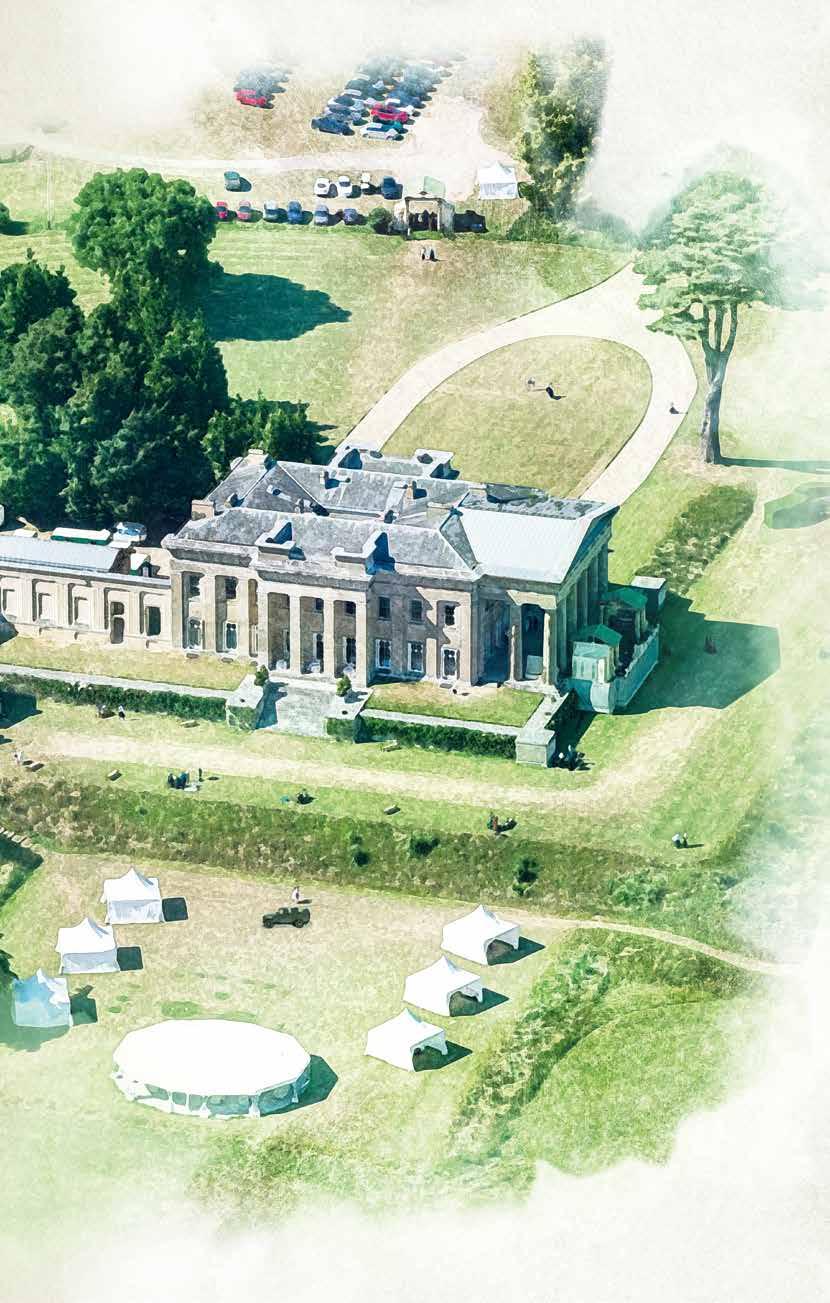
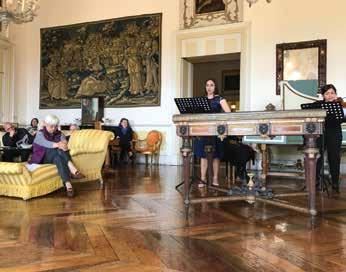

Our Grange Friends old and new have joined us for a wide range of entertaining events throughout the year. The family’s rooms at Hoare’s Bank, the Savile Club ballroom, Chelsea Arts Club and The Carlton Club have all hosted evenings where singers, directors and designers have entranced those present with their visions for the season. Informal and informative, these are the perfect way to prepare for the season and meet fellow music lovers.
New this year has been a series of sold-out private screenings of three of the most iconic opera films at Soho House Hotel – Joseph Losey’s Don Giovanni, Ingmar Bergman’s The Magic Flute and Franco Zeffirelli’s La traviata. Broadcaster Ed Seckerson, Editor of Opera John Allison and Sir Thomas Allen each introduced an evening and shared their knowledge of the opera, liberally laced with amusing anecdotes.

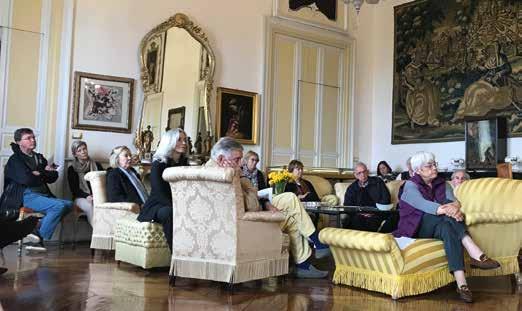
 Palermo
Palermo
We shall be back with more screenings this autumn and next spring, including Ed Seckerson interviewing operatic luminaries, and personal presentations of his own mesmerising films about composers by Tony Palmer. Our thanks to Bill Colegrave for sowing the seed of this idea and helping to make the evenings such a success.



In April a group of 30 travelled to Palermo on a tour seamlessly organised by Julia Boadle of ArtsAbroad. The five full days included private concerts, visits to Palermo’s many glorious historic treasures and the privilege of being entertained in some historic private palazzi. We even enjoyed a sumptuous lunch at I Pupi, the Bagheria harbour restaurant featured in Stanley Tucci’s recent BBC series. We were left with a host of wonderful memories of a special few days in this city rich with history and culture.
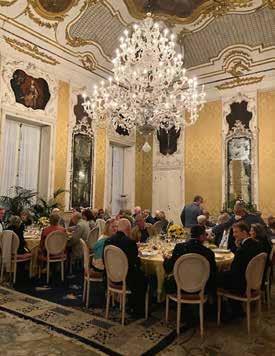

Our thoughts are now turning to autumn 2023… Athens looms.

 Rachel Pearson Director of Development
Sicily Tour, 2–7 April
Rachel Pearson Director of Development
Sicily Tour, 2–7 April






The country. But not as you know it. Try laidback luxury for size at Lime Wood.

